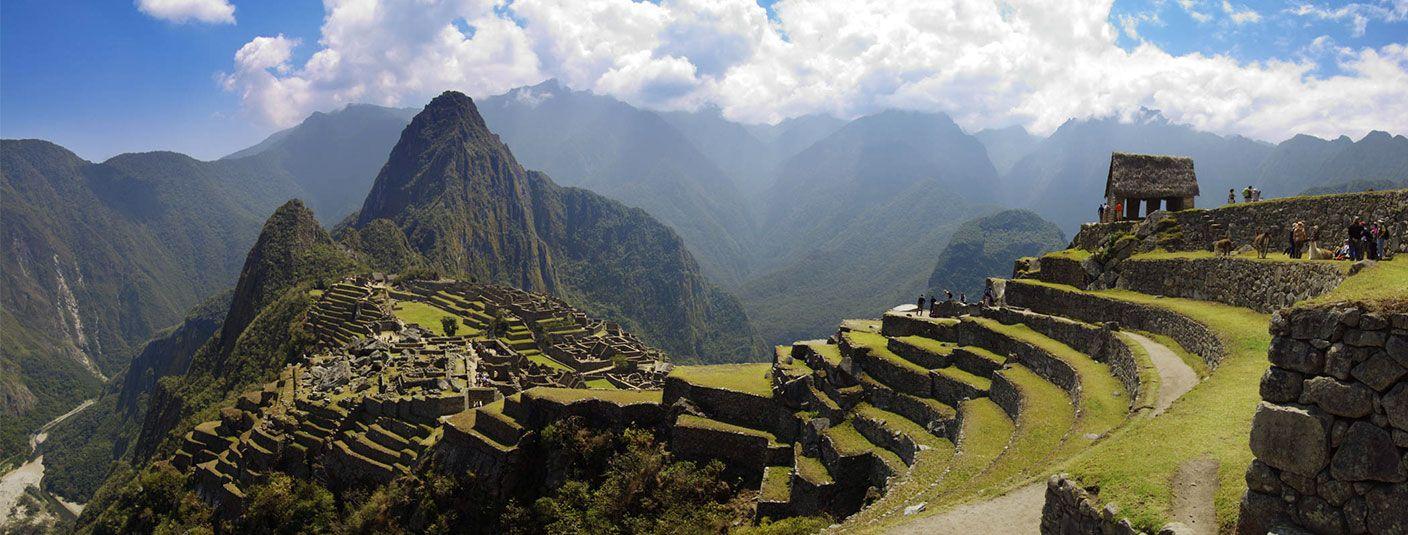

Machu Picchu
Machu Picchu is the Lost City of the Incas and inspires awe at first sight, especially if you journey there on the Inca Trail . Browse our destination guide below for essential travel details and top attractions to check out on your visit.
Only a few places in the world possess the kind of natural beauty and historic charisma that can capture the hearts and minds of visitors in an instant. Machu Picchu is one of them. Morning or afternoon, rain or shine, crowded or not - the sight of the stone temples and endless terraces set amid green-clad granite mountains never disappoints.
Forgotten after the fall of the Inca Empire and rediscovered 400 years later, Machu Picchu remains shrouded in mystery. Some questions may never be answered, but the former Inca city remains as irrefutable evidence of their highly advanced stonemasonry.
Whether by train or on your own two feet along the Inca Trail, getting to Machu Picchu is part of the adventure. Most visitors spend at least one night in Aguas Calientes, the small town at the base of the mountain from the Inca ruins. We recommend exploring the UNESCO Historic Sanctuary of Machu Picchu and New World Wonder with an expert guide, so you don’t overlook the brilliant engineering features and asserted significance built into the design of sacred temples.
Climate & Weather
Machu Picchu is at the intersection of the Andes and the Amazon, where the mild subtropical climate has warm days and cooler nights. Humidity is also higher than in Cusco and the Sacred Valley.
Rainy Season Weather at Machu Picchu changes quickly and is unpredictable throughout the year. Similar to other high altitude destinations in Peru, the region has a dry and rainy season, but these conditions changes in the weather aren’t as clearly defined. The dry winter season for Machu Picchu is from April to October, and the wet summer season is from November to March. Remember, the northern and southern hemispheres experience opposite seasons.
Best Time to Visit
- The peak season for Machu Picchu is June, July, and August. These months coincide with the region’s dry season when sunny conditions are most probable and considered by many the best time to go to Machu Picchu. Hotels, entry tickets, and other services fill up quickly, so make your reservations well in advance.
- The low season for Machu Picchu is from December to February during the rainy season. There are fewer tourists and less crowding around attractions within the citadel. Still, the tradeoff is a much higher probability for rain, so don’t forget your raingear.
Geography & Map
- Machu Picchu is located 50 miles (80 kilometers) northwest of Cusco in the Urubamba Province of Peru, where the eastern slopes of the Andes meet the Amazon Rainforest. The Inca built their city on a high mountain ridge overlooking the lush cloud forest surroundings. Far below, Urubamba River flows along the valley floor, past Aguas Calientes.
- Elevation 7,970 ft (2,430 m)
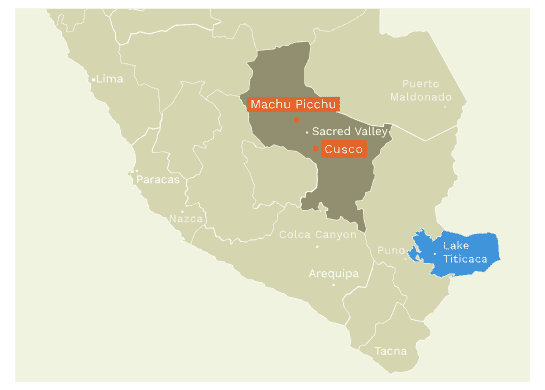
Construction for Machu Picchu began at the height of the Inca Empire around 1450 AD. Most scholars agree the mountaintop city was the royal estate of Pachacutec, the powerful 9th king. Others speculate it was a sacred center where the great political, religious, and economic minds of the Inca Empire gathered.
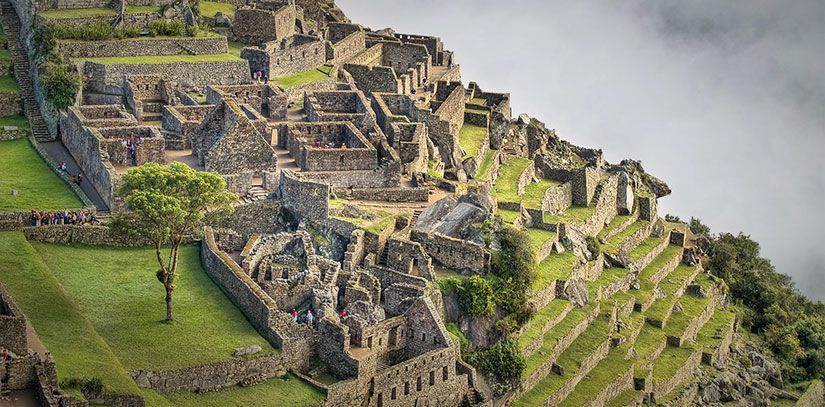
Before the construction of Machu Picchu began, they surveyed the mountaintop site. They built canals to carry freshwater to different sectors of the city. Incredibly, the Inca didn’t use steel or iron tools, nor the wheel, to make the temples, living quarters, and stone steps. Instead, they utilized simple materials such as stone, wood, and bronze. Rows of terraces were also constructed along the mountainsides for support. Without them, Machu Picchu would have tumbled down, unable to withstand centuries existing in a region prone to earthquakes and annual heavy rain.
Less than one hundred years after the construction of Machu Picchu began, during the 1530s, the city was abandoned in the aftermath of the Spanish Conquest. Widespread knowledge of the city was lost to official memory over the centuries except for some locals.
In 1911, Yale history professor Hiram Bingham chanced upon Machu Picchu while looking for the legendary city of Vilcabamba where resistance rebel leader Manco Inca retreated to safety from Spanish troops. After years of silent existence, Machu Picchu had been rediscovered and was flung into the international spotlight.
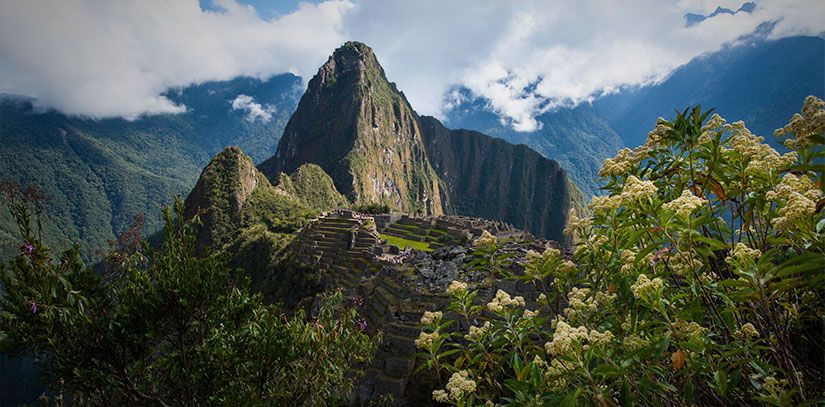
Today, Machu Picchu is a UNESCO World Heritage Sanctuary and the most visited attraction in Peru. The Ministry of Foreign Trade and Tourism counted 800,200 visitors to Machu Picchu in 2007, when the attraction was named one of the New Seven Wonders of the World, and since then that number has nearly doubled. In 2019, the famous Inca ruins were visited by 1,585,300 people from around the world.
How to Get to Machu Picchu
Machu Picchu is in a remote region of Peru, and transportation there is limited. No roads connect Cusco and the Sacred Valley with Aguas Calientes, so your only two options are to take the train or trek there.
Train to Machu Picchu
Most travelers choose to take the train to Machu Picchu for the convenience of time and comfort. PeruRail offers different train services - from budget Vistadome, upgrade Expedition, and luxury Hiram Bingham - with several daily morning and evening departures.
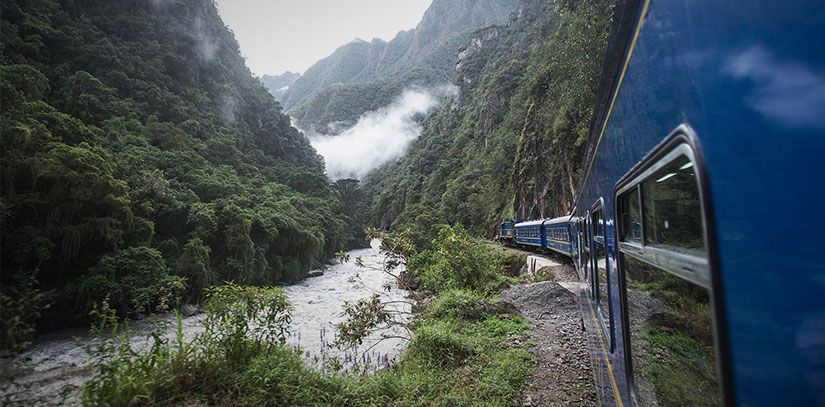
Passengers can board the train in Cusco at the Poroy Station (a 20-minute taxi ride from the city plaza) or in the Sacred Valley at the train station in Ollantaytambo and then continue along the tracks to Aguas Calientes. Upon arrival at Machu Picchu Station, the final leg of your journey is a 20-minute shuttle bus (ticket required) or uphill walk to the main entrance of Machu Picchu.
- The train from Cusco to Machu Picchu is 4 hours
- The train from Ollantaytambo to Machu Picchu is 2 hours
- The train from Urubamba to Machu Picchu is 3 hours (*limited weekly departures)
You have to travel light when you take the train to Machu Picchu because storage room onboard is limited. Each passenger is only allowed one carry-on luggage that weighs no more than 11 lbs (5kg). Many hotels in Cusco and the Sacred Valley offer free luggage storage, where you can leave a separate bag filled with belongings you won’t need for this leg of your trip.
Aguas Calientes to Machu Picchu
Aguas Calientes town is located 5.5 mi (9 km) from the Machu Picchu archeological site and 1,310 ft (400 m) of altitude lower. From the bus stop located only 3 to 5 minutes walking from the train station in Aguas Calientes, buses ferry passengers between the town and the ruins, using a zigzagging switchback road to go up and down the steep mountainside. Most tours to Machu Picchu include the bus tickets in the total price of the package. Tickets for the bus can also be purchased in Cusco or in Aguas Calientes in front of the bus stop.
The first buses depart at 5:30 am, arriving at the entrance of Machu Picchu just before the gates open at 6:00 am. Lines are usually the longest in the morning between 5:30 am and 6:15 am and when the mid-morning trains arrive from Cusco and the Sacred Valley between 9:00 am to 10:00 am.
Trekking to Machu Picchu
Adventurous travelers should trek to Machu Picchu! Trekking packages are organized so you trek to the famous archaeological site and return by train on the return leg of your journey.
The iconic 4-day Inca Trail to Machu Picchu is the most popular trek in South America. The journey takes you through high Andean passes, past lesser-known Inca sites, and culminates with a memorable entrance to Machu Picchu through the Sun Gate. There’s also the 2-day Inca Trail if you are on a tight schedule or prefer a less demanding walk.
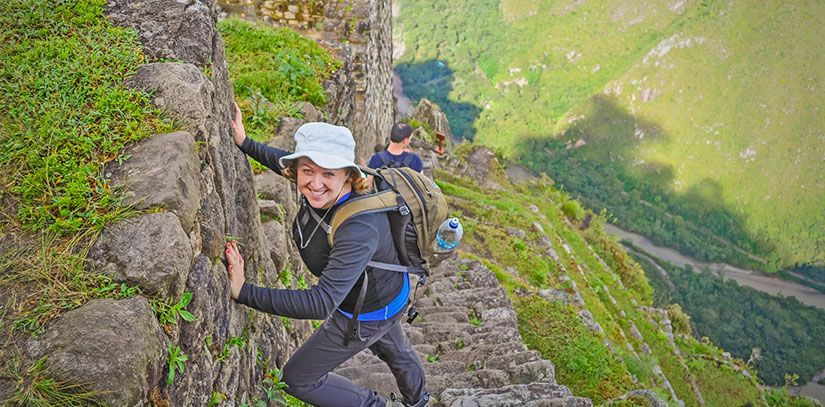
To hike the Inca Trail, you must reserve a permit in advance. There are wonderful alternative treks to Machu Picchu that don’t require a permit if Inca Trail permits are already sold out.
The 5-day Salkantay Trek is an excellent alternative trek to Machu Picchu for travelers who appreciate nature. This Andean trail passes by the imposing snow-capped Salkantay mountain, for which the trek is named, and crosses highland pampas before dropping down into a river valley cloud forest and then onto Machu Picchu. Read more about the Salkantay Trek.
The 4-day Lares Trek is another alternative recommended for trekkers whose interest lies in cultural immersion. Follow a route through the Lares Valley, passing remote villages with rich Andean traditions, beautiful mountain scenery, and lesser-known Inca ruins before touring Machu Picchu on the final day. Read more about the Lares Trek.
Visitor Guidelines
Machu Picchu Tickets
Tickets to Machu Picchu are limited and must be purchased in advance. There are general entry tickets and ones that include the hikes for Huayna Picchu (only 400 daily available) or Machu Picchu Mountain (only 400 daily available). Demand for Huayna Picchu and Machu Picchu Mountain is especially high during the peak June, July, and August dates. Advanced planning - sometimes 4 months in advance - is a must. Reserve your spot at the time you book your Machu Picchu tickets.
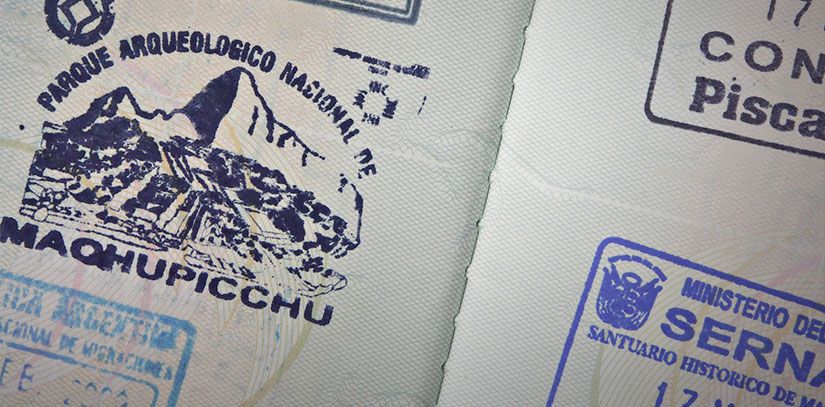
Tickets are not sold at the main entrance. If you’ve waited until the last minute, your final opportunity is at the National Cultural Institute (INC) office on the main plaza in Aguas Calientes.
Time in Machu Picchu
The time designated for you to enter Machu Picchu is selected when you buy your tickets in advance. For whichever assigned time indicated on your ticket, you have the full hour to enter the archaeological site. We suggest you arrive at the bus stop in Aguas Calientes at least one hour before your entrance time at the Machu Picchu ruins.
- An entry ticket to Machu Picchu is valid for 4 hours.
- An entry with a Huayna Picchu ticket gives you 6 hours to go on a Machu Picchu tour and do the hike.
- An entry with Machu Picchu Mountain ticket gives you 7 hours to take a guided tour and do the hike. This hike is longer than Huayna Picchu hence why you have more time in Machu Picchu.
Walking circuits around Machu Picchu help control foot traffic. Routes 1 and 2 (indicated in green and red on the map) pass similar attractions but explore different sections of the agricultural zone near the main entrance gate. Route 3 in blue is an alternative walking route so visitors with hiking permits can do Huayna Picchu or Machu Picchu Mountain.

Travel Tips
What to Bring to Machu Picchu
Here is an essential Machu Picchu packing list:
- Passport and Entry Ticket You need to present both documents at the entrance gate. Bring your original passport.
- Daypack Only small backpacks can be brought into Machu Picchu.
- Water Fill up your reusable water canteen or buy bottled water to bring in your daypack to stay hydrated as you walk around Machu Picchu, especially if you do the Huayna Picchu or Machu Picchu Mountain hikes.
- Clothing Weather changes quickly at Machu Picchu, so it is best to dress in layers so you can add or remove layers as needed. Cloudy conditions quickly turn sunny and vice versa.
- Sun Protection The sun is very strong at Machu Picchu’s high elevation, especially from June to August during the peak of the dry season. Bring sunglasses, sunblock, and a hat.
- Rain Protection During the wet season from November to March, pack a rain poncho or travel-size umbrella in your daypack to be prepared for any unexpected showers.
- Footwear Comfortable hiking boots or athletic shoes with good traction are best for walking around the stone steps at Machu Picchu.
- Camera A camera with a zoom lense gives you more flexibility to capitalize on different angles and capture stone ruins far away.
- Hiking Poles Make sure your hiking poles have protective rubber tips if you want to bring them to Machu Picchu.
What NOT to Bring to Machu Picchu
- Camera tripods, selfie sticks, and drones are not allowed inside Machu Picchu.
- Luggage and large backpacks are not allowed. Many hotels offer complimentary luggage storage. There are also storage lockers at the entrance of Machu Picchu.
- Alcohol is not allowed.
- Baby strollers are not practical with all the stairs at Machu Picchu. Instead, a baby backpack style carrier is recommended.
- Metal-tipped canes and walking poles are only allowed inside Machu Picchu with protective rubber tips.
Safety Tips
Aguas Calientes isn’t known for crime (it is virtually non-existent in Machu Picchu), but travelers should always remain wary of petty theft. This particularly applies when in large crowds of people such as at the train station where pickpocketing can go unperceived by the victim. Never leave bags or other valuable items unattended.
Local Currency & ATMs
From bottles of water to meals at restaurants, prices for food, goods, and services are a bit higher in Aguas Calientes compared to anywhere else in Peru. This is because tourism is the town’s only industry and everything has to be shipped by train. Be sure to budget accordingly. There are ATMs on the major streets, but these are known to be unreliable. Most hotels and restaurants accept major credit cards. There are no ATM machines at Machu Picchu. Read about money in Peru.
Most hotel representatives in Aguas Calientes and staff aboard the train to Machu Picchu speak Spanish and English. Tours are conducted in many languages. All Peru
Things to Do
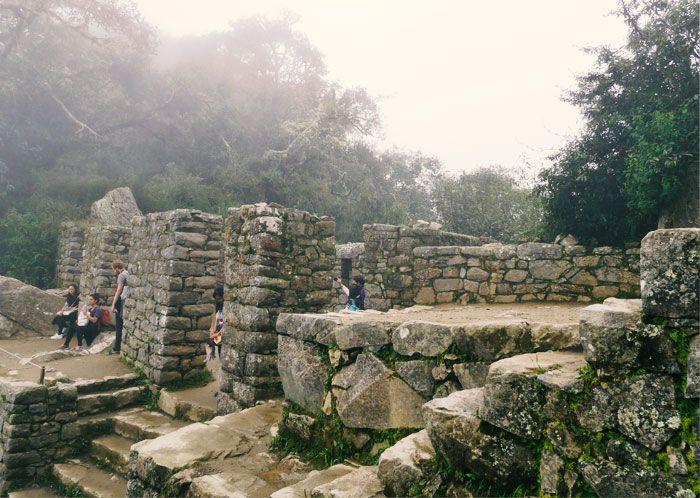
Huayna Picchu
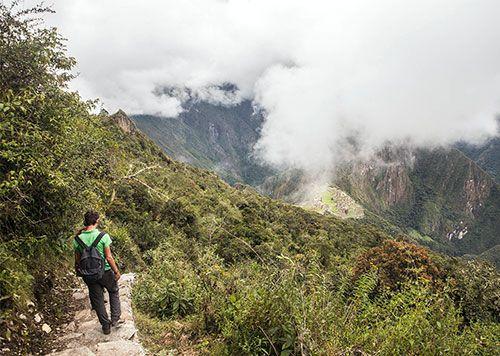
Machu Picchu Mountain
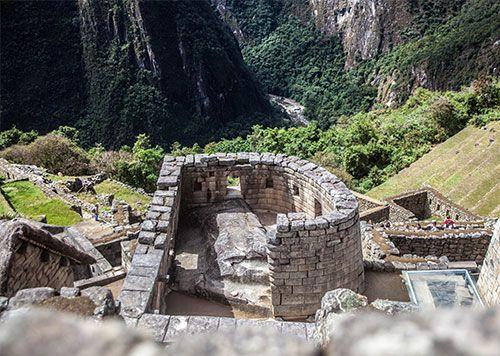
Temple of the Sun
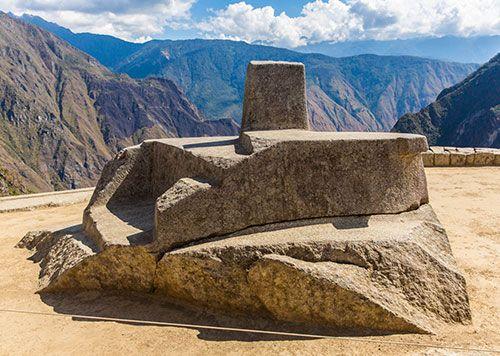
Intihuatana
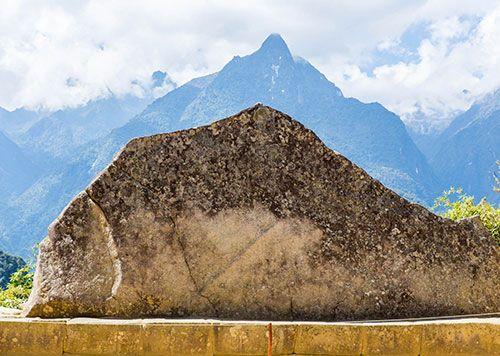
Sacred Rock
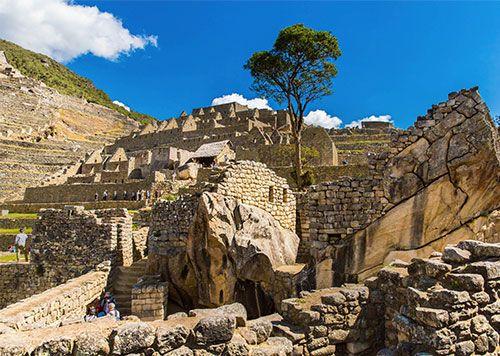
Temple of the Condor
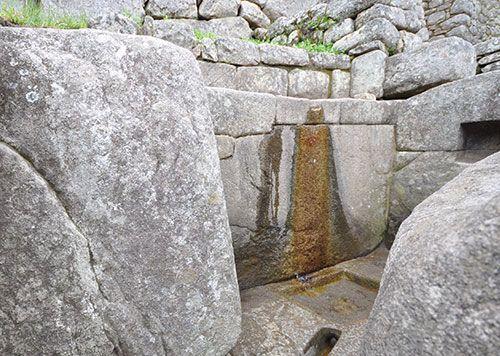
Stairway of Fountains
Options for Machu Picchu hotels range from 5-star luxury resorts to budget dorms and everything in between. Machu Picchu Sanctuary Lodge is the only hotel up on the mountain next to the main entrance of the archaeological complex. All other accommodations are in Aguas Calientes and walking distance from the train station.
It’s possible to make a whirlwind Machu Picchu trip in one day. Still, we recommend enjoying this highlight of your trip at a slower pace, if possible. Staying a night or two in Aguas Calientes spaces out the legs of transport to and from Machu Picchu and helps you stay rested for an active day of touring. The following are our Top Pick Hotels for travel to Machu Picchu.
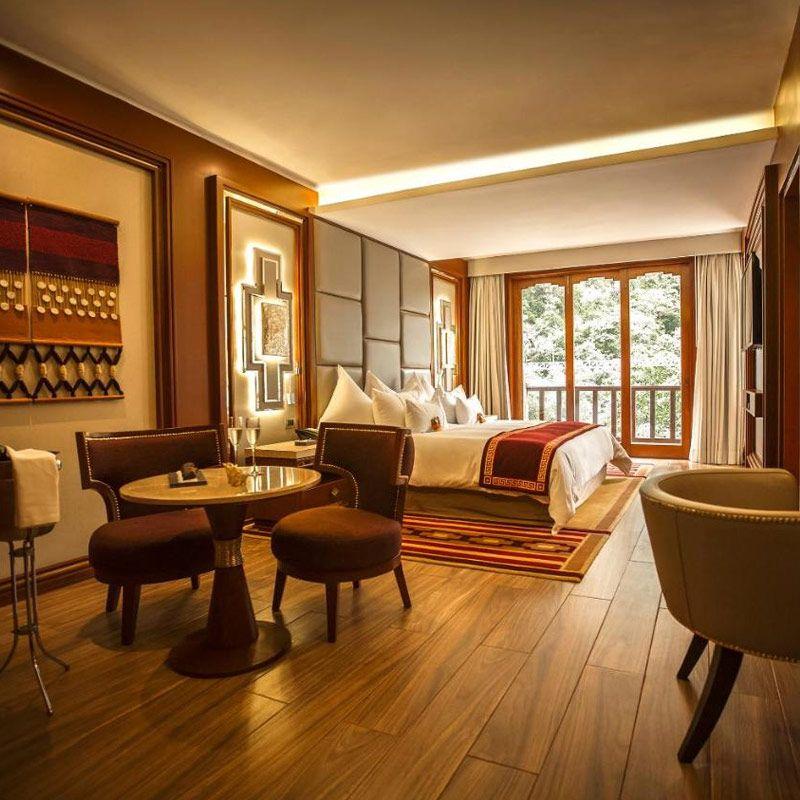
Sumaq Machu Picchu
Avenida Hermanos Ayar Mz 1 Lote 3, Aguas Calientes, Machu Picchu
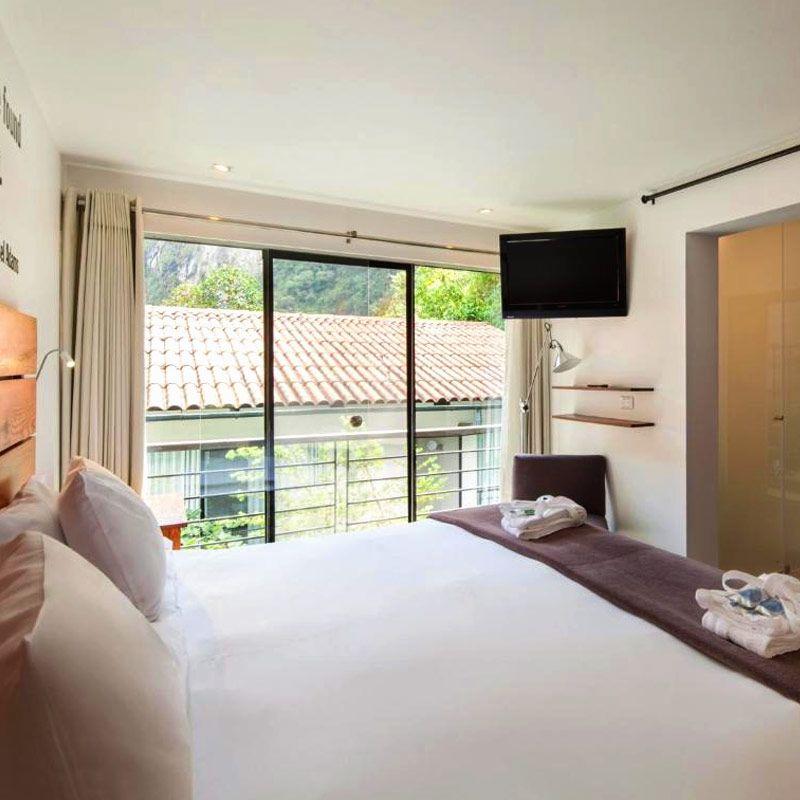
Av. Pachacutec 109, Aguas Calientes, Machu Picchu
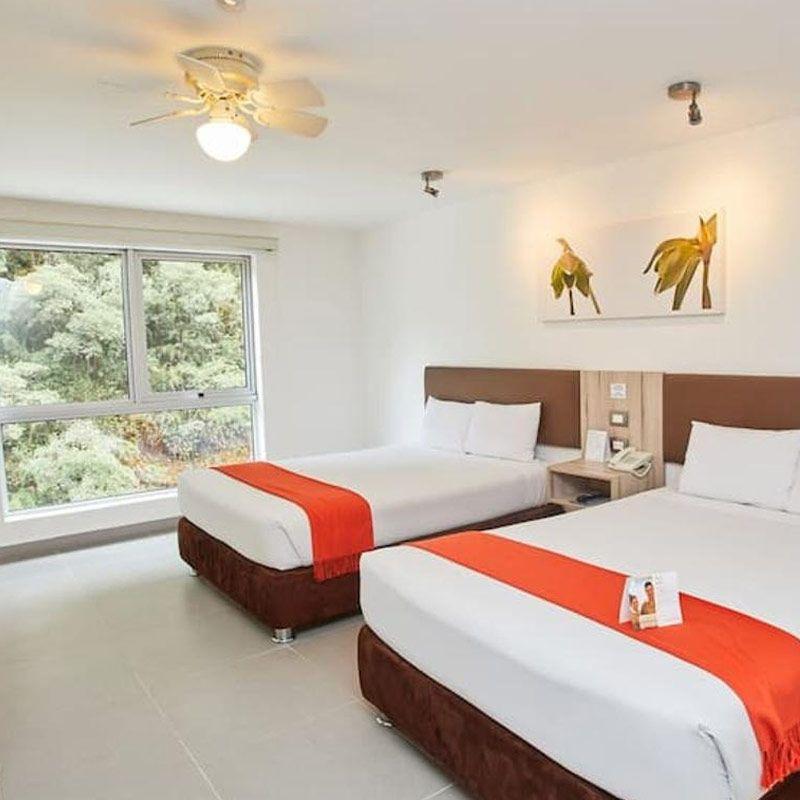
Casa Andina Standard Machu Picchu
Prolongacion Imperio de Los Incas E - 34, Aguas Calientes, Machu Picchu
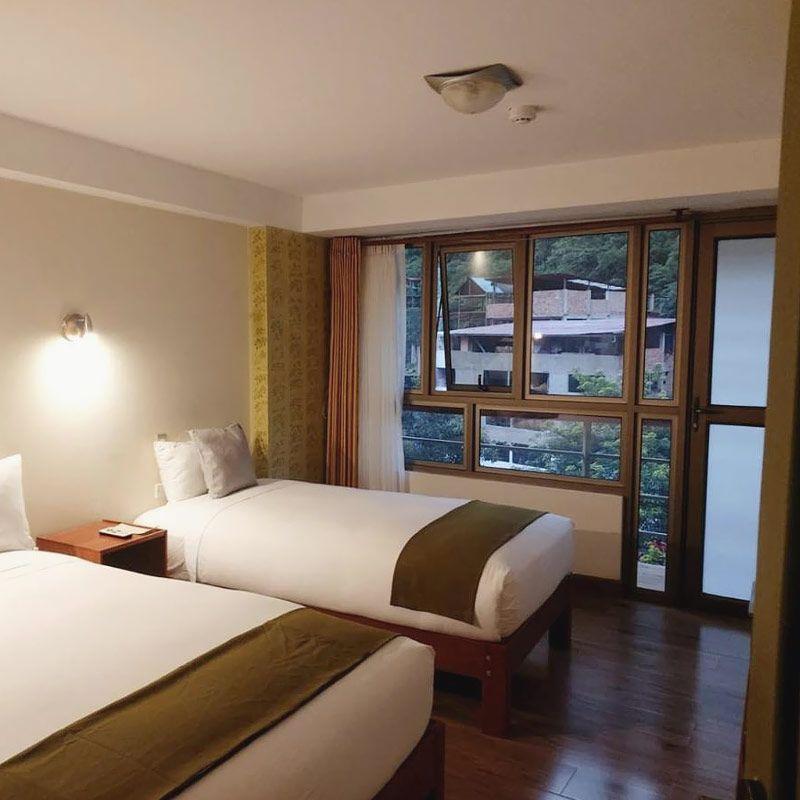
Pucara Hotel
Alameda los Artesanos 1508, Machu Picchu
Restaurants
Eating options outside the entrance to Machu Picchu are convenient, though limited. You can take a pre-made box lunch with you to Machu Picchu (available options depend on your itinerary), eat a buffet lunch at Belmond Sanctuary Lodge, or grab a quick bite at the Machu Picchu Snack Bar.
Down the hill in Aguas Calientes the restaurant selection is far more varied. Enjoy a casual sitdown meal in Machu Picchu’s gateway town at one of the following restaurants:
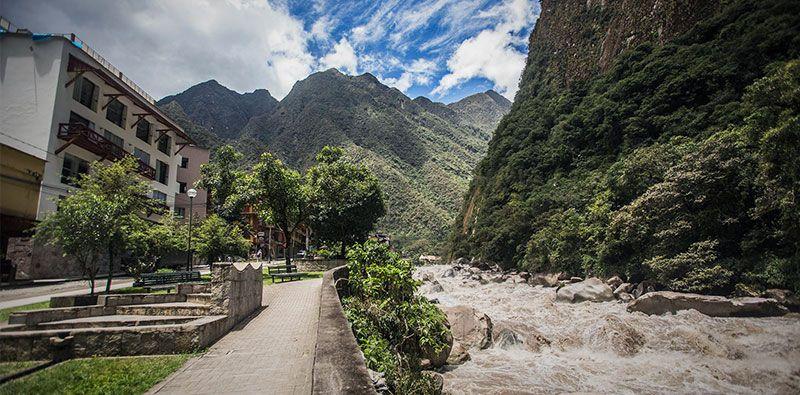
Chullpi Machu Picchu
Incontri del pueblo viejo, indio feliz restaurant bistro, the tree house restaurant, toto’s house, tour packages.
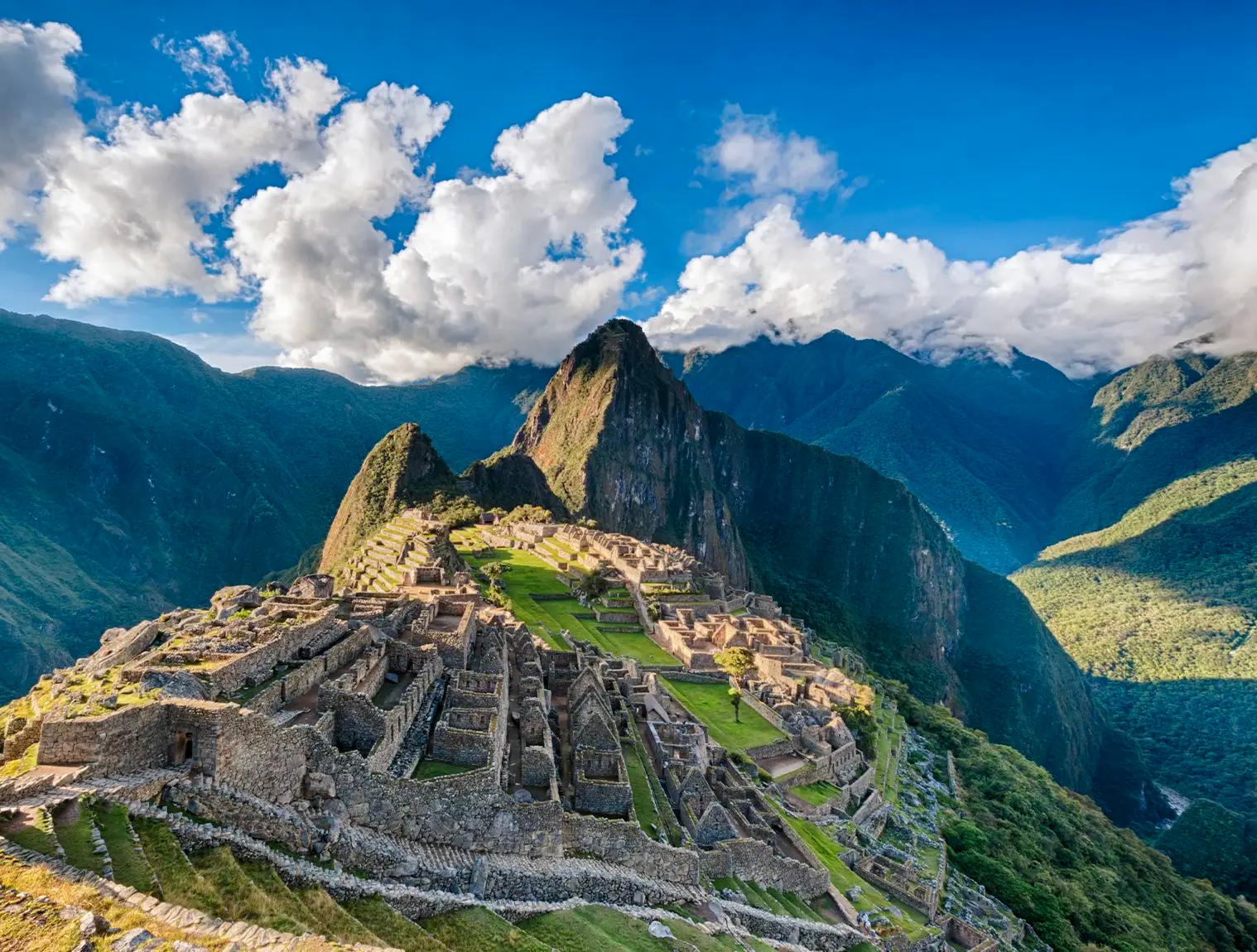
6 days from $ 1249
Cusco, Sacred Valley and Machu Picchu
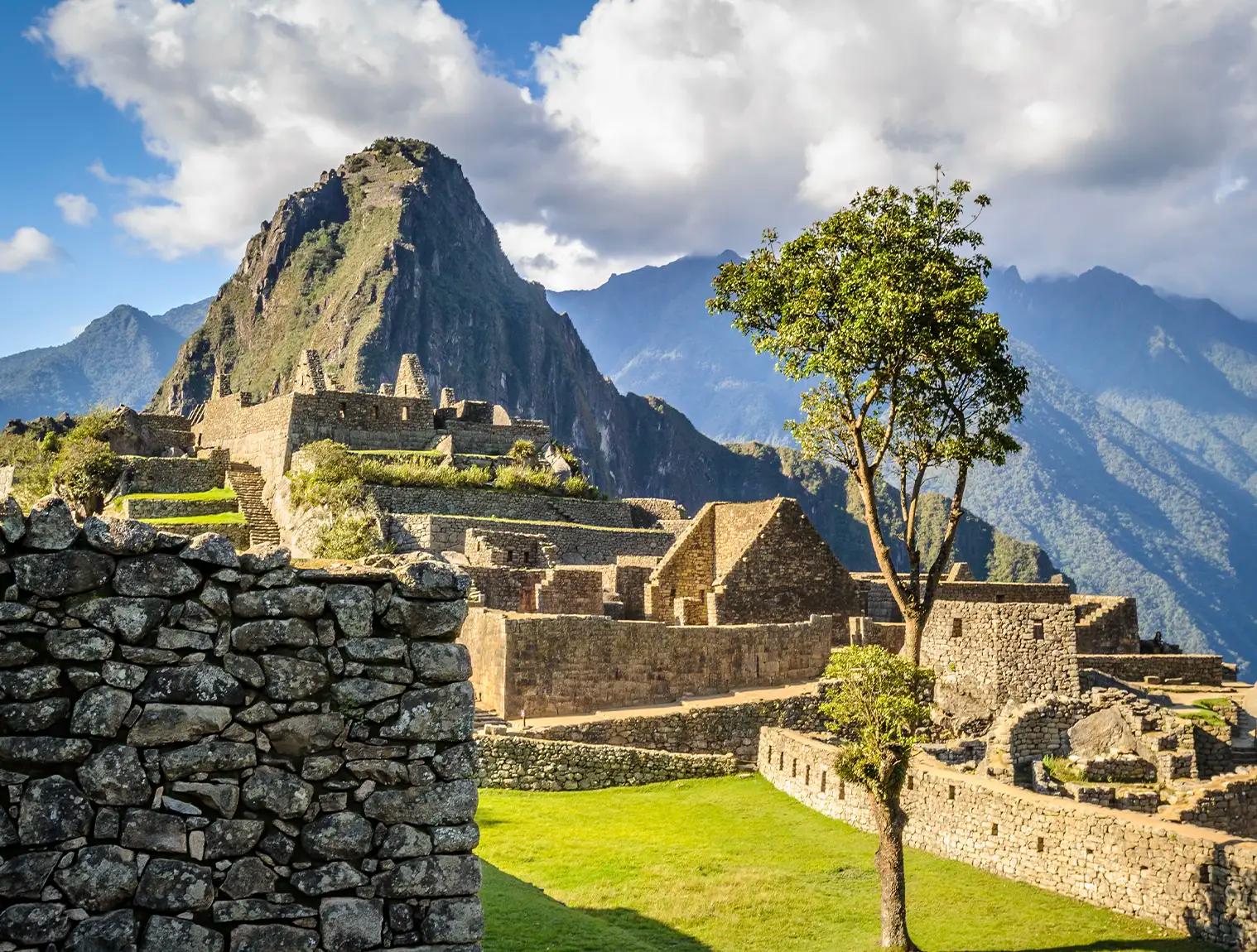
4 days from $ 989
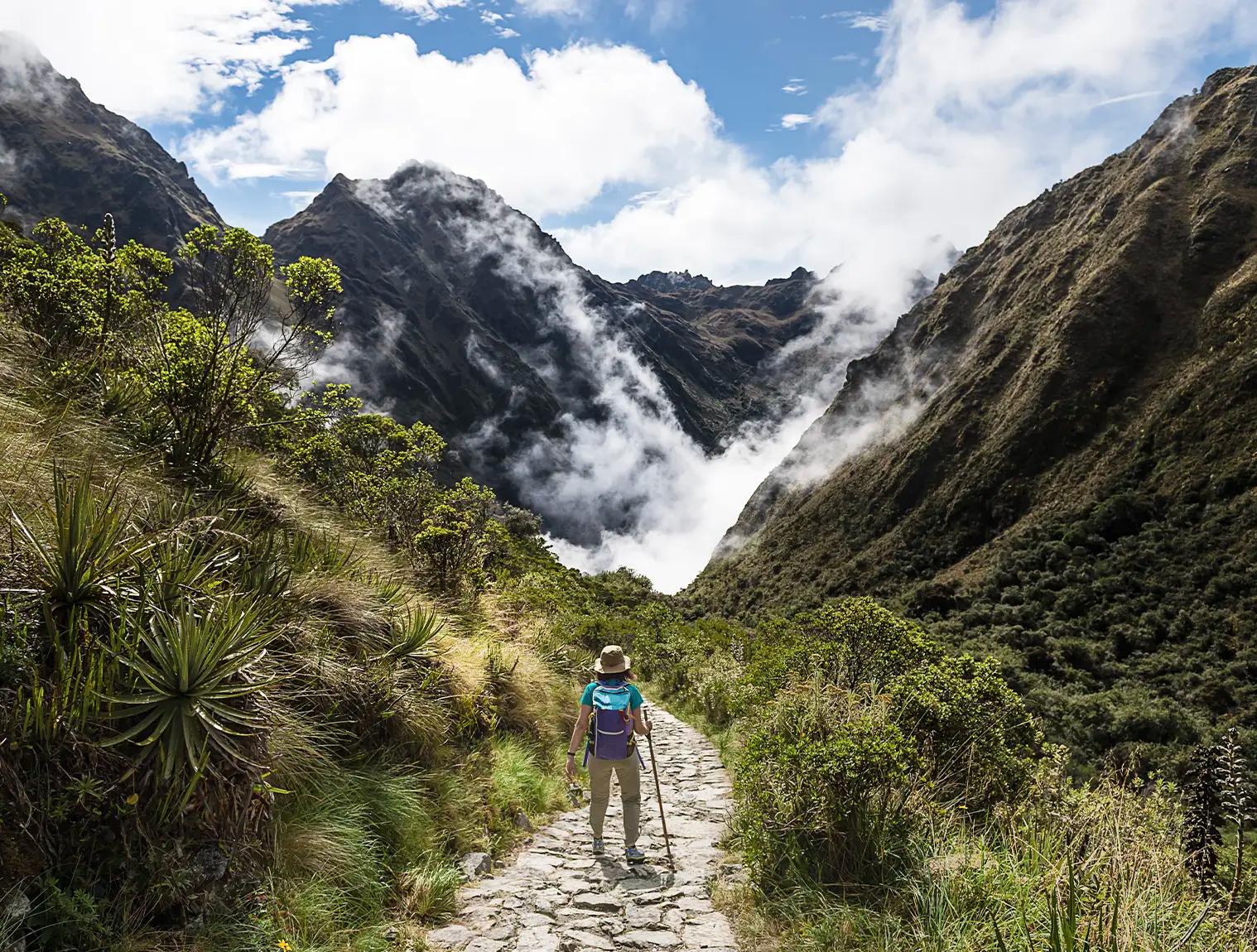
9 days from $ 2069
Cusco, Inca Trail, Sacred Valley & Machu Picchu
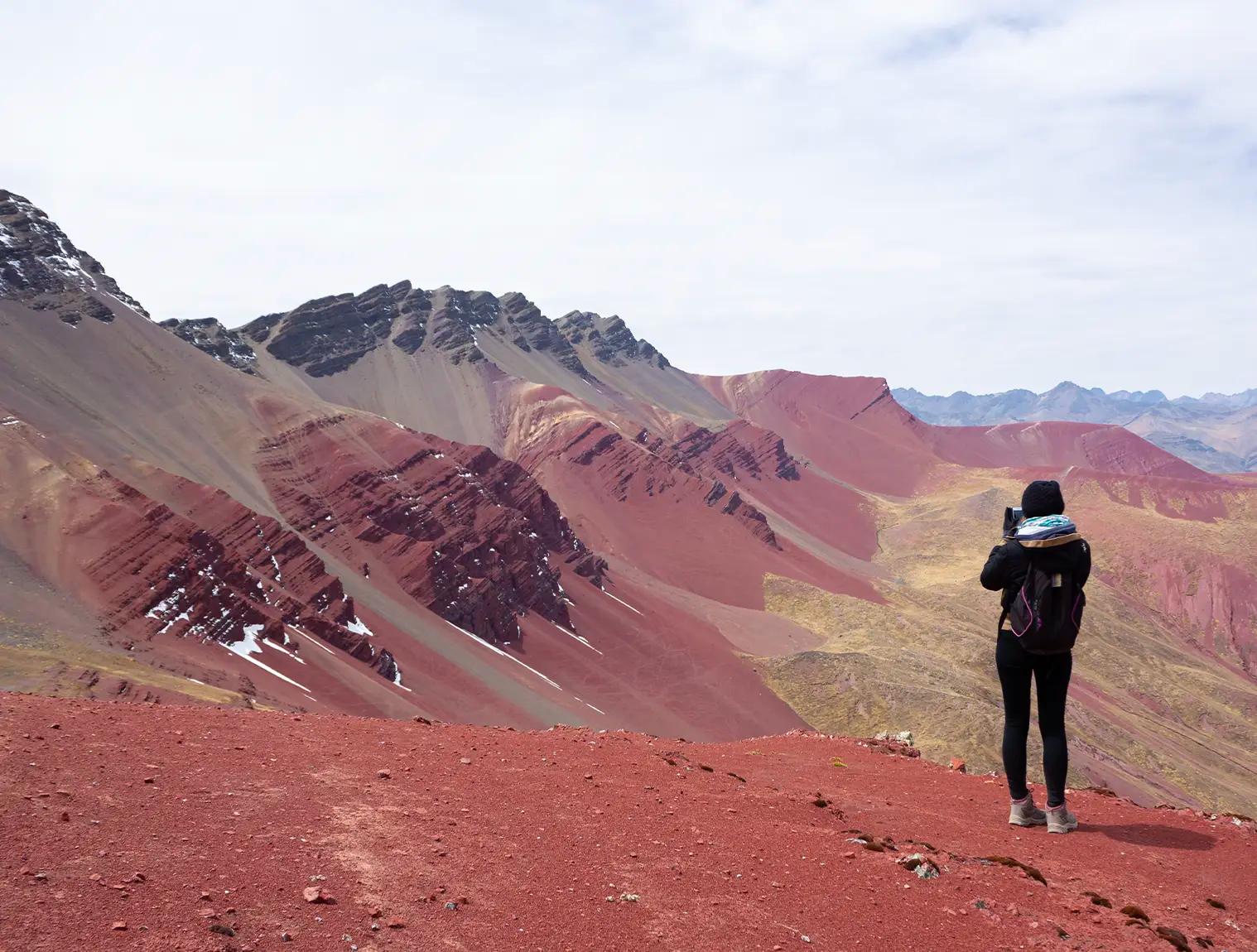
6 days from $ 1759
Cusco, Rainbow Mountain, Machu Picchu & 2-day Inca Trail
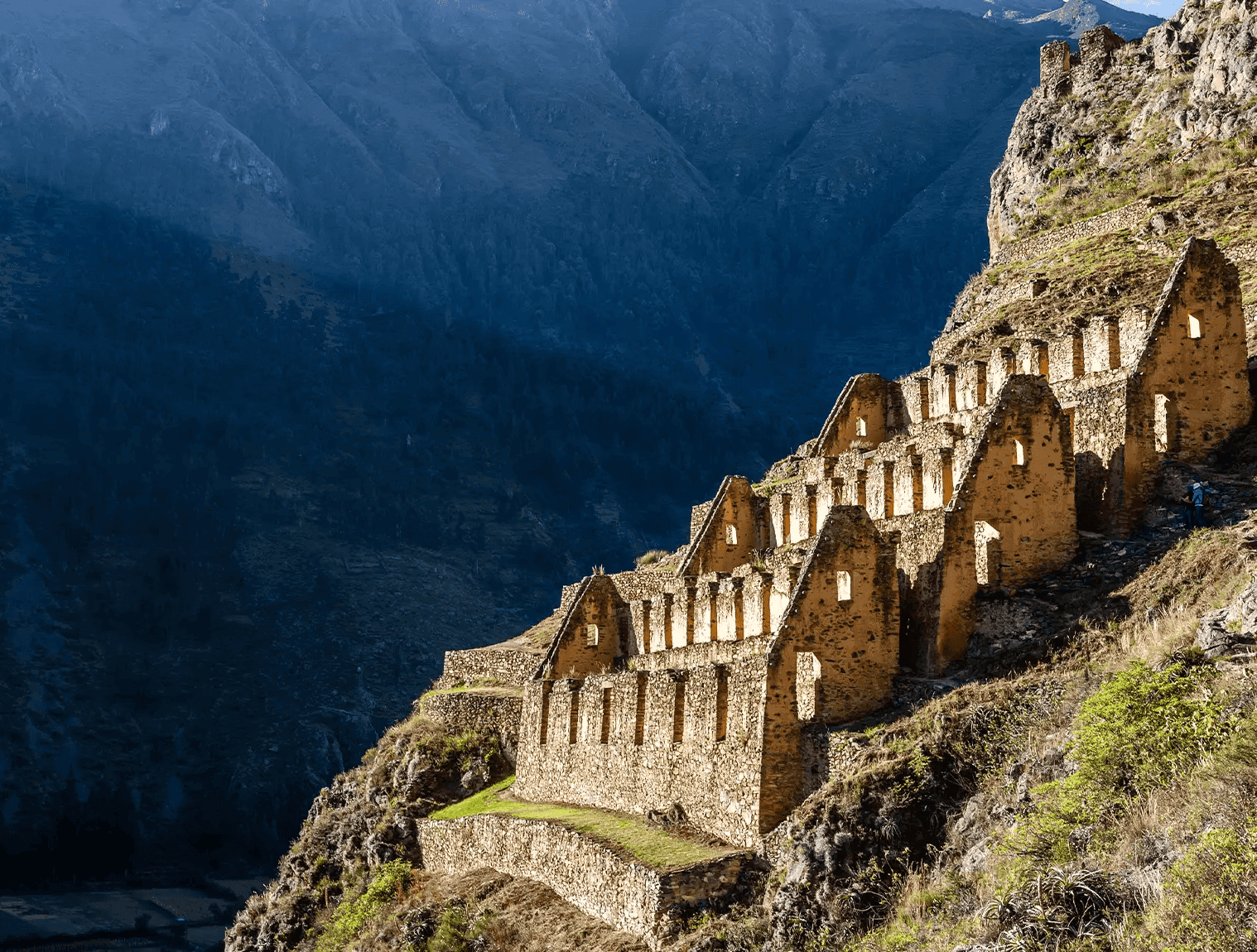
16 days from $ 3869
Machu Picchu, Cusco, Titicaca, Amazon, Lima, Paracas, Arequipa & Colca
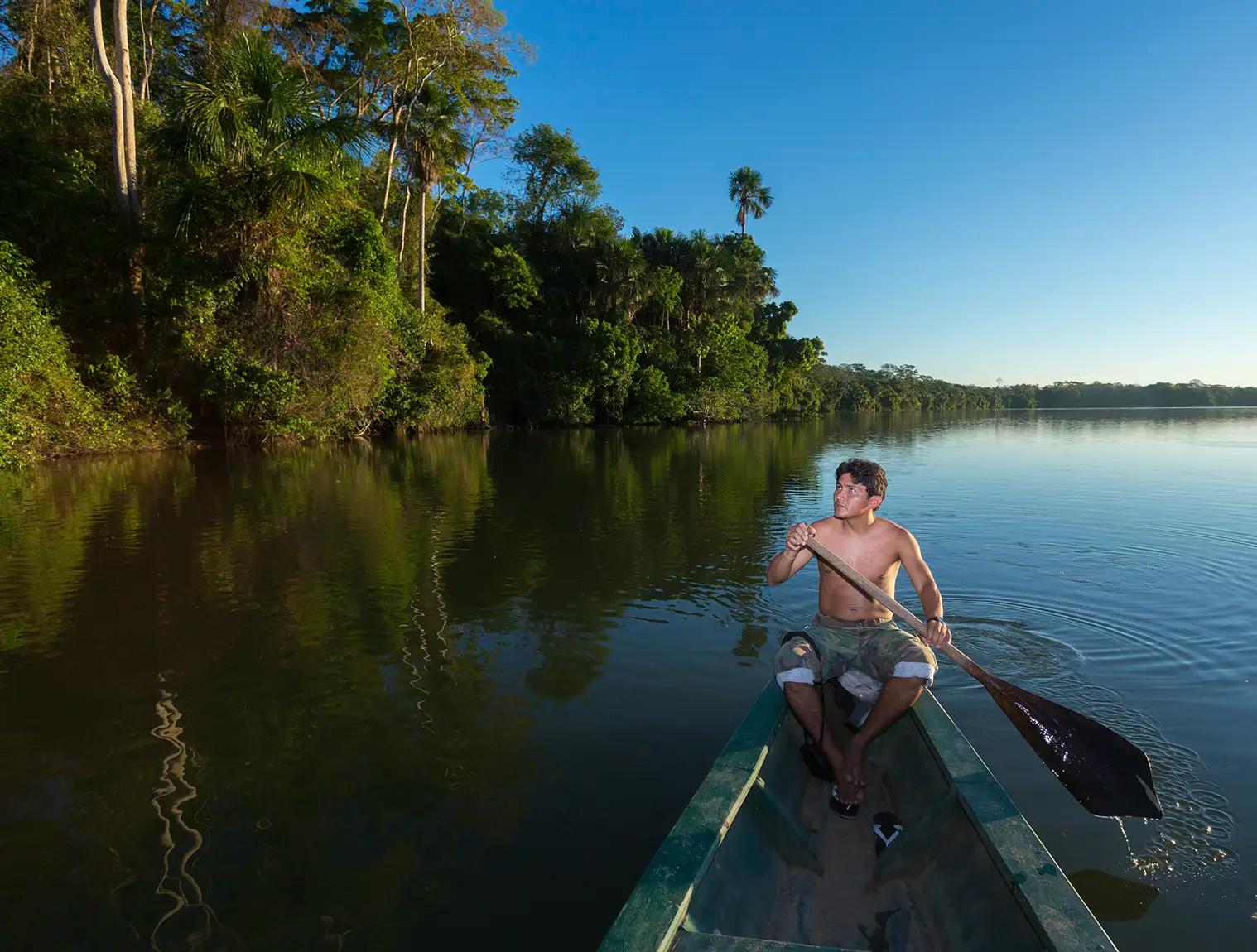
9 days from $ 1919
Amazon, Cusco, Sacred Valley and Machu Picchu
Where is Machu Picchu?
What is the best time to go to machu picchu, what is the elevation of machu picchu, can i get altitude sickness at machu picchu, how much time do i need at machu picchu, is a guide required for machu picchu, how old is machu picchu, when was machu picchu discovered, how many tourists visit machu picchu, where are the bathrooms at machu picchu, can i stay overnight at machu picchu, what is there to do in aguas calientes besides visit machu picchu.

Book With Confidence
We're flexible! Postpone your tour with zero cost up to 10 days prior to departure.
Email: [email protected]
Sign up to receive our newsletter for great articles, stunning photos, and special deals.
1-817-230-4971
Sales & travel support

©Bérenger Zyla/500px
Machu Picchu
Shrouded by mist and surrounded by lush vegetation and steep escarpments, the sprawling Inca citadel of Machu Picchu lives up to every expectation. In a spectacular location, it’s the most famous archaeological site on the continent, a must for all visitors to Peru. Like the Mona Lisa or the pyramids, it has been seared into our collective consciousness, though nothing can diminish the thrill of being here. This awe-inspiring ancient city was never revealed to the Spanish colonizers and was virtually forgotten until the early part of the 20th century.
Attractions
Must-see attractions.

The Inca Trail ends after its final descent from the notch in the horizon called Intipunku (Sun Gate). Looking at the hill behind you as you enter the…

Intihuatana
This Quechua word loosely translates as the ‘Hitching Post of the Sun’ and refers to the carved rock pillar, often mistakenly called a sundial, at the top…

Behind and connected to the Principal Temple lies this famous small building. It has many well-carved niches, perhaps used for the storage of ceremonial…

Hut of the Caretaker of the Funerary Rock
An excellent viewpoint to take in the whole site. It’s one of a few buildings that has been restored with a thatched roof, making it a good shelter in the…

Principal Temple
The ‘temple’ derives its name from the massive solidity and perfection of its construction. The damage to the rear right corner is the result of the…

Temple of the Sun
Just above and to the left of the ceremonial baths is Machu Picchu’s only round building, a curved and tapering tower of exceptional stonework. This…

Temple of the Three Windows
Important buildings flank the remaining three sides of the Sacred Plaza. The Temple of the Three Windows features huge trapezoidal windows that give the…

Inca Drawbridge
A scenic but level walk from the Hut of the Caretaker takes you right past the top of the terraces and out along a narrow, cliff-clinging trail to the…
Plan with a local
Experience the real Peru
Let a local expert craft your dream trip.
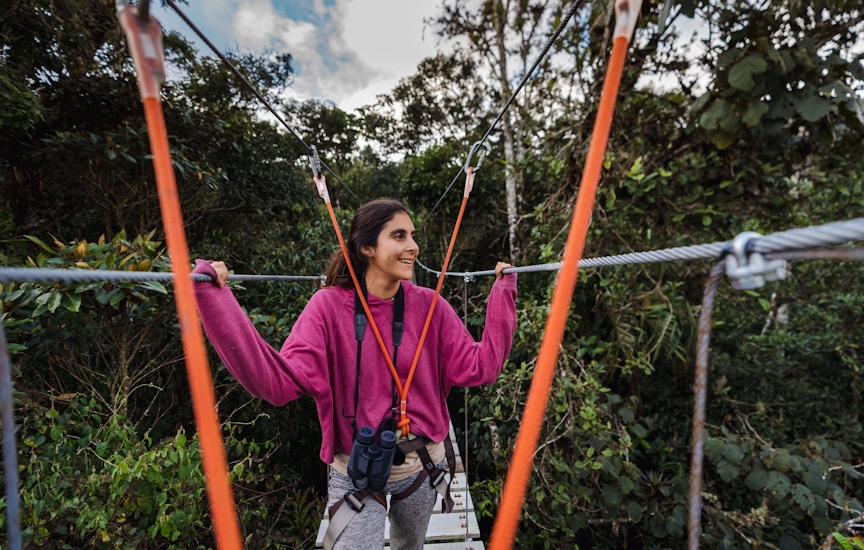
Latest stories from Machu Picchu
Filter by interest:
- All Interests
- Adventure Travel
- Art & Culture
- Beaches, Coasts & Islands
- Food & Drink

Jun 11, 2024 • 5 min read
Starting this month, Machu Picchu has introduced new circuits to preserve the archeological site. Here's how to find the right route for you.
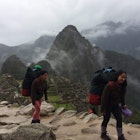
Mar 23, 2021 • 3 min read

Oct 15, 2020 • 2 min read

Sep 16, 2020 • 6 min read
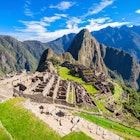
Feb 10, 2020 • 1 min read

Feb 6, 2020 • 3 min read

Jan 29, 2020 • 7 min read
Jan 22, 2020 • 1 min read

Oct 4, 2019 • 6 min read

Jun 28, 2019 • 5 min read
in partnership with getyourguide
Book popular activities in Machu Picchu
Machu Picchu Guide: How to Travel to Inca’s Lost City
There are many ancient ruins, many beautiful mountain hikes, many places that combine history and mystery in an intriguing blend—but none like Machu Picchu. Perched high in the Peruvian Andes, Machu Picchu is one attraction that lives up to, and beyond, its hype.
This Machu Picchu guide gives you a complete rundown on how to travel to Machu Picchu , how to plan your trip to see the Machu Picchu highlights, and other useful tips to make the most out of your adventure. Read on for the ultimate guide to the Lost City of Inca.
Where is Machu Picchu?
Machu Picchu is situated in south central Peru, a South American country with 5 bordering neighbors: Ecuador, Colombia, Brazil, Bolivia, and Chile.
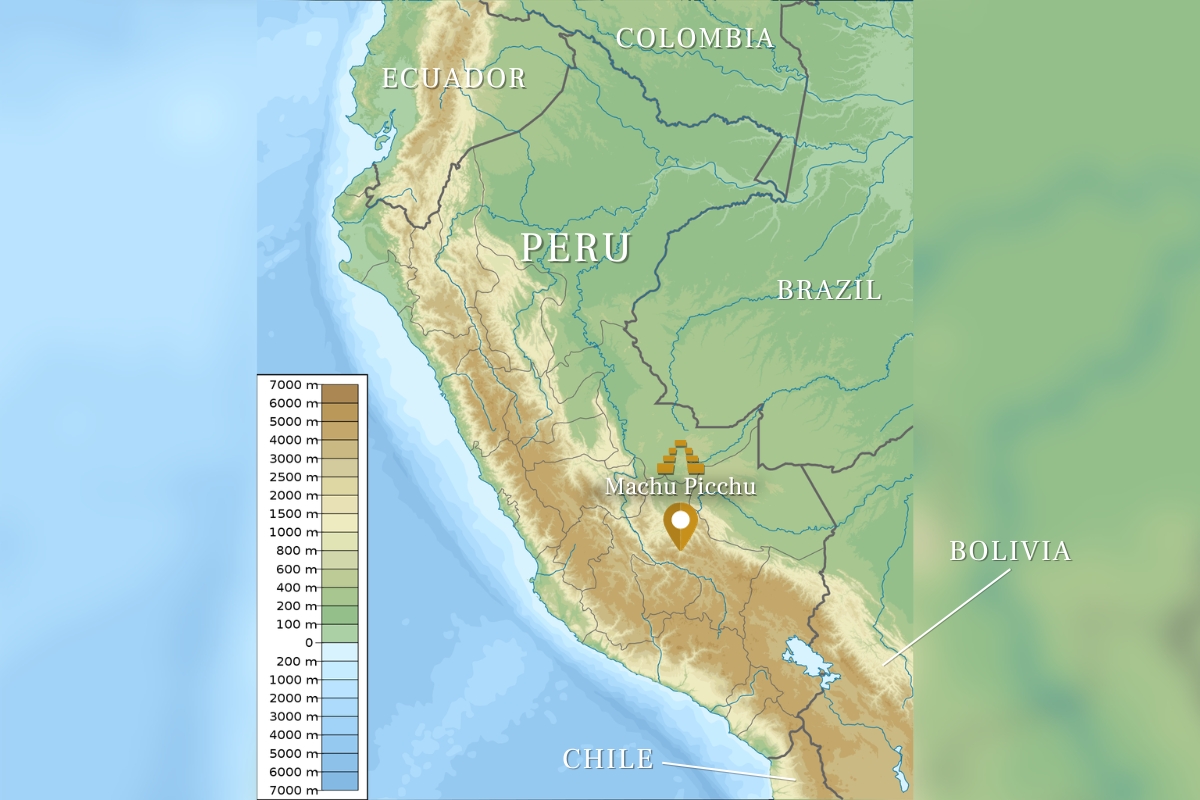
Most historians believe Machu Picchu’s mountainside construction began in the 1400s under the watchful eye of Inca ruler Pachacutec. The prevailing theory is that Machu Picchu was a royal retreat, a place where the Inca elite could relax and enjoy their lavish surroundings.
For this reason, Machu Picchu was placed far from other Inca cities and sites. It was so well isolated that the Spaniards—who conquered the Inca Empire and its Cusco capital in the 1530s—never knew Machu Picchu existed.
Machu Picchu Mountains and Altitude
Machu Picchu sits within the Cordillera de Vilcabamba, a small Andean range that runs for 160 miles and reaches 20,575 feet above sea level at its highest point. Machu Picchu, however, only hits 7,970 feet above sea level, a lower altitude than the city of Cusco.
The ruins are located between two main peaks: Machu Picchu and Huayna Picchu (also spelled Wayna Picchu).
This area of concentrated ruins covers only about 20 of the 80,310-acre Machu Picchu Historic Sanctuary, a UNESCO World Heritage site since 1983. Overlooking the Urubamba River, the Sanctuary’s ecosystem is influenced both by the Andes and the Amazon, creating a lush tropical mountain forest environment.
Due to Machu Picchu’s high elevation, altitude sickness can be a concern for visitors. To alleviate common symptoms such as fatigue and headache, SA Expeditions allows every traveler at least one day of acclimation upon arrival to Cusco. When acclimating to altitude, it’s important to stay well-hydrated, have enough rest, and avoid alcohol and strenuous activity.
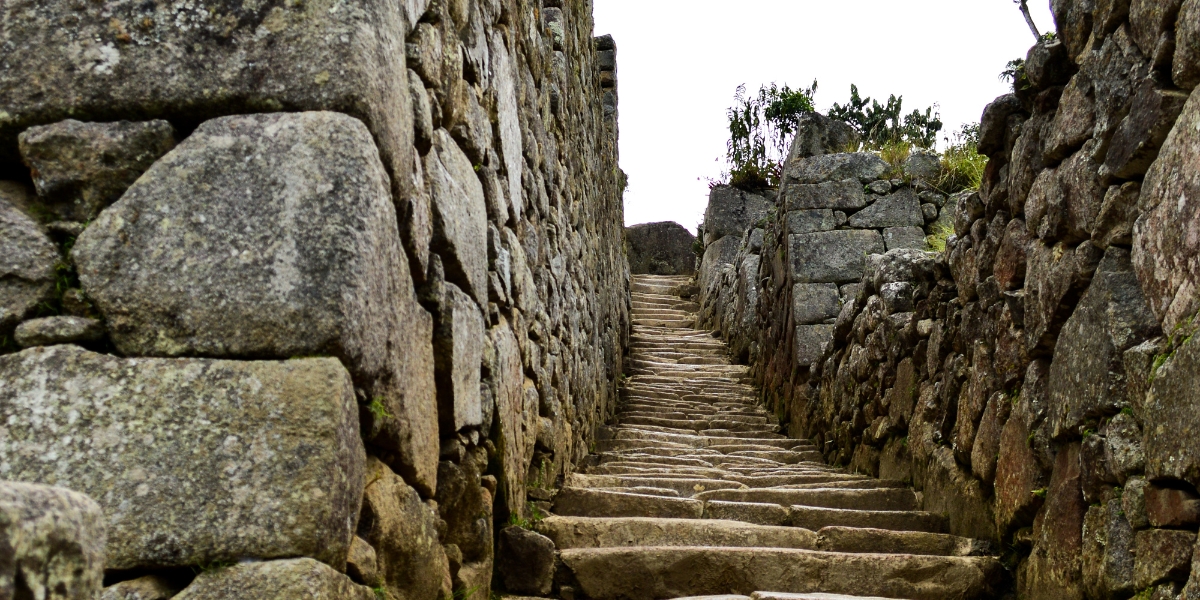
How to Get to Machu Picchu?
A typical Peru vacation begins in Lima, the location of the country’s main international airport. Lima is also the capital and largest city in Peru.
From here you will likely fly to Cusco, the city closest to Machu Picchu. Time in the air is about one hour.
From Cusco, Machu Picchu is about 70 miles northwest by road, on the other side of the Sacred Valley.
Below Machu Picchu on the other side of the mountain is the tiny town of Aguas Calientes, also called Machu Picchu Pueblo or Machu Picchu Town. Most people who visit the citadel will spend at least one night in Aguas Calientes. Other than the Inca Trail, this town is the only access point to the ruins.
Trains to Machu Picchu
Trains to Machu Picchu leave from three different stations in the Cusco Region: Ollantaytambo, Urubamba, and Poroy. SA Expeditions typically has travelers depart from the Ollantaytambo and Urubamba stations to reach Aguas Calientes, the gateway to Machu Picchu since its the most scenic and efficient route.
The train from Ollantaytambo takes about 1.5 hours and is operated by PeruRail and Inca Rail.
The train from Urubamba takes about 2.5 hours and is operated by PeruRail.
The train from Poroy takes about 3 hours and 15 minutes and is operated by PeruRail.
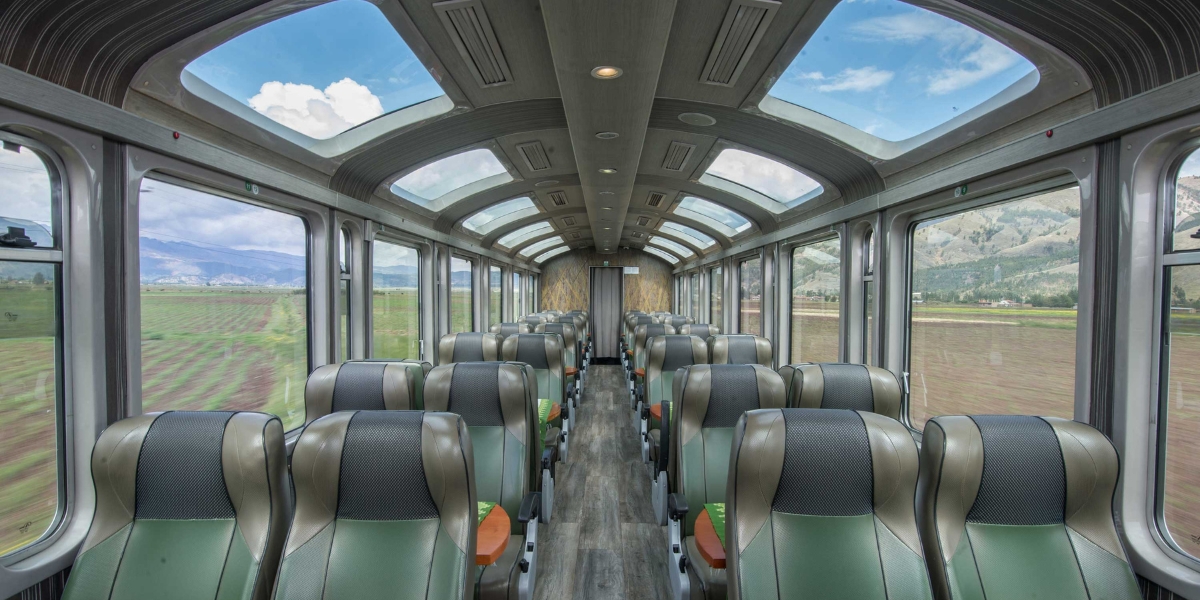
PeruRail and Inca Rail have several types of trains that offer comfortable seating and various amenities. Depending on your choice of train, you can enjoy food and beverage services, panoramic windows that allow fantastic views, and exclusive bar and gourmet meal services as you make your way to the iconic Wonder of the World.
From Aguas Calientes to Machu Picchu
Aguas Calientes sits at 6,690 feet above sea level, while Machu Picchu is at 7,970 feet above sea level. Accessed via the Hiram Bingham Road, there are two different ways to travel up to Machu Picchu from Aguas Calientes:
Bus: We recommend taking the 30-minute bus ride to Machu Picchu as this is the quickest and most physically friendly way to get to the ruins. You will have more time to explore Machu Picchu, as well as do additional hikes around the site. Buses to Machu Picchu leave from 5:30AM to 3:30PM every 5-10 minutes.
By foot: The walk from Aguas Calientes to Machu Picchu takes about two hours and boasts stunning landscapes, such as the mountain range and thick vegetation that surrounds Machu Picchu. With a gain of over 1,200 feet, trekking up to Machu Picchu can be physically demanding.
If time permits, a bonus option can be to take the bus ride up to Machu Picchu and return by walking back down to Aguas Calientes, descending the mountain. Whichever you prefer, SA Expeditions will help you organize all necessary transportation to get to Machu Picchu.
Hike the Inca Trail to Machu Picchu
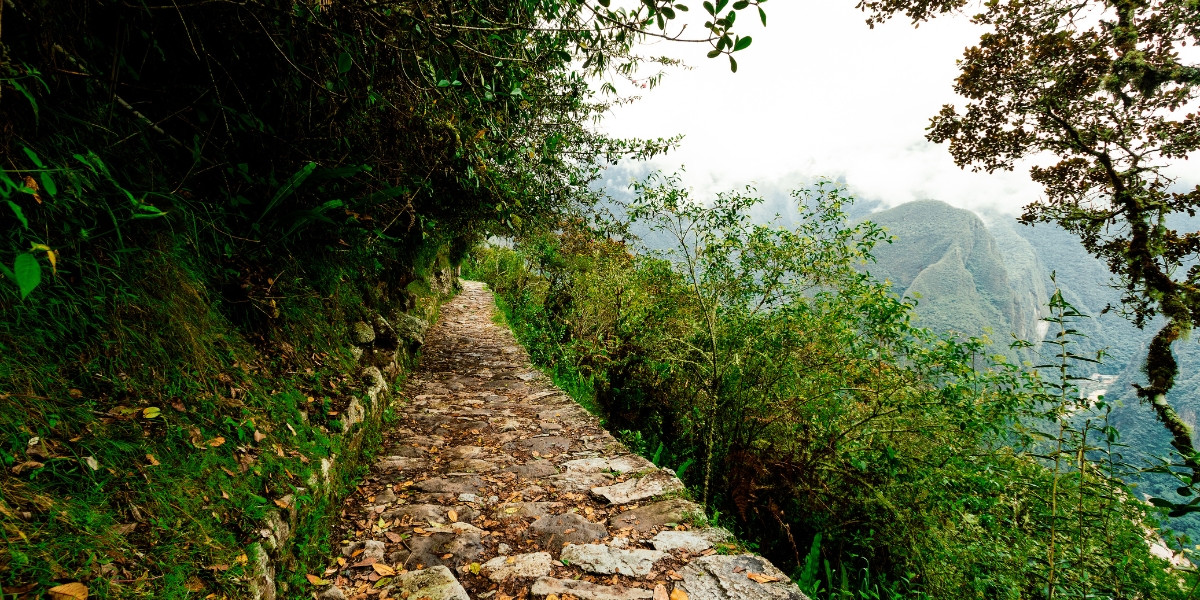
Hiking the Inca Trail to Machu Picchu is one of the best ways to truly immerse yourself into the world of the Inca. The best options include hiking the Classic Inca Trail, the Short Inca Trail, or the Salkantay Trek.
The Classic Inca Trail : Starting with a train ride from Cusco to the trailhead, this famous route takes you on a 26-mile trek from KM82 to Machu Picchu. For four days, you will be hiking through various Inca sites, including Llactapata, Sayacmarca, Phuyupatamarca, Wiñay Wayna, and the infamous Dead Woman’s Pass, before beholding the magical Machu Picchu.
The Short Inca Trail : The Short Inca Trail is a day hike that is essentially the final 9 miles of the Classic Inca Trail. This is a great option for those who aren’t interested in camping but would still like to experience the Inca Trail. From Cusco, you will take a train ride to KM104 to begin your hike to Machu Picchu. Passing through Chachabamba, you will get the chance to see the awe-inspiring archaeological site of Wiñay Wayna and approach Machu Picchu through the glorious Sun Gate.
The Salkantay Trek : Starting with a car ride from Cusco to the trailhead, the Salkantay Trek takes you on a 41-mile hike from Soraypampa to Aguas Calientes. For four days, you will be hiking among majestic mountains, beautiful cloud forests, and fascinating sites like Llactapata until you arrive to your hotel at Aguas Calientes. The following day, you will take the bus to the magnificent ruins of Machu Picchu.
Other Treks around Machu Picchu
The treks mentioned above aren’t the only spectacular trails near Machu Picchu! If you're seeking a less crowded yet equally breathtaking path, there are several other options, such as the trek to the vast, mythical ruins of Choquequirao or Vitcos , both located in the remote and little-visited Vilcabamba Range. The three-day Lares Trek takes you among stunning mountain and lake views, lovely Andean villages, and the fascinating Inca site of Pumamarka.
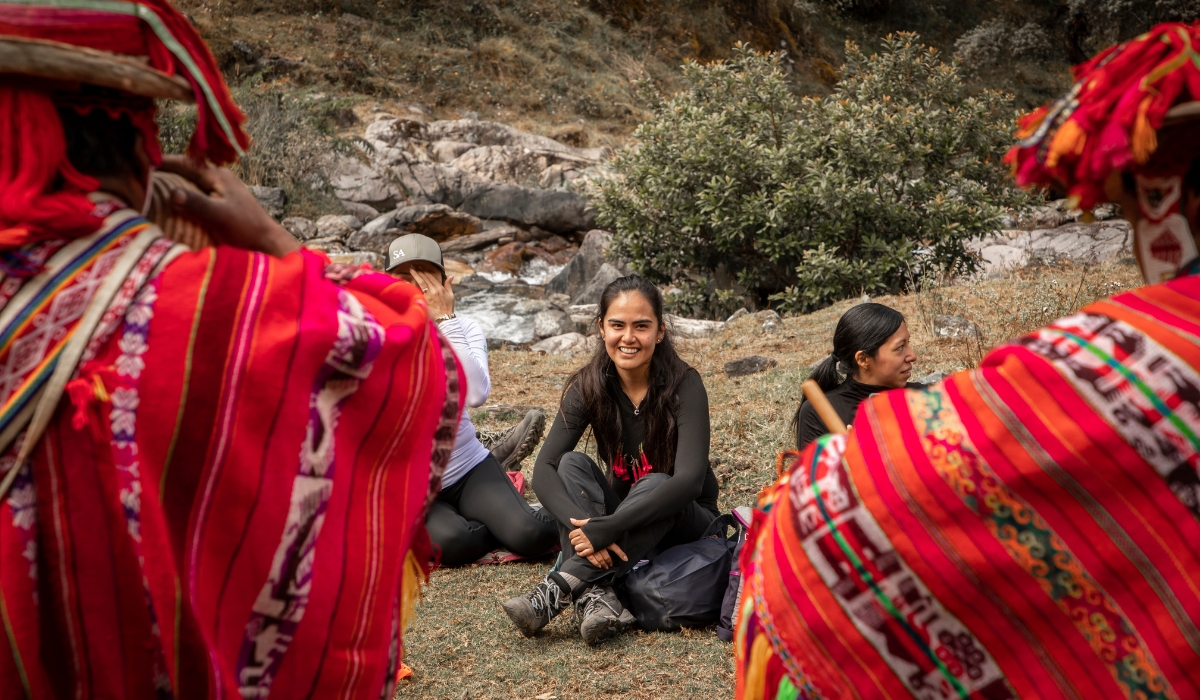
For a truly special experience (and a past traveler favorite), the two-night Choquechaca Trek is a unique and authentic experience developed by SA Expeditions in conjunction with the people of the Choquechaca Valley, who have become integral partners in our company's journey. You’ll trek through remote and pristine landscapes accompanied by the people who have lived there for centuries, camp in spectacular locations, and visit your guides’ ancestral village and meet their families.
For those who aren’t keen on camping every night but still want to explore the Inca Trail, our Great Inca Trail Day Hikes would be perfect for you! This tour takes travelers off the beaten path to some of the most pristine sections of the Qhapaq Ñan, or Great Inca Trail, including the Choquechaca Valley. At the end of each day, you’ll be able to unwind at a cozy hotel.
How to Plan your Trip to Machu Picchu
Machu picchu tickets.
In Machu Picchu, there are five different types of entry tickets: Machu Picchu only, Machu Picchu and Huayna Picchu, Machu Picchu and Huchuy Picchu, Machu Picchu Mountain and the ruins, and Machu Picchu and the Inca Bridge.
Considering each experience takes different lengths of time, each ticket has distinct entry hours as well as designated routes throughout the Inca ruins. The traveler must enter the ruins in the hour they have purchased. For example, a 6:00AM entrance must enter the site between 6:00-6:59AM.
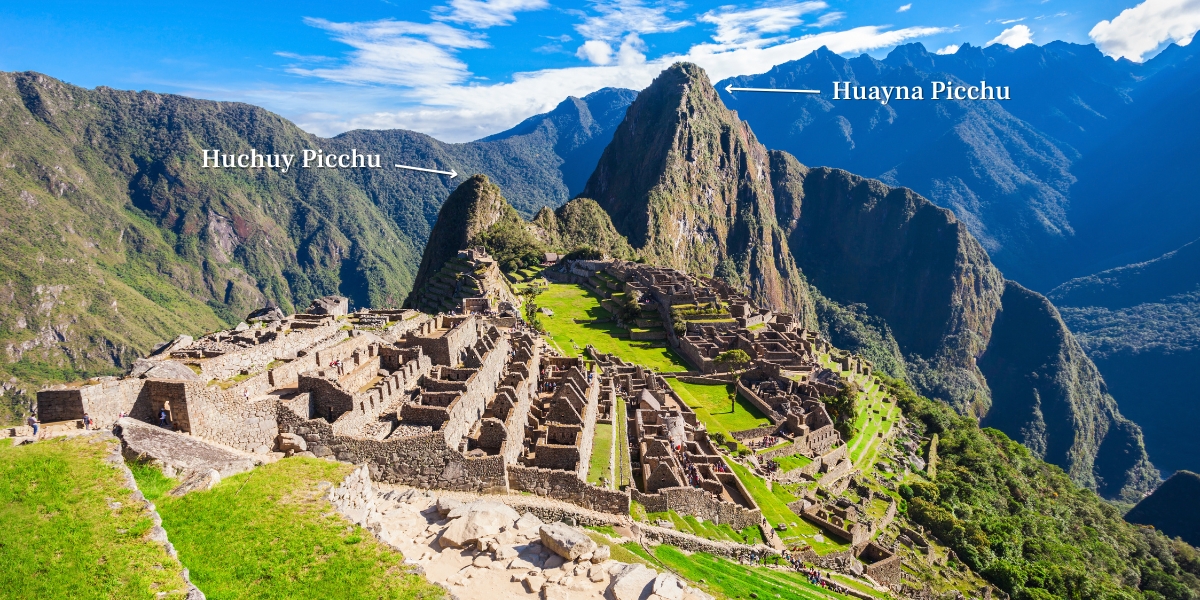
Those with Machu Picchu Only tickets can go through any of the four circuits within the archaeological site. However, we recommend taking Circuit 1 or Circuit 2 as they provide the most comprehensive tours throughout the ruins. These routes take about three hours to complete.
Travelers with tickets to Machu Picchu and Huchuy Picchu go through Circuit 4 . The route to Huchuy Picchu takes about three hours to complete.
Visitors with tickets to Machu Picchu and Huayna Picchu also hike through Circuit 4 . The route to Huayna Picchu takes about four hours to complete.
Those adding a visit to Machu Picchu Mountain will take Circuit 3 , then hike up the Machu Picchu Mountain Route , taking about five hours to complete. (Not sure whether to hike Machu Picchu Mountain or Huayna Picchu? Check out this blog !)
Visitors with tickets to Machu Picchu and the Inca Bridge walk through Circuit 1 or Circuit 2 , taking up to three hours to complete, along with a 20-minute hike to the Inca Bridge .
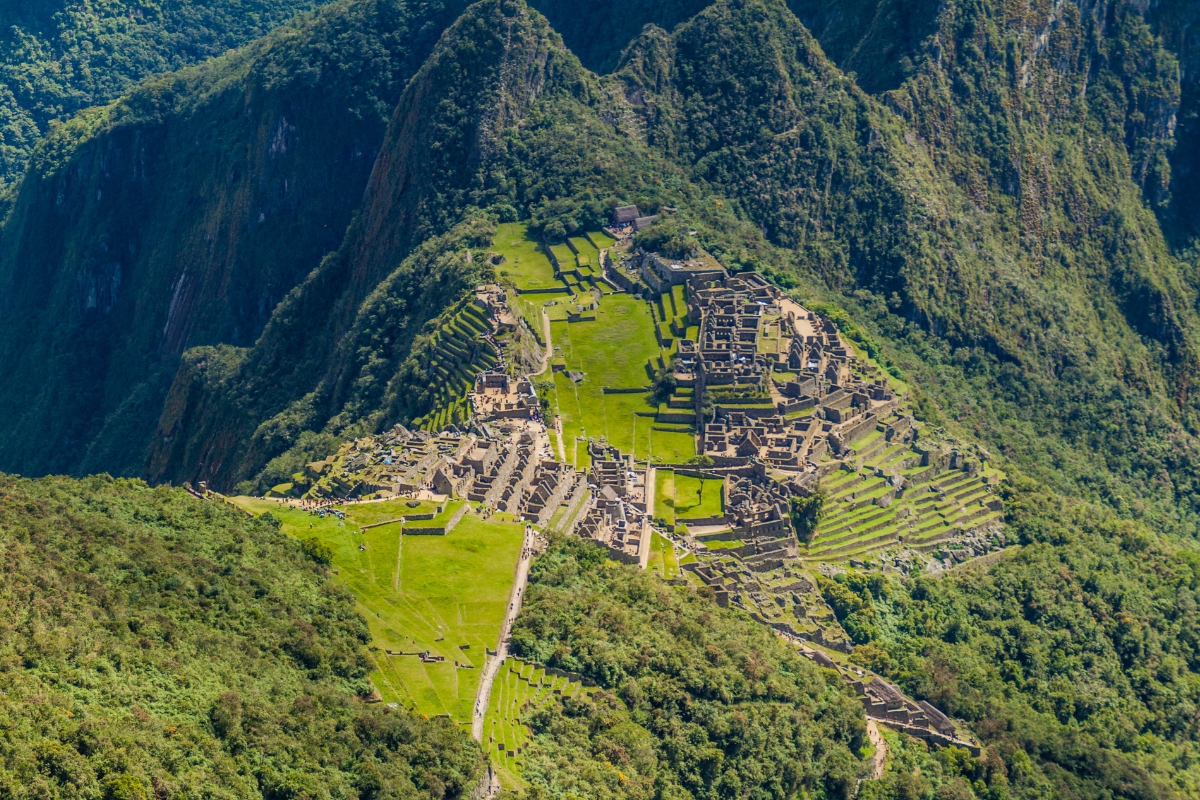
Booking your ticket in advance is essential! We recommend booking at least three months in advance, noting that Huayna Picchu and Machu Picchu Mountain tickets are higher in demand than general Machu Picchu admission. Booking with SA Expeditions will ensure you secure all tickets and transportation necessary for your unforgettable journey.
Plan the Visit to Machu Picchu
Most Machu Picchu tours include 2 hours with a specialist guide who details the most important and interesting structures. With SA Expeditions, you will have the same local expert guide all throughout your journey in Cusco, the Sacred Valley, and Machu Picchu to ensure your trip runs as smoothly as possible.
As the site contains over 200 buildings (or partial buildings), there is plenty to explore, and an early morning visit is highly recommended. As the sun breaks through the mist, Machu Picchu is tantalizingly revealed bit by bit until the whole complex is enveloped in an amber glow. To fully appreciate the splendor of a Machu Picchu sunrise, head directly to the Sun Gate or toward Huayna Picchu, both of which offer panoramic views of the entire complex.
Perhaps Bingham, the first Westerner to experience these mystical ruins, describes the beautiful mix of expert architecture and stunning scenery better than any other:
“The Incas were, undeniably, lovers of beautiful scenery. Many of the ruins of their most important places are located on hill tops, ridges, and mountain shoulders, from which particularly beautiful views can be obtained. Remarkable as is the architecture of Machu Picchu, and impressive as is the extent of the stone-cutting done by a people who had no steel or iron tools, neither of these things leaves more impression on the mind of the visitor than the inexpressible beauty and grandeur of the surroundings.”
Machu Picchu Highlights

Having a general entrance to Machu Picchu and hiking Circuit 2 takes you through the best parts of the ruins, including sites such as:
Temple of the Sun
Temple of the Condor
Hall of Mirrors
Three Covers
Sacred Rock
Intihuatana
Sacred Plaza
The Guardhouse
Other highlights include the supplemental admissions to the Inca Bridge, Huayna Picchu, Huchuy Picchu, and Machu Picchu Mountain. Hiking up Huayna Picchu also brings you to the Temple of the Moon.
If you are hiking the Inca Trail to Machu Picchu , Intipunku (also known as the Sun Gate) is the iconic gateway where you catch your first glimpse of the Inca citadel. While you can still hike out and back to Intipunku from the ruins with a general admission, note that the Sun Gate is over 1,000 ft. higher than ruins, meaning this would add an extra few hours to your visit. We recommend touring the site before deciding to hike to Intipunku.
Best Time to Visit
Machu Picchu is open year-round and the best time to visit ultimately depends on personal preference.
The dry season is from May to September, while the wet season is from October to April. Each period has their own pros and cons. The dry season is the most popular and busiest time of the year with little to no rainfall, and even holds the fascinating Inti Raymi festival. Although the rainy season can be more challenging, there is less crowding on site and the rainfall brings lush vegetation and blooming flowers. To have the best of both worlds, consider visiting during the shoulder seasons in May or September. Take a look at a more detailed guide of when to visit Machu Picchu here .
Where to Stay
Aguas Calientes offers a variety of options available for lodging. For those who enjoy boutique hotels, Casa Andina is set alongside the Vilcanota River and provides an excellent setting for relaxing before and after a full day of exploration at Machu Picchu, along with an elaborate breakfast buffet and a fully stocked snack store for meals-on-the-go.
For travelers seeking a more superior or luxurious option, Sumaq is an excellent lodge also set by the Vilcanota River, offering cozy and charming, upscale bedrooms and an elegant restaurant serving tasty Peruvian fusion cuisine.

Other options include El Mapi and Pueblo Hotel. El Mapi boasts a great location near the town square and hot springs, plus an impressive hotel bar and café, while Pueblo Hotel holds quaint, luxurious cottages and sumptuous amenities like a natural Andean sauna, a naturalist center, and an exquisite restaurant.
Packing Tips
When visiting Machu Picchu , keep a few things in mind: the weather in the Andes can be unpredictable, the terrain can be quite rugged (especially on the Inca trail), and you may be on your feet for an extended period of time. Our main advice for what to bring to Machu Picchu would be:
Lightweight, quick dry clothing
Layers to be able to put on and take off necessary clothing
Comfortable, sturdy shoes
Rain jacket or poncho
Sun protection (sunscreen, hat, lip balm, etc.)
Lots of water!
Considering there are limitations when bringing baggage on the train to Machu Picchu, you will need to make sure you have a separate duffel, backpack, or small suitcase apart from your main luggage (full checked-size suitcases are not permitted on the train). During your stay at Machu Picchu, your main luggage will be stored securely at your Cusco or Sacred Valley hotel at no additional charge.
If you're traveling with SA Expeditions on a Machu Picchu Trek , you're in luck! Several essential items, such as a tent, sleeping system, meals, and even bathroom, are already included in your trip. For more information, read our ultimate guide on packing for the Inca trail to Machu Picchu .
Machu Picchu History: When and how were the ruins discovered?
Built by the Incas around 1450 and later abandoned, Machu Picchu sat in relative obscurity until 100 years ago when Hiram Bingham, an American explorer and professor, stumbled upon the ruins in July of 1911. Bingham, guided by in-the-known locals, mapped, and documented the jungle-covered stone ruins to the best of his ability before returning to the United States where he published his finding in National Geographic.

In his own words, Machu Picchu:
“…not only is larger and contains more edifices than any other ruin discovered in Peru (except Cusco); it has the additional advantage of not having been known to the Spaniards, of not having been occupied by their descendants, and of not having been torn to pieces by treasure hunters seeking within the walls for the gold and silver ornaments that were not to be found in the floors.
In other words, Machu Picchu is not only more extensive than any previously discovered Inca city outside of Cusco, but it is in a remarkably good state of preservation, and its architecture has not become confused with Spanish efforts to build churches and villas.” (Bingham, Hiram. “ In The Wonderland of Peru .” National Geographic April 1913.)
Although Bingham and numerous scholars since have studied Machu Picchu extensively, the true purpose for its construction remains largely a mystery. Recent theories identify Machu Picchu as a retreat for royalty, and when you first set sight upon these ruins surrounded by lush mountain peaks with a rising mist that frosts the outlying buildings, it is easy to visualize this as a lavish compound of luxury.
Things you probably didn’t know about Machu Picchu, Peru
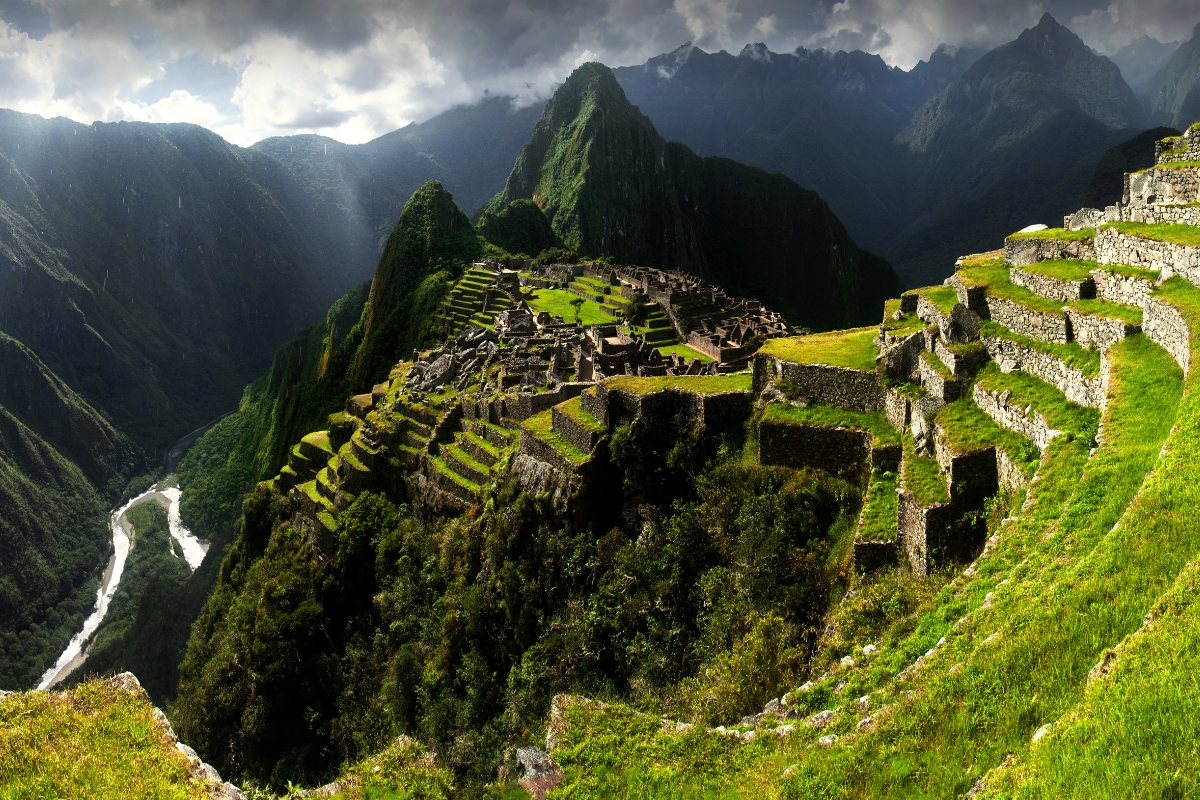
Machu Picchu means ‘old peak’ or ‘old mountain’ in the local Quechua tongue. Machu has one 'c' and Picchu has two. Get it right!
Almost all known Inca settlements, cities and sites were at least partially destroyed by the Spanish conquistadors: one need only visit Cusco to see what they were capable of. Machu Picchu’s location saved it: because it isn't visible from below, the Spanish never found it.
Although Hiram Bingham is credited as the first westerner to discover the ruins (in 1911), it’s highly likely that others had been before him – perhaps as many as 40 years earlier. Bingham was definitely the first academic to discover them, and his book Lost City of the Incas caused quite a storm in the US and Europe. Ironically, Machu Picchu probably isn’t the lost city Bingham was looking for: he was intent on finding Vilcabamba, which is believed to be about 50 miles west of Machu Picchu.
The Incas are probably the greatest stone-masons ever to have walked the earth. For all its magnificence, the construction of Machu Picchu did not require a single ounce of mortar: instead the Incas cut their stone blocks so precisely that they were able to wedge them together so tightly that the blade of a knife cannot fit between them. Not only is this an amazing feat of engineering but it’s also very useful in an area prone to earthquakes: during a quake or tremor the stones ‘dance’ but the walls do not crack or fall. Cusco’s quakes of 1650 and 1950 were clear proof of the superiority of Inca construction over Spanish – Spanish churches crumbled but their Inca foundations stood firm.
Not only was Inca stone-masonry exceptional, but their laborers are thought to have carried the 50 pound stones to the site by hand. Incas did not have wheeled vehicles, and they did not use animals to lug or carry heavy items. Throughout Machu Picchu there are more than 100 staircases. Almost all of which are carved from a single piece of stone – I wonder how they got there?
If you hike the Inca Trail you’ll probably notice that the porters sleep on top of a small piece of mirror or reflective metal, face down on the earth. They do this to protect themselves from being whisked away by evil spirits which live within the earth
Although the Inca trail is a challenge for most people when completed gradually over 4-5 days, there is now an annual Inca trail marathon where runners compete the course in under 12 hours. The record stands at just under four hours.
Like all tourist attractions, Machu Picchu has rules of entry. Most of them are pretty standard, but one is very quirky indeed as it forbids you to enter the ruins in the traditional dress of another country. Best you leave the kilt at home then …
One of the peculiarities of Machu Picchu is that there is hardly any information about the ruins on site. There is, however, a very good ‘museo del sitio’ between Aguas Calientes and the citadel.
Whew! We’ve covered a ton of details to help you prepare for your adventure to Machu Picchu. It’s time to have a look at what your Machu Picchu journey can look like. When you’re ready, talk to a Destination Expert and we’ll have your trip in action in no time!
Sign up for our Newsletter!
- Our Purpose
- Travel Agents
- Terms & Conditions
- Privacy Statement
Copyright © 2024 SA Luxury Expeditions LLC, All rights reserved | 95 Third Street, 2nd floor, San Francisco, CA, 94103 | 415-549-8049 California Registered Seller of Travel - CST 2115890-50. Registration as a seller of travel does not constitute approval by the state of California.

- Peru Tour Packages
- Customized Tours
- Destinations
- EN EN ES DE
- Peru: +51 932 671 370; USA: +1 (786) 352-8319
Machu Picchu Tours
- Inca Trail Tours
Salkantay Trek
- Amazon Jungle Tours
- Machu Picchu
- Sacred Valley
- Rainbow Mountain
- Humantay Lake
- Huacachina Oasis
- Huacachina & Paracas
- Lake Titicaca
- Amazon Jungle
- FREE Peru Travel Guide
- Machu Picchu Guide
- Peru Travel Tips
- Things to do in Cusco
- Things to do in Lima
- Peru Amazon Guide
Home » The Ultimate Machu Picchu Travel Guide
The Ultimate Machu Picchu Travel Guide
- 23 January, 2022
- by Konsti Sobon
- Reading time: 9 minutes

The Lost City of Machu Picchu is one of the most iconic archeological treasures in all of South America. Tucked away in the cloud forests of the Andes, Machu Picchu is believed to have been a royal estate or sacred religious site for Inca leaders.
Today, its mountain top location, finely crafted stonework, and ancient history make Machu Picchu Peru’s most sought-after destination.
Ready for an adventure? Here’s a rundown of everything you need to know before you head off to one of the world’s most famous man-made wonders.
Plan Your Visit
Machu Picchu is the most popular Inca site in Peru, which means that you need to plan your visit well in advance.
When planning for Machu Picchu, there are some key milestones to hit before you start packing. For an enjoyable adventure, your first steps should be focused on deciding on the best time to go and how to best adjust to the altitude difference.
Here are some pointers to help you kick-start your planning.
The ancient citadel of Machu Picchu is open all year round. Before booking, though, it’s sensible to note how much rain (and slippery paths) you are willing to handle.
Peru has two main seasons: dry and wet. The peak travel season coincides with the region’s dry season – from April to September. During this time, the Machu Picchu weather is usually milder, making it easier and more comfortable to walk the ancient paths of the Incas.

Omar Asif 5 May, 2022 at 10:22 am
This is very compact and useful! Thanks for the interesting insights and that will help us to plan our Peru trip.
Oliver from Exploor 5 May, 2022 at 1:30 pm
Thank you Omar, we’re happy to hear that the content helps! If there’s anything else you need, feel free to shoot us a message! 🙂
Jennifer Morley 13 March, 2022 at 5:26 pm
Which train company do you guys recommend, Peru Rail or Inka Rail?
Oliver from Exploor 14 March, 2022 at 9:35 pm
Hey Jennifer! We’d recommend and mainly work with Peru Rail! Feel free to check our post about the different train options . Hope this helps 🙂
Carol 28 February, 2022 at 12:33 pm
We are short on time and have around 4-6 days to visit Lima&Cusco.
Any tour recommendations or what would be the best tour itinerary for us?
Konsti from Exploor Peru 1 March, 2022 at 6:45 am
Hello Carol, thanks for reaching out to exploor! In case you are staying for only 4-6 days in Peru I would highly recommend you the following itinerary: 1. Arrival in Lima (probably afternoon) 2. Flight to Cusco (get used to the altitude) and discovering during our Cusco City tour the best sites such as San Pedro Market, San Blas neighborhood, Sacsayhuaman etc. 3. Sacred Valley 4. Machu Picchu 5. Rainbow Mountain Palccoyo or Vinicunca 6. Flight back In case you are interested to learn more about this adventure feel free to visit the tour page in addition to that you can request our guided Cusco City tour.
Let me know if you have any further questions. Best, team exploor
Josh 27 January, 2022 at 10:18 am
Veryyy interesting! This complete guide is really helpful for our trip to Peru in May. Is it possible to get assistance with finding the right hotels for Cusco and Lima?
Oliver from Exploor 28 January, 2022 at 5:52 pm
Hey Josh, glad the content is useful for you guys! Yes of course, feel free to send us an e-mail to [email protected] and we’d be happy to help you out. 🙂
Leave a comment
Related posts, the 3 best multi-day trips from cusco.
- 20 December, 2021
- by Oliver Eberlein
Machu Picchu Weather – All You Need to Know
- 10 April, 2019
- by Erik Krause
10 Things Not To Miss In the Sacred Valley of the Incas
- 28 September, 2021

Let’s plan your dream trip to Peru
All of our tour itineraries are 100% customizable . Just let us know your preferences below and we’ll get back to you within 24-48 hours.
- First name* Last name*
- Starting Date* Number of travelers* 1 2 3 4 5 6 7 8 9 10
- Hotels (Optional, multiple choices possible) Luxury Superior Best Value
- Trip Length 3-5 Days 6-8 Days 9-11 Days 12-15 Days 16+ Days Not sure yet
- Comments* 2500 characters remaining

How to Experience Machu Picchu
Traveling to peru’s famed inca citadel is an epic trip worth taking at least once in your life. here’s how to make the most of it, whether you’re hiking or arriving in style on a luxury train..
- Copy Link copied

Machu Picchu can only be accessed now via timed entry tickets purchased in advance.
Photo by Lyndsey Matthews
One of the New Seven Wonders of the World and a UNESCO World Heritage site, Machu Picchu is practically synonymous with Peru. Built during the 15th century, this Inca citadel was abandoned sometime after the Spanish invasion and remained unexplored until 1911 when American scholar Hiram Bingham III and a team of Peruvian explorers stumbled upon it in the cloud forest about 50 miles northwest of Cusco. Why it was built and why it was abandoned are still mysteries. Here’s what you need to know for your visit, including when to go, where to stay, and how to get there.
Best time to visit Machu Picchu
High season for Machu Picchu is its dry winter months from June to August. Since hotels in Aguas Calientes—the town at the base of Machu Picchu—book up months in advance and a limited number of tickets are available to enter the archeological site each day, it’s smart to consider the shoulder season months of April, May, September, and October when there are fewer crowds and temperatures average in the 60s Fahrenheit.
Low season coincides with Machu Picchu’s rainy summer season, which runs from November to March each year. Though the archeological site remains open year round, if you’re planning a hiking trip, keep in mind the entire Inca Trail is closed each February due to harsh weather, safety issues, and planned annual maintenance work.

Rainy season is no joke at Machu Picchu—plan accordingly.
Photo by Stock for you/Shutterstock
Getting acclimated to Machu Picchu’s elevation
Machu Picchu is located at 7,972 feet above sea level and Cusco is located even higher (just over 11,000 feet). To avoid the effects of altitude sickness, which can include nausea and bad headaches, follow these tips:
- Consider flying into Cusco and heading straight to Aguas Calientes, since it’s located around 6,700 feet, for a night or two to adjust to the high altitutde before visiting Machu Picchu.
- Stay as hydrated as possible.
- Avoid alcohol and heavy exercise the first few days.
How to get from Cusco to Machu Picchu
Though Machu Picchu is only 50 miles from Cusco, there’s no direct road between the two locations. The easiest way to get from Cusco to Machu Picchu is by taking a train from the San Pedro, Wánchaq, or Poroy stations in Cusco to the Machu Picchu Pueblo Station in Aguas Calientes. It takes just under four hours.
The main operators are PeruRail and Inka Rail , which offer a variety of luxury and budget options. For example, PeruRail operates the luxury Hiram Bingham, a Belmond Train every Tuesday, Wednesday, Thursday, Saturday, and Sunday between the Poroy Station in Cusco, Ollantaytambo Station, and Machu Picchu Pueblo Station. Expect 1920s Pullman carriages with wood details and polished brass, an observatory car, plus live music and pisco sours in the bar car. Prices are steep—starting around $1,000 for a round-trip ticket—but include the entrance ticket to Machu Picchu (with a guide), lunch and dinner on the train, and more.
If you choose to explore the Sacred Valley before heading to Machu Picchu, it’s possible to get a train from Ollantaytambo (a small town with original houses, streets, and waterways preserved from Incan times) to Aguas Calientes, which takes about two hours. (Many trains from Cusco offer bimodal options, as well, which include a bus from Cusco to Ollantaytambo and the train from there to Aguas Calientes.)
From Aguas Calientes, Machu Picchu is a 30-minute bus-ride up the hill. Tickets cost $15 round-trip for adults online , but many tour operators include the price of the bus ticket and entrance to Machu Picchu in their package. (It’s also possible to hike up to Machu Picchu from Aguas Calientes and back down, but it’s very steep and takes 90 minutes each way.)

Located in Peru’s Sacred Valley, Ollantaytambo is the starting point for most Inca Trail hikes and has ruins of its own worth visiting.
How to hike to Machu Picchu
For an extra challenge, active travelers can also hike to Machu Picchu on a multi-day trek or a shorter day hike. (Whichever route you take, be sure to take a few days to acclimate to the elevation before setting out.)
The most famous trek is the Inca Trail , a centuries-old route that leads from the Sacred Valley up into the Andes Mountains to elevations over 13,000 feet. A permit and an official guide are required to hike the trail, so it’s easiest to book both through a tour operator. The most classic route is a four-day/three-night trek that departs from Ollantaytambo and includes porters to carry packs and set up camp, as well as cooks who prepare three meals a day.
The Peruvian government limits Inca Trail access to 500 people per day, including porters. This regulation protects the local ecosystem and the delicate ruins, and it ensures that the trail won’t be too crowded. However, if permits for the peak summer season sell out, never fear: Various other trails lead to Machu Picchu. Here are some recommendations for classic Inca Trail trips to book, plus a few lesser-known treks that also include visits to Machu Picchu.

The classic Inca Trail route takes four days and three nights to reach Machu Picchu.
Luxury Inca Trail with Alpaca Expeditions
Book now: from $2,695, alpacaexpeditions.com
Alpaca Expeditions is a 100 percent Peruvian Indigenous-owned company. It offers a classic four-day/three-night trek on the Inca Trail to Machu Picchu starting at $750 per person, but the luxury version of this trip includes, among other things, upgraded tents with air mattresses and camping cots outfitted with feather duvets and cotton sheets (no BYO sleeping bag here).
Alpaca Expeditions will arrange for transport from Cusco, Urubamba, or Ollantaytambo to the Km 82 trailhead on the first day. For the return trip to Cusco, it also includes tickets on the luxury Hiram Bingham, a Belmond Train, from Aguas Calientes.
Peru Inca Trail Trekking Tour with Mountain Travel Sobek
Book now: from $3,795, mtsobek.com
Before setting off on a four-day, three-night trek on the Inca Trail, MT Sobek’s tour begins with two nights in the Sacred Valley at the new Las Qolqas eco-resort, set in a beautiful garden complex just outside the town of Ollantaytambo. Once travelers are acclimatized to the elevation, they’ll cross the Urubamba River to begin the Inca Trail hike starting at Km 88 instead of the Km 82, where most groups begin, for a more isolated experience. After three nights of tent camping, the trip culminates with sunrise views of Machu Picchu, plus another full day at the archaeological site before returning to Cusco.
Day Hike on the Inca Trail with Modern Adventure
Book now: from $8,000, modernadventure.com
For less ambitious hikers, Modern Adventure’s food-focused tours of Peru offer an optional day hike on a 6.8-mile portion of the Inca Trail as part of its larger seven-day trip. After taking the train from Ollantaytambo part of the way to Aguas Calientes in the morning, hikers disembark along the Urubamba River and start their journey up into the Andes past archaeological sites like Chachabamba and Winaywayna before descending to Machu Picchu through the Sun Gate in the late afternoon. Guests who opt out of the hike will take the train directly to Aguas Calientes and visit Machu Picchu the following day.
>> Read more: What It’s Like to Go on a Modern Adventure Tour of Machu Picchu

The sights along the Salkantay Trek rival the views at Machu Picchu, dare we say.
Photo by Andrew Clifforth/Shutterstock
The Salkantay Trek to Machu Picchu with Mountain Lodges of Peru
Book now: from $3,300, mountainlodgesofperu.com
Though the 50-mile Salkantay Trek is considered to be a more challenging alternative to the Inca Trail, it’s a little easier to take on knowing that each day of luxury outfitter Mountain Lodges of Peru (MLP)’s seven-day lodge-to-lodge trip culminates with a night at its proprietary hotels—the Salkantay Lodge, Wayra Lodge, Colpa Lodge, and Lucma Lodge. After days of exploring archaeological sites like Quillarumiyoc and crossing the Salkantay Pass (15,213 feet elevation), travelers get to enjoy a gourmet dinner, a soak in a Jacuzzi, and possibly spa treatments, too. The final day of the trek includes a morning at Machu Picchu before heading back to Cusco in the afternoon.
The Vilcabamba Trail with Kandoo Adventures
Book now: from $1,685, kandooadventures.com
When Hiram Bingham and a team of Peruvian explorers stumbled upon Machu Picchu, they were actually looking for the city of Vilcabamba. With Kandoo Adventures, hikers will spend two days in Cusco to acclimate, then head out on a five-day trek into the Sacred Valley. One of the most scenic and remote routes, the Vilcabamba Trail follows the Cordillera de Vilcabamba and promises solitude and a serious workout before ending with a visit to Machu Picchu on the last day.
The Huchuy Qosqo Trek with Llama Path
Book now: from $599, llamapath.com
The first two days of this three-day trek that begins in Cusco are dedicated to visiting the historic Inca site of Huchuy Qosco and to getting to know the history and some of the people who live in the area. The last night is spent in the town of Aguas Calientes before the Llama Path team takes you up to Machu Picchu.
Of course, plenty of tours to Machu Picchu don’t require multi-day hikes. Though tour operators like G Adventures and Intrepid both offer Inca Trail treks, travelers can also book trips through them that skip the trails and include a visit to Machu Picchu by the train and bus combo described earlier.

Llamas are allowed to roam freely around Machu Picchu, but humans aren’t, so it’s important to obey the rules.
Machu Picchu tickets (and other tips for visiting the site)
Machu Picchu is open every day from 6 a.m. to 5:30 p.m., and tickets for international adults start at 152 Peruvian soles (about US$42). Most treks and tours include entrance tickets to Machu Picchu itself in their cost. If you’re traveling independently from a group tour, keep in mind that advance timed entry tickets are required and you must hire a certified guide. (Guides are available at the entrance.) Also, don’t forget your passport, which you’ll need to verify the name on your ticket.
In addition to establishing five one-way circuits to help with crowd control, Machu Picchu has added strict limits to the number of visitors it allows each day. (You’ll want to choose circuit one or circuit two if you want to snap that classic postcard view of Machu Picchu.) Currently, just under 3,000 tickets are available for the main citadel each day, so be sure to purchase your ticket as early as possible. There’s even less availability if you want to hike Huayna Picchu, the peak in that signature view of Machu Picchu. (Only 200 people are allowed to hike each day.)
The best time of day to visit Machu Picchu: Arrive the night before to Aguas Calientes, and get on the first bus that leaves at 5:30 a.m. so you can be one of the first people on site. Similarly, if you visit in the late afternoon before it closes, you’ll encounter fewer crowds.
What to wear (and what to leave at home): The sun is also very strong at altitude, so hats and sunscreen are a must. But no matter how sunny it is, it’s also smart to bring a rain jacket in case of rogue showers since umbrellas aren’t allowed into the site.
Rules to follow: After a German tourist fell to his death in 2016 , the park now forbids jumping photos and strictly enforces it. Other big no-nos include eating in nondesignated food areas, sitting on the sacred ruins, and touching their stone surfaces.
Where to stay near Machu Picchu
The Sanctuary Lodge, a Belmond Hotel , is located right at the gate to Machu Picchu, allowing the best access to the site. The 31 rooms and suites come with comfy beds and marble bathrooms, and some have terraces and mountain views. There’s not much to do other than eat and drink at the hotel itself—unless you want to take the 30-minute bus ride down to Aguas Calientes—but after a long train ride or hike, relaxation might be all that’s on your mind before an early bedtime.
For those planning on staying more than one night, it’s best to book in Aguas Calientes for easy access to the markets and restaurants located there. One of the best—and most beautiful—options in town is the Inkaterra Machu Picchu Pueblo Hotel . It has 83 rustic adobe casitas set among 12 acres within a cloud forest next to the Urubamba River that’s home to 214 bird species and even more varieties of native orchids.

Are you sure you want to close the session?
La cuenta ya se encuentra activa
Or enter your e-mail:
Recover your offer
We will send you a 4-digit code shortly
Enter the 4-digit code and your new password
Enter your search here

- Machu Picchu
Energy filled Historical Sanctuary
Machupicchu Department of Cusco
- Attractions
"For the variety of its charms and the power of its spell, I do not know another place in the world that compares to it," is what Hiram Bingham, the American explorer who rediscovered the citadel of Machupicchu in 1911, said. And now, this Wonder of the Modern World is one of the most visited destinations in America.
Located on top of a mountain in the middle of a tropical forest, it is considered the tourist attraction par excellence in Peru. The historic sanctuary is a place that captivates tourists not only for its dazzling architectural beauty, but also for its important historical-cultural legacy, which has led it to be recognized and admired throughout the world.
Declared Cultural and Natural Heritage of Humanity in 1983 by UNESCO, it is probably the most amazing architectural construction of the Inca Empire. This citadel is made up of temples, palaces, terraces, monuments, complexes and walls; in addition to water channels, built with large blocks of stone, without any amalgam, proof of the great wisdom of the Inca civilization.
Surrounded by forests in the province of Urubamba (Cusco), Machu Picchu annually receives approximately 1 and a half million visits. It has an area of more than 30 thousand hectares, where it is possible to find a varied flora and fauna, as well as wooded areas, steep mountains and snow-capped peaks.
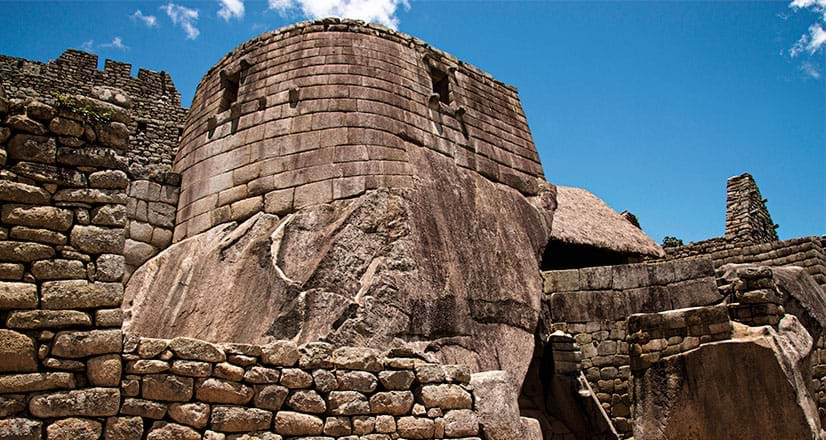
History of Machupicchu
Located in the heart of the Peruvian Andes, the sacred Inca citadel built around 1450 and discovered in 1911, still hides enigmas and mysteries about its real purpose, which continue to be hidden to this day and which arouse the interest of both visitors and archaeologists from all over the world. the world.
Due to its strategic location at the top of a high mountain, there are various theories about what it could mean for the Incas. Some argue that it was built as a great mausoleum for the Inca Pachacútec, while others claim that it was an important administrative and agricultural center whose cultivation areas served for the livelihood of its inhabitants. However, it is also considered that it was used as a necessary link between the Andes and the Peruvian Amazon or as a resting residence for the Inca governor.
The truth is that Machupicchu is one of the greatest symbols behind what was the impressive architecture and engineering of the Inca Empire. Although its origin is still the subject of study, the value and significance it represented in its time, as well as its imposing design, have earned it to be considered one of the seven wonders of the modern world.
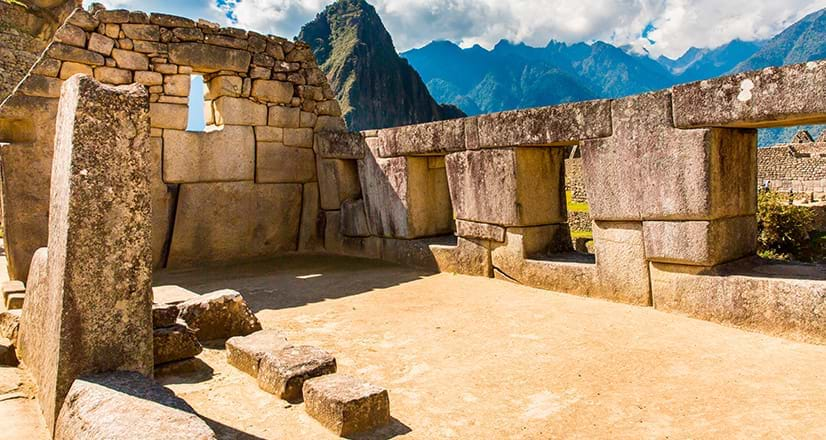
Places of Interest in Machupicchu
During the tour of the sanctuary, one witnesses the most fascinating and incredible attractions. Each one with its own history and meaning, but all with great architectural beauty.
In total, there are around 196 tourist spots within the citadel among archaeological complexes, squares, temples, water fountains, monuments and residences; all intertwined with each other and with the natural environment.
When touring Machupicchu, you can see two well-marked sectors divided by a wall of approximately 400 meters long: one oriented to agricultural purposes and the other more urban. The agricultural area is characterized by the presence of terraces or platforms that were used for the cultivation of various foods. Very close to this area, there are some small houses that could have been the dwelling of farmers.
On the other hand, in the urban area the Royal Residence is located, which was the finest, most extensive and best distributed house in the place; the Plaza Sagrada, the main ceremonial site of the city, the Intihuatana Pyramid, where the great solar clock is located; the Grupo de las Tres Portadas, a group of buildings made up of three large portals and the Grupo del Cóndor, which includes temples for ceremonial use.
The Sacred Rock
Huge monolith whose dimensions border on three meters in height on a base of seven and is one of the most mystical symbols found in this place. It is believed that it could have been oriented to the study of the stars.

Carretera Longitudinal de la Sierra Sur, CU-110
61.1 km, 1 h 11 min, pe-28b, cu-107, 151.7 km, 3 h 50 min, 151.8 km, 3 h 50 min, how to get to machupicchu.
By air: 1 h 15 min approximately
Cusco-Ollantaytambo
Overland: 1 h 30 min approximately
Ollantaytambo-Machupicchu
Train: 2 h approximately
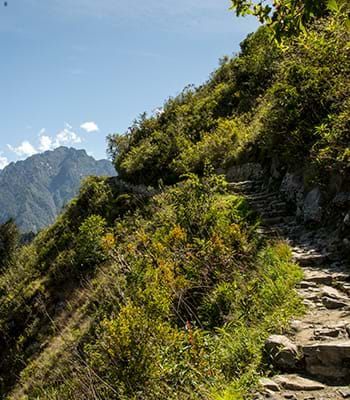
You can trek the fabulous Inca Trail to Machupicchu.
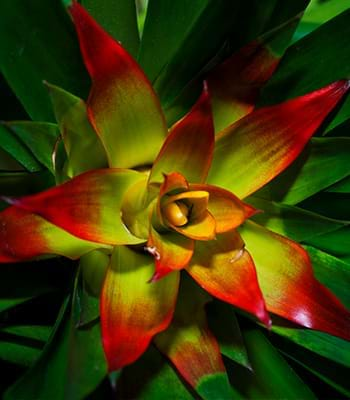
Identify around 30 species of orchids.
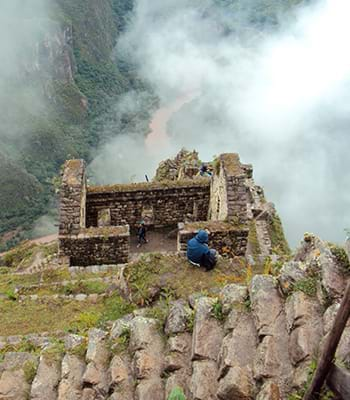
Climb Huayna Picchu and take a photograph from the top of the world.
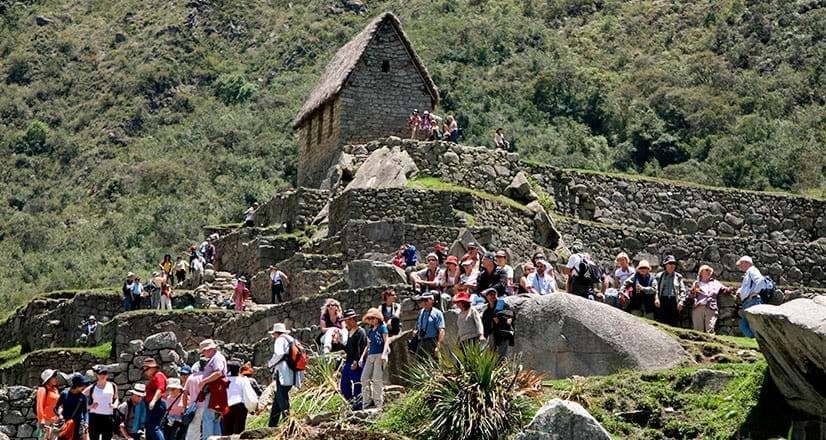
General information
2 445 meters above sea level
Min. 1 ℃/ Max. 20 ℃
6:00-17:30 *Referential times
Check here for prices and find the information you need to plan your next visit to Machupicchu.
Camera, sunscreen, warm clothing, trekking gear (optional)
Must-visit attractions in Perú
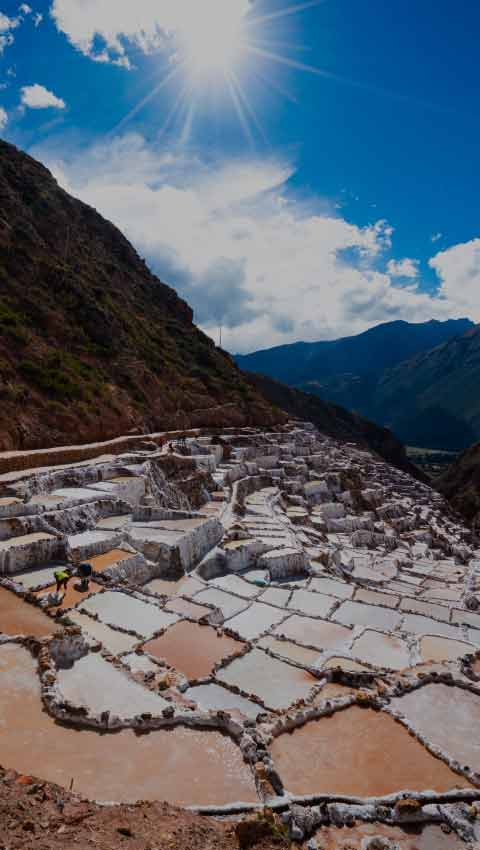
Maras - Moray
The salt of the Andes
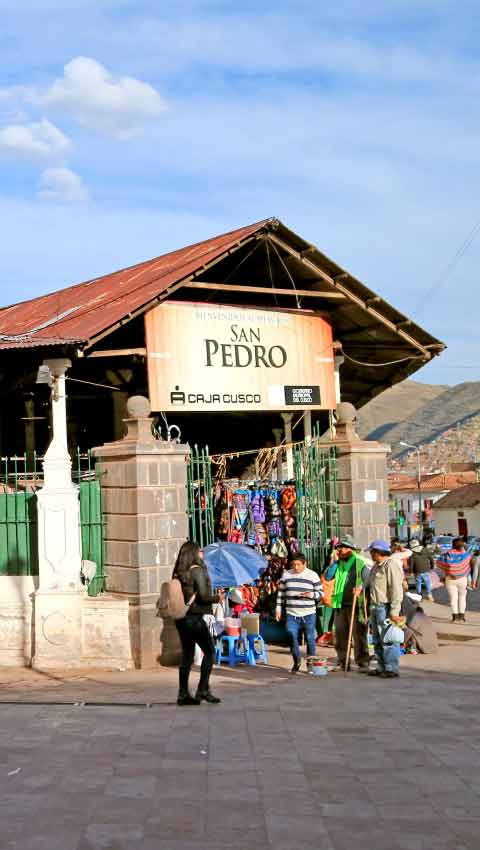
San Pedro market
The imperial city’s main food market
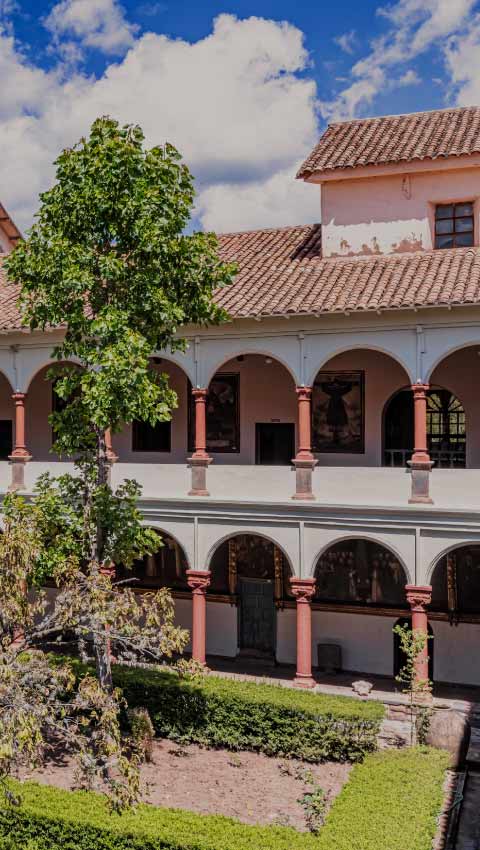
Museums in Cusco
Privileged glimpse of an ancient past
We help you plan your trip!

- Meet the Team
- Work With Us
- Itineraries
- Italy Travel Guide
- Hawaii Travel Guide
- Travel Tips
Attractions
How to plan a trip to machu picchu for first timers.
Visiting Machu Picchu, the ancient Inca city, high up in the Andes of Peru , has always been at the very top of my travel list. Who wouldn’t want to experience the almost mystical “Lost City of the Incas”, situated so high up in the jagged Andes Mountains that it’s unimaginable how it was even built, much less how they survived, and thrived, in such an isolated environment.
It holds the same mysterious appeal as far off ancient civilizations like Egypt and Jerusalem. Machu Picchu is, of course, a UNESCO World Heritage site . A trip to Machu Picchu is much more than just a vacation. It’s a journey. There are many ways that this will be one of the most exciting and fulfilling journeys you’ll ever embark upon.

That’s why we’ve put together these tips for visiting Machu Picchu. You’ll likely fly into Lima from the U.S. and have an overnight stay in the capital city of Lima before going onward to Cuzcu. The stopover is a blessing, because once you reach Cuzco, you’ll need time to acclimate to the altitude, and this task is harder while also dealing with jetlag.
Don’t go in thinking that the journey to Machu Picchu will be an easy one. It can be a very tiring and long journey, all told, with flights, train, bus and walking distance. But don’t be discouraged, because the end goal is well worth it.
Also be aware that the Machu Picchu park administration has made significant changes to the way they deal with tickets and visitors in 2023 moving forward for the preservation and conservation of this UNESCO World Heritage Site. If you’ve been before, things are different now. We’ll explain the changes below.
Machu Picchu is one of the new 7 wonders of the world . These are meant to be some of the most remarkable man-made structures that are still standing around the world, each with a fascinating history and unique design.
» Start planning a trip today with this Perfect 10-Day Peru Itinerary: What to See & Do.
Planning your trip to Machu Picchu?
- Rent a car from Cuzco through Discover Cars .
Where to Stay in Machu Picchu:
- Belmond Sanctuary Lodge – The only hotel located right next to Machu Picchu. A great experience! Read more about it in this review .
- Sumaq Machu Picchu – Located on the river at the base of Machu Picchu. Great location, great experience.
Best Tours and Experiences in Machu Picchu
- Machu Picchu All-Inclusive Day Trip – Includes train, entrance tickets, guide, shuttle bus & private transport.
- Visit Machu Picchu and Machu Picchu Mountain in 2 Days – Discover the history, culture, and energy of the area with roundtrip transfers.
» If you’re planning to see other parts of the country, be sure to check out this backpacking travel guide to Peru for tips and inspiration.
Table of Contents
Changes to Tourist Policy
Machu Picchu has new visiting rules starting in 2023 , including the following:
- The introduction of 5 different circuits to visit the Inca site.
- There are only 4,500 tickets available per day for Machu Picchu.
- All tourists must be led by a tour guide in order to preserve the site.
- Tourist groups can have a maximum of 10 people per guide.
- Reentry to the site is prohibited.
- The guided tour duration is 2 hours in order to free up room for more groups.

Getting Tickets to Machu Picchu
Pro Tip: No tickets are sold at the entrance, so you must secure them in advance. If you’re traveling during high season, I would purchase tickets a month or more in advance, to avoid disappointment.
The easiest possible way to see Machu Picchu is to book a tour from Cuzco. I recommend this tour by ExploorPeru that includes train, entrance tickets, guide, shuttle bus & private transport. You can go from Cuzco all in one day, or go to Agua Calientes to stay the night before, so it’s very flexible.
If you’d rather plan it all yourself, you can buy tickets online through the official government website or authorized agencies. As of 2023, tickets cost 152 soles ($40USD) for adults and 70 soles ($19USD) for children under 18. You’ll be charged a %5 fee to book online.
If you’re looking to hike up Huayna Picchu or Machu Picchu Mountain (Montana), you’ll need a special combination ticket that’s 200 soles for adults (includes Machu Picchu ticket). The Montana ticket allows re-entry to the main citadel, while the Huayna Picchu one doesn’t. If you want tickets for the Huayna Picchu mountain climb, try to buy them at least 3 months in advance because tickets are limited to 200 per day.
Machu Picchu Circuits
The Machu Picchu authorities have implemented specific circuits (or routes) for visitors to follow, aimed at safeguarding the archaeological site for years to come. The path you’ll take depends on the type of ticket you purchase.
Options include a standard Machu Picchu ticket, as well as combo tickets that add on attractions like Huchuy Picchu or the Inca Bridge (same cost), Huayna Picchu Machu or Picchu Mountain (for an extra cost) .
Which Circuit is Best for First-Time Visitors?
We recommendation getting a ‘Machu Picchu only’ ticket and following Circuit 2. This route allows you to tour the upper and lower parts of the archaeological site and includes the main parts of the Inca citadel. It takes about 2 hours and 30 minutes. If this is a return trip, consider doing the ‘Machupicchu with Huayna Picchu’ ticket and taking Circuit 4. If you choose the Huayna Picchu tickets, you can only do Circuit 4.
Here is a really extensive guide on all the circuits if you’re not sure which one to choose.
The Machu Picchu Experience – Start to Finish
Starting out in cuzco.

Cuzco, a UNESCO World Heritage site, is a city located at just over 11,000 ft above sea level in the Peruvian Andes — once the capital of the Inca Empire. It is the main launching point for visits to Machu Picchu. And it’s an authentic and vibrant city.
There is plenty to do in Cuzco, including hiking and adventure tours to nearby archeological ruins, such as the Sacred Valley of the Incas , and the Ollantaytambo ruins you’ll find in the valley, learning about the culture and customs of the Incas, shopping and exploring the ancient city, and dining on new and exciting local cuisine.
» Try this tour: If you’re interested in spending more time in Cuzco and the surrounding area, book one of these tours with ExploorPeru.
- The Best of Cusco in 3 Days : Sacred Valley, Machu Picchu, and Rainbow Valley (from $459/pp)
- The Best of Cusco in 4 Days : Adds on Humantay Lake (from $839/pp)
- The Best of Cusco in 5 Days : Adds on Cusco City (from $879/pp)
» Read more about Cuzco .

Once you land in Cuzco, catch a bus or taxi to the town center and find your accommodations, you’ll want to settle into a routine and get as much rest as possible in order to acclimate to the elevation.
If you’re planning to hike the Inca trail to Machu Picchu, you’ll need to arrive a few days in advance to prepare yourself. The elevation is no joke and symptoms can sneak up on you, so get plenty of rest and drink lots of water and the local remedy, Coca tea.
You can also get altitude sickness pills from your doctor before leaving home or from a local pharmacy, which will help. Really, the best way to acclimate is to slow down. Take it easy and build in time to relax.
» Read about what to eat while you’re in Peru, land of delicious food!
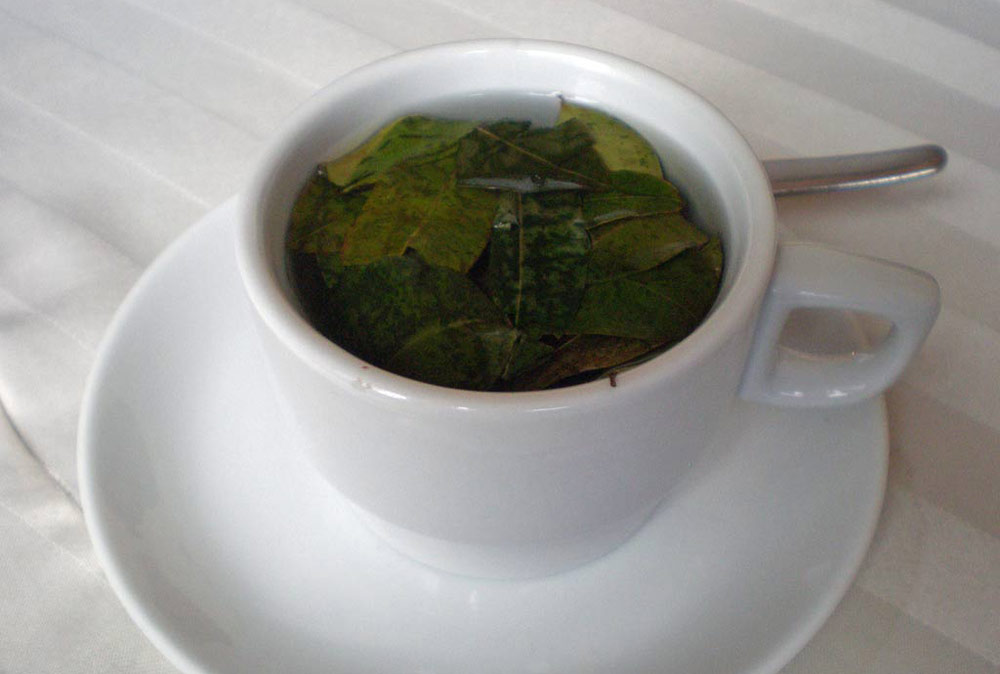
Getting to Machu Picchu from Cuzco
There are several ways to get to Machu Picchu from Cuzco.
- You can book this tour that arranges all the transportation for you (easiest possible way!).
- You can hike the Inca trail, following the route the Incas themselves took to reach the capital city. If you choose to hike, the trail is 26 miles long and trips range in length from one to four days, depending on what side trips are included. Only 200 visitors are allowed passes each day, so plan ahead, and be aware that this is a strenuous hike through a very mountainous region.
- You can buy your own tickets and take the train.

The train is perhaps the easiest way of getting there. When I went, knowing that I didn’t need to spend an enormous amount of time exploring, I chose the day trip option. The train leaves San Pedro station at 6:40am and takes about 4 hours to lumber up the mountain arriving at 10:52am in Aguas Calientes, the town at the base of Machu Picchu, where you’ll catch the bus.
You’ll arrive around 11am at Machu Picchu and have the entire day to explore before returning on the train to Cuzco in the late afternoon. If you’re the type who likes to explore every nook and cranny, you may want to arrive in Aguas Calientes the night before and stay the night to get an early start up to the ruins, which open at 6am.
Another option is from Poroy station, which is a bit further north, which leaves at 6:40am and arrives at 9:54am. The ExploorPeru tour we recommend leaves from this station (saving you an hour on the train!)
Just be sure to plan ahead if you’re visiting in high season, as tickets are limited and you wouldn’t want to be disappointed after having traveled so far. Here’s where to book the train tickets.

Arriving in Aguas Calientes
Once you’ve arrived in Aguas Calientes, the journey up to Machu Picchu begins. You’ll need to catch a bus up to the top, which involves a whole lot of switchbacks and may not be pleasant for anyone who gets car sick. Another option is to walk up, but that is reserved for only the most fit, and it will take about an hour, while the bus takes only 20 minutes.
In high season (July & August), pre-book your bus trip , or risk waiting in an atrocious line (like 2-3 hours long) or being turned away altogether. Once you’ve reached the top, you can embark on a tour of the ancient city.

» Read more: “ That Time We Had Machu Picchu (Almost) To Ourselves ” by Television of Nomads
Book a Tour
What to see in machu picchu.
NOTE: Be aware that there are no toilets in the historic area, so you should go before you enter (there’s one at the gate). If you have to leave to use the bathroom, you will not be able to get back in!
Machu Picchu Sanctuary is the designated area surrounding the famous Inca citadel of Machu Picchu in Peru. Nestled among the peaks of the Andes, this sanctuary serves as both a historical and a natural reserve, covering approximately 32,592 hectares.
It’s not just the stone structures that captivate visitors; the surrounding cloud forest is a biological paradise, hosting a variety of flora and fauna that contribute to the area’s unique biodiversity.

Though the main attraction is, of course, the ancient citadel itself, the surrounding area has a ton to explore. With the new circuits, you will be limited in what you can see based on which circuit you’ve chosen.
- Circuit 1 allows you to visit the upper and lower parts of the archaeological site. This tour goes through the main buildings as well as the area of the terraces, plus the higher up terraces where you can get an iconic photo.
- Circuit 2 includes the main buildings on the citadel, plus the upper and lower parts of the archaeological site.
- Circuit 3 allows you to visit the lower main plaza of Machu Picchu, plus a visit to the Inka House, the Temple of the Sun, the Water Mirrors and the agricultural area.
- Circuit 4 includes the lower main plaza of Machu Picchu, plus a visit to the Inka House, the Temple of the Sun, the Water Mirrors, the agricultural area, and the Sacred Rock.
Main Attractions
- The Temple of the Sun : One of the most important structures, this rounded building served astronomical and religious purposes. You’ll notice its intricate stonework, as well as windows perfectly aligned with the solstices.
- Intihuatana Stone : Also known as the “Hitching Post of the Sun,” this carved rock was used for astronomical observations. It’s situated on a small hill and offers a panoramic view of the entire complex.
- Room of the Three Windows : This structure, part of the Sacred Plaza, showcases the Inca’s mastery of masonry with its trapezoidal windows and massive stones.
- The Main Plaza : This central courtyard is surrounded by temples, residences, and storehouses. It was likely a social or ceremonial gathering place and offers some of the best photo ops.
- Temple of the Condor : This fascinating temple is designed to represent a condor, a sacred bird in Inca culture. The stone “wings” and “head” are immediately recognizable, making it a must-see.
- Agricultural Terraces : These are not just for show. The terraces were a functional part of Inca agriculture but now add to the breathtaking visual geometry of the site.
- The Watchman’s Hut : Right after you enter, you’ll find this small structure offering a classic, postcard-worthy view of the whole Machu Picchu complex. Most people stop here first for that iconic photo.
- Royal Tomb : Located near the Temple of the Sun, this area features a series of caves that were likely used for mummification or other ceremonial practices.
- House of the High Priest : This is a two-story building that might have been the residence for the spiritual leader or high priest of Machu Picchu.
- Temple of the Three Doors : Another part of the Sacred Plaza, this temple features a three-door entrance and showcases fine Inca craftsmanship.
Just remember, Machu Picchu isn’t just about ticking off the major sights; it’s about taking in the atmosphere and pondering the mysteries.
Where to Stay in Cusco
Cuzco welcomes many visitors every year, so they know how to do it right. You have a tremendous amount of choices for where to stay in this lovely city, including some pretty nice hostels. However, our days of hosteling are over, so we’re looking for an affordable luxury stay in Cuzco.
Here are our top choices, all right in the center of town for easy walking to the square, the market, and the bus/train station. You can check out prices, read reviews, or book directly through the links below.
- JW Marriott El Convento – this is a beautiful property really close to the main square and cathedral – Check prices on Expedia | Read reviews on TripAdvisor .
- Palacio del Inka – This is a Luxury Collection Hotel. It’s in the perfect location, and it’s very beautiful inside, with incredibly comfortable beds – Check prices on Expedia | Read reviews on TripAdvisor .
Where to Stay Near Machu Picchu
There are quite a few advantages to staying near Machu Picchu. You’ll have more time to explore and look around, and you’ll beat the crowds who are coming from Cuzco. Take advantage of this by booking a room for a night or two.
We recommend the following nearby hotels. If you’re adopting a “once-in-a-lifetime-experience” attitude about your trip to Machu Picchu, then you should stay at one of these two hotels:
- Belmond Sanctuary Lodge – The only hotel located right next to Machu Picchu. A great experience! Book on Expedia. Read more about it in this review .
- Sumaq Machu Picchu – Located on the river at the base of Machu Picchu. Great location, great experience. Book on Expedia
These are equally great hotels, but you won’t have to spend quite as much:
- Casa del Sol Machu Picchu – Beautiful property, very close to the train station Book on Expedia
- Inkaterra – Hotel offers eco tours. Breakfast and dinner are included in the price Book on Expedia
Pro Tip: If you choose a hotel near the train tracks (which is most of them) be sure to ask for a room on the opposite side of the hotel from the train, or you’ll hear and feel the trains lumbering by until the early morning.
Useful Tips for Visiting Machu Picchu
Here are some useful tips and things to expect once you arrive at Machu Picchu:
- Pack a sweater and/or rain jacket. The weather can change quickly from sunshine to fog, wind and rain. Choosing the best time to go to Machu Picchu can be a challenge, as you need to consider factors such as weather, crowds, and overall travel experience.
- You technically can’t take drinks or food into the site, but do take water and a snack in your bag anyway. They often don’t check your pack.
- Plan to skip lunch. Eat a big breakfast so you can avoid eating an expensive lunch on site or wasting time going back to Aguas Calientes in the middle of your day.
- Buy your train tickets and Machu Picchu tickets in advance online to avoid disappointment, especially during high season (April – August).
- You can get your passport stamped at the tourist office once you arrive at Machu Picchu, not far from where the bus drops off.
- Don’t underestimate altitude sickness. Take it easy, don’t overexert yourself.
Frequently Asked Questions
Can you visit machu picchu on your own.
Yes, it is possible to visit Machu Picchu on your own. While having a guided tour to enter Machu Picchu is not mandatory, it’s highly recommended. Guides provide valuable insights into the history and significance of the site. Guided tours can be arranged in advance or hired on the spot at the entrance. Remember to purchase your tickets in advance and check current rules and regulations, as respect for the environment and historical site is essential.
How many days do you need to visit Machu Picchu?
Ultimately, the duration of your visit to Machu Picchu depends on your interests, the type of experience you want, and how much time you have available. Remember that it’s a UNESCO World Heritage site, and many visitors find that spending more time in the area allows for a richer and more enjoyable experience. That being said, most visitors go for just one day.
How difficult is it to visit Machu Picchu?
Visiting Machu Picchu can be as easy or as challenging as you choose to make it. You can choose train and bus transportation if you prefer a more comfortable and straightforward experience. However, if you enjoy trekking and are physically prepared, you can choose one of the trekking routes. Regardless of your choice, it’s essential to plan ahead, be aware of the altitude.
What is the best month to go to Machu Picchu?
If you prioritize good weather and are okay with crowds, the dry season from May to September is the best bet for your trip. However, if you prefer quieter visits, you might consider the shoulder or rainy seasons if you’re prepared for wetter conditions. Keep in mind that weather patterns can vary from year to year, so it’s a good idea to check the latest weather forecasts and travel advisories before planning your trip.
Visiting Sacred Valley, Peru
Most visitors to Cusco and Machu Picchu like to also visit the Sacred Valley on their trip. It’s an essential experience if you’re intrigued by Inca history or just looking to witness some of the most stunning landscapes in Peru.
The Sacred Valley of the Incas is located in the Andean Highlands of Peru, not far from the ancient city of Cusco. This valley stretches approximately 60 kilometers and is framed by steep, terraced mountains.
It’s a region rich in history and culture, dotted with archaeological sites like Ollantaytambo, a well-preserved Inca urban center with a massive fortress with huge stone terraces, and Pisac, known for its impressive Inca ruins and vibrant market..
Getting to the Sacred Valley from Cusco is fairly straightforward. You’ve got several options: you could go by taxi, take a colectivo (shared van), or opt for a guided tour. Taxis offer the most flexibility, but colectivos are more budget-friendly. Guided tours usually provide comprehensive packages including transportation, guides, and sometimes meals.
Traveling in Peru is a very rewarding experience, and getting the opportunity to see Machu Picchu is one of the highlights. Take your time, look around, discover something new. Most of all, have fun!
Be Prepared For Travel Planning is the most important part of any successful trip. Do it the easy way:
🧳 Travel Packing List | ✔️ Why You Need Travel Insurance | ✈️ What to Do Before You Leave Home
- Find and book the best hotel (our favorite booking site is Expedia)
- Research flight options (our favorite tool is Skyscanner )
- Book a tour (we always use Viator to find the best tours)
- Rent a car through Discover Cars (they search the best deals for you!)
YOU MIGHT ALSO LIKE

13 Essential Foods to Try in Peru

Americans Traveling to Cuba – Your One-Stop Travel Guide

9 Food and Drinks You Must Try in Brazil

3-Day Mexico City Itinerary for Food Lovers
Like this post? Why not save it on your Pinterest board?
Quick. Check these necessities off your prep list!
- There’s no one-size-fits-all travel insurance . Get a personalized quote from Yonder .
- The right luggage can make or break your trip. These luggage sets make traveling a breeze.
- Find your rental car on DiscoverCars.com . They search all major rental companies to find the best deal.

Laura Lynch, creator and writer of Savored Journeys, is an avid world traveler, certified wine expert, and international food specialist. She has written about travel and food for over 20 years and has visited over 75 countries. Her work has been published in numerous guidebooks, websites, and magazines.
5 thoughts on “ How to Plan a Trip to Machu Picchu For First Timers ”
Great tips and awesome pictures! Thanks for sharing!
Great post and photos. My husband and I were also at Machu Picchu earlier this year. Good tips about the altitude sickness, glad we read about that before hand, we got some meds that worked like a charm. I was, just looking around to find some other opinions, glad I found your blog. Check me out too: http://www.cameraandcarryon.com
It’s a great idea to go with some meds that will help with the altitude sickness, especially if you know you don’t adapt well. We were able to pick up some from a pharmacy in Cuzco.
Great article! In my opinion the best way into Machu Picchu is via Ollantaytambo. Skipping the ruins there is a big mistake in my opinion. Train tickets from Ollantaytambo are cheaper as well! 😀 As far as I am concerned, altitude sickness should be no problem in Machu Picchu itself (tho Cusco is 1,000 meters higher and there u will need it).
I never considered the altitude sickness, and I think that not overexerting myself is a good tip. My sister and I are planning to visit Machu Picchu for the first time, and we want a unique experience. I suffer from asthma so we will need to contact a travel guide to help us customize our experience.
Leave a Reply Cancel reply
Your email address will not be published. Required fields are marked *
Save my name, email, and website in this browser for the next time I comment.
- Travel Resources
Protect Your Trip »
Machu picchu tours: how to get there and tips for visiting.
Here is everything you need to know to plan a trip to Machu Picchu.

How to Get to Machu Picchu

Getty Images
A hike around Machu Picchu is a must-do if you're visiting Cusco, Peru.
Note: Some of the below destinations may be affected by the civil unrest in Peru. Check with the U.S. Department of State before traveling.
Machu Picchu is thought to be one of the largest and most impressive Incan cities of its time. Today a UNESCO World Heritage Site with expansive ruins open to visitors, it sits high on a peak in the Peruvian Andes and is accessed via train or on foot. Here are some tips to help you navigate a visit to this incredible archeological site.
What is Machu Picchu? Machu Picchu is a 15th-century Incan city that was abandoned by the Incas after the Spanish conquest. The ruins feature about 200 structures that were used for religious, agricultural, astronomical and ceremonial purposes, though exactly how remains a mystery. It's believed that between 300 and 1,000 people inhabited the city and the area was devoted to the worship of the sun god.
Where is Machu Picchu? Machu Picchu is located in the Peruvian Andes within a tropical mountain forest at nearly 8,000 feet above sea level. Cusco , the nearest major city, is less than 50 miles southeast of Machu Picchu.
When was Machu Picchu built? Historians believe that Machu Picchu was built in the 15th century.
How do you get to Machu Picchu? Machu Picchu can be reached a variety of ways, including hiking the Inca Trail with a tour company, by train or by bus.
When is the best time to visit Machu Picchu? The site is located in the Amazon rainforest in Peru, where the rainy season runs from November to March. To avoid rain, travelers may want to visit during its dry season from April to October. Travelers say that June through August tends to be the busiest, so opting for shoulder months like May or October may help avoid crowds.
Know Before You Go
- What: Machu Picchu tours
- When: Machu Picchu is accessible daily with entrances from 6 a.m. to noon or noon to 5:30 p.m. During the month of February, the Inca Trail is closed for maintenance and is inaccessible to visitors.
- Cost: Entrance tickets cost approximately 152 Peruvian soles (about $45) for adults; 77 soles (around $23) for students.
- Must-know tip: To tour Machu Picchu, you must purchase your ticket online in advance and print it out as no tickets are sold at the site. Experts and fellow travelers recommend purchasing your ticket several months in advance as there only 2,500 visitors allowed per day. If you choose to visit with an organized tour company, the company will take care of reserving and purchasing the ticket for you.
- Website: https://www.machupicchu.gob.pe/inicio
When visiting Machu Picchu, you will be given a specific time you can enter the site. Key attractions include the Temple of the Sun, the Room of the Three Windows, the water irrigation system and the Royal Mausoleum. There is an additional fee to visit the mountains of Machu Picchu and Huayna Picchu, which surround the old city, should you want to hike trails there. After you purchase your ticket – either to Machu Picchu or the site with one of the mountains – be sure to print your ticket and bring it with you along with identification, such as a passport.
Restrooms are located outside the entrance and cost about 2 soles (around 60 cents) to use; there are no restrooms within Machu Picchu. There's no visitor center, but Peru's Ministry of Culture does have an office in Aguas Calientes, a town that acts as the gateway to Machu Picchu. There are also a variety of restaurants in Aguas Calienties to refuel after your trip. Be aware, you also may not be allowed to bring single-use plastics (like sandwich bags) or large bags into the site. If you do bring a large bag, there is a bag storage facility near the site's entrance where you can leave your bag for a small fee as you explore the site.
Machu Picchu is located less than 50 miles northwest of Cusco, a Peruvian city which is also a UNESCO World Heritage Site. Cusco can make a great base for your visit to Machu Picchu as many organized tours to the site begin here.
Since Machu Picchu and Cusco sit at high elevations, almost 8,000 feet above sea level, travelers should prepare for altitude sickness. Talk to your doctor before your trip to make sure your body can handle the altitude change. When you arrive, help your body adjust by getting plenty of rest for the first few days, avoiding alcoholic beverages and drinking lots of water to remain hydrated. You should also plan to wear insect repellent and plenty of sunscreen for the trek. Travelers also recommend dressing in layers and wearing pants and long sleeves, even if the weather is warm, as the mosquitos are known to be relentless.
Tour Options
Though you can opt to visit Machu Picchu (and make the necessary travel arrangements) by yourself, a guided tour can help streamline the process. Multiple tour operators offer daytrips to Machu Picchu. The majority of these tours originate in Cusco and leave early in the morning (at or before 5 a.m.). You'll be taken via bus to the town of Ollantaytambo, where groups board trains to Aguas Calientes. From Aguas Calientes, groups board a bus to Machu Picchu. Travelers generally spend approximately two hours at the site before they begin the trip back to Cusco. Exact tour prices vary, though you can expect to spend approximately $300 per person (including train tickets, bus fare and a guided tour of the site). Travelers generally enjoy the tours, extolling the knowledgeable guides, and appreciate the ease by which they could see Machu Picchu. Others caution selecting your tour company carefully as experiences can vary wildly from company to company.
Travelers can also opt to hike from Aguas Calientes to Machu Picchu on their own via the Carretera Hiram Bingham. The approximately 4-mile journey is a steep climb and can be completed in around 90 minutes. Though an option, most travelers say the walk is long, difficult and lacking in scenery.
Tourists who have ample time, or have a true adventure streak, can hike the Inca Trail to Machu Picchu. The approximately 25-mile trail takes about four days to hike and ends at Machu Picchu. To hike the Inca Trail, you must go with a tour company or hire a guide, as it is no longer permitted to hike the trail on your own. Keep in mind that the trail closes each February for maintenance. Tours can last as little as two days (for an abbreviated journey along the trail) or more than a week to experience additional Peruvian sites.
There are a variety of other attractions and ancient sites nearby Machu Picchu that you may want to add to your itinerary. Titicaca Lake, located at more than 12,000 feet above sea level, is the largest lake by volume in South America. The town of Cusco also has much to see, including cathedrals , temples and a plaza used in Incan times , along with many archeological sites. Take advantage of the Cusco Tourist Ticket (also known as Boleto Turistico del Cusco), which grants access to many of Cusco's attractions for one fee.
Getting There
You can reach Machu Picchu by foot, train or bus, though if arriving by train, your ride will end in Aguas Calientes and you will need to ride a bus or hike approximately 4 miles to access the site. You can take a train from one of several stations near Cusco to the city of Aguas Calientes and then ride a bus to Machu Picchu. (Note: Since these train stations are outside Cusco city proper, you'll need to take a bus to get to them). The train ride via Peru Rail takes about four hours and you can choose from a variety of train types, each with a different price point to accommodate any travel budget. Tickets for Peru Rail are available at PeruRail.com.
You can buy bus tickets from Aguas Calientes to Machu Picchu in advance in Cusco at the Consettur offices, which helps you avoid lines at the actual bus stop. Buses depart from Aguas Calientes approximately every 15 minutes beginning at 5:30 a.m. daily until 3:30 p.m. Visitors recommend getting in line for the bus several hours before your scheduled entrance time at Machu Picchu as lines can be extremely long. Some travelers report getting in line three hours before their scheduled entrance time. You'll also likely encounter lines to take the bus from Machu Picchu back to Aguas Calientes.
Additional tour options:
- CuscoPeru : Full-Day Private Machu Picchu Guided Tour from Cusco. View & Book Tickets »
- Viajes Pacifico : Machu Picchu Day Trip. View & Book Tickets »
- Viajes Peru : Day Tour to Machu Picchu The Inca City. View & Book Tickets »
- Machupicchu Latin America : 2-Day Tour: Sacred Valley and Machu Picchu by Train. View & Book Tickets »
- Inkayni Peru Tours : Full day. View & Book Tickets »
Looking for more information on Machu Picchu? Check out the U.S. News Travel Cusco guide .
Tags: Tours , Travel , Vacations , Peru
World's Best Places To Visit
- # 1 South Island, New Zealand
- # 4 Bora Bora
If you make a purchase from our site, we may earn a commission. This does not affect the quality or independence of our editorial content.
You May Also Like
The best weekend getaways from nyc.
Alissa Grisler and Jessica Colley Clarke Sept. 5, 2024

The Best Beach Resorts in the World
Sept. 5, 2024

The Best Rome Food Tours
Laura Itzkowitz Sept. 4, 2024

Top Things to Do in Hershey, PA
Amanda Norcross Aug. 30, 2024

The Best College Town Hotels
Rachael Hood Aug. 29, 2024

Fun Fall Weekend Getaways
Aug. 29, 2024

Best Hoover Dam Tours from Las Vegas
Holly Johnson and Ann Henson Aug. 29, 2024

The Best London Tours
Kim Foley MacKinnon Aug. 29, 2024

The 18 Best Barcelona Tours
John Rodwan Aug. 28, 2024

Best Fall Family Vacations
Aug. 27, 2024

- Central Asia
- Southeast Asia
- Eastern Europe
- Western Europe
- Central America
- South America
- Middle East
- North America

Exploring Machu Picchu: An Essential Guide for First-Time Visitors
Whether you’re planning to hike the classic Inca Trail or arrive by train, this guide will help you make the most of your visit to the Lost City of the Incas.

Machu Picchu, the crown jewel of the Inca Empire, beckons adventurers from across the globe. This UNESCO World Heritage site, nestled high in the Peruvian Andes, offers a glimpse into an ancient world that continues to captivate and inspire. Whether you’re planning to hike the classic Inca Trail or arrive by train, this guide will help you make the most of your visit to the Lost City of the Incas.
Planning Your Visit
The time of year to go is everything when planning. So, when should you go to Machu Picchu? The site has two distinct seasons: a dry period from May to October and a rainy season from November to April. While the dry season can offer clear skies and fewer precipitations, it is the peak tourist season. The rainy season can be wet, yet offers a unique perspective with lush greenery, along with fewer crowds.
Well, if you want to avoid the peak months, then April to May and September to October are considered the shoulder season. These Months usually balance decent weather conditions with visitor numbers.

Getting There

a Machu Picchu train brings you to a scenic train ride through the Sacred Valley, following the Urubamba River. There are comfortable trains that offer varying levels of luxury and panoramic views.
The classic Inca Trail is a 4-day trek, but there are also alternatives like the Salkantay mountain route.
A budget-friendly option from Cusco to Aguas Calientes town, the gateway to Machu Picchu.
For those short on time, day tours are available, though they can feel rushed given the site’s vastness.
Tickets and Entry
Machu Picchu tickets are limited and should be purchased well in advance. There are various types available:
- Machu Picchu only
- Machu Picchu + Huayna Picchu mountain
- Machu Picchu + Machu Picchu Mountain
Each ticket has a specific entry time to manage crowds. The site opens at sunrise, and early morning visits often provide the most magical experience.
Exploring the Machu Picchu Citadel
As you pass through the Sun Gate, the magnificent ruins of Machu Picchu unfold before you. The site is divided into several key areas:
Agricultural Sector
Here, you can marvel at the ingenious terraced fields.
Urban Sector
Explore the residential areas and imagine daily life in this remote stronghold here.
Sacred District
Here, you can visit the Temple of the Sun and other religious structures.
Industrial Sector
Discover where skilled Inca artisans once worked here.
Key sites within the ruins include:
The Intihuatana Stone
This site is a ritual stone believed to have been an astronomical calendar.
The Room of the Three Windows
This site offers stunning views of the surrounding mountains.
The Main Square
Here, you’ll find a vast open area likely used for important gatherings.
The Temple of the Condor
You’ll see a fascinating example of Inca stonework here.
For the adventurous, climbing Huayna Picchu offers breathtaking views of the citadel and surrounding landscape. However, tickets for this hike are limited and sell out quickly.
Beyond Machu Picchu
The Machu Picchu is full of secrets up to this day. So, while the ancient citadel is the main attraction, the surrounding area actually offers much to explore:
Sacred Valley
This site is dotted with traditional markets and lesser-known Inca sites.
Aguas Calientes
The nearby town also offers hot springs perfect for relaxing after a long day of exploration.
The former capital of the Inca Empire is worth several days of exploration itself!
Rainbow Mountain
The Rainbow Mountain is a colorful geological wonder, accessible as a day trip from Cusco.
Practical Tips
These practical tips are essential for ensuring a safe, enjoyable, and respectful visit to explore Machu Picchu.
Machu Picchu sits at about 2,430 meters (7,970 ft) above sea level. Spend a few days in Cusco (3,399 meters/11,152 ft) to acclimatize before your visit.
The dry season (May to October) offers the best weather, but also the biggest crowds. The rainy season (November to April) is less crowded but wetter.
What to Bring
During your visit, make sure to bring the following:
- Sturdy walking shoes
- Layers of clothing
- Sun protection
- Insect repellent
- Water and snacks
- Your passport (required for entry)
Consider hiring a knowledgeable guide to enrich your experience with insights into Inca culture and history.
While many guides speak English, learning a few phrases in Spanish or Quechua (the local indigenous language) can enhance your experience.
Showing Respect
As an archaeological site and sacred place, it’s crucial to follow all rules and guidelines to help preserve Machu Picchu for future generations.
By following this advice, you’ll be better prepared for the unique challenges of exploring an ancient citadel high in the Andes. Remember, a well-prepared traveler not only has a more fulfilling experience but also contributes to the preservation of this irreplaceable wonder for future generations.
Machu Picchu represents the ultimate testimony to ingenuity and spirit that was the Inca Civilization. Being part of the New Seven Wonders of the World, this place doesn’t only offer great views but also time travel, ancient engineering, and spirituality all mixed into one. Whether one feels the pull of history, the challenge of the Inca Trail, or the aesthetic beauty of the Andean landscape, Machu Picchu is one of those few places on earth that promise an encounter that will continue to enrich travelers’ lives long after they have come down from its mist-shrouded peaks.
About the Author: Other Voices
Leave a Comment
Previous post: Enhancing Boat Safety and Accessibility: The Role of Quality Doors, Hatches, and Lids
- Dmytro on Undertaking a Medical Procedure in a Foreign Country: 6 Legal Tips You Must Know
- VBJ on Why Frontier Is America’s Worst Airline
- McD Coffee on Sydney McDonald’s Rude Awakening
- Jack on Why Frontier Is America’s Worst Airline
- VBJ on Panama’s Election: Cities Are Lonely Places Without Bars
Post Stream
Why frontier is america’s worst airline.
In a country that’s becoming known for poor air travel service, this airline is the worst of them all.
Why Airports And Flying Have Become So Bad
The great air travel race to the bottom.
On Going To The Gym While Traveling
Working out has always been a part of my travel routine, but now it’s turned it into a conduit for exploration.
Panama’s Presidential Election May Portend What Will Happen With Trump In The USA
A backfire of unprecedented proportions?
Panama Is An Expensive Place To Be A Tourist
Turn tourist here and pay the price. Literally.
On How Places Change: Panama City
I violated the Laws of the Three Nothings and found myself on the something train.
Panama’s Soberanía National Park, Bird Dorks, And The Man Who Had Nothing
A short journey into the rainforest.
Gamboa: A Portrait Of Panama Canal Zone History
A journey to the end of the road.
On Visiting The Miraflores Locks Of The Panama Canal
The ditch that changed the world.
Veracruz Beach Shows What Panama Is Made Of
Want to look into the core of a culture? Go to the beach.
Ghost Cities of China

Change location
- UK / International
- Call toll-free from 10am EDT
- 617-223-4521 617-223-4920 or
- REQUEST A QUOTE
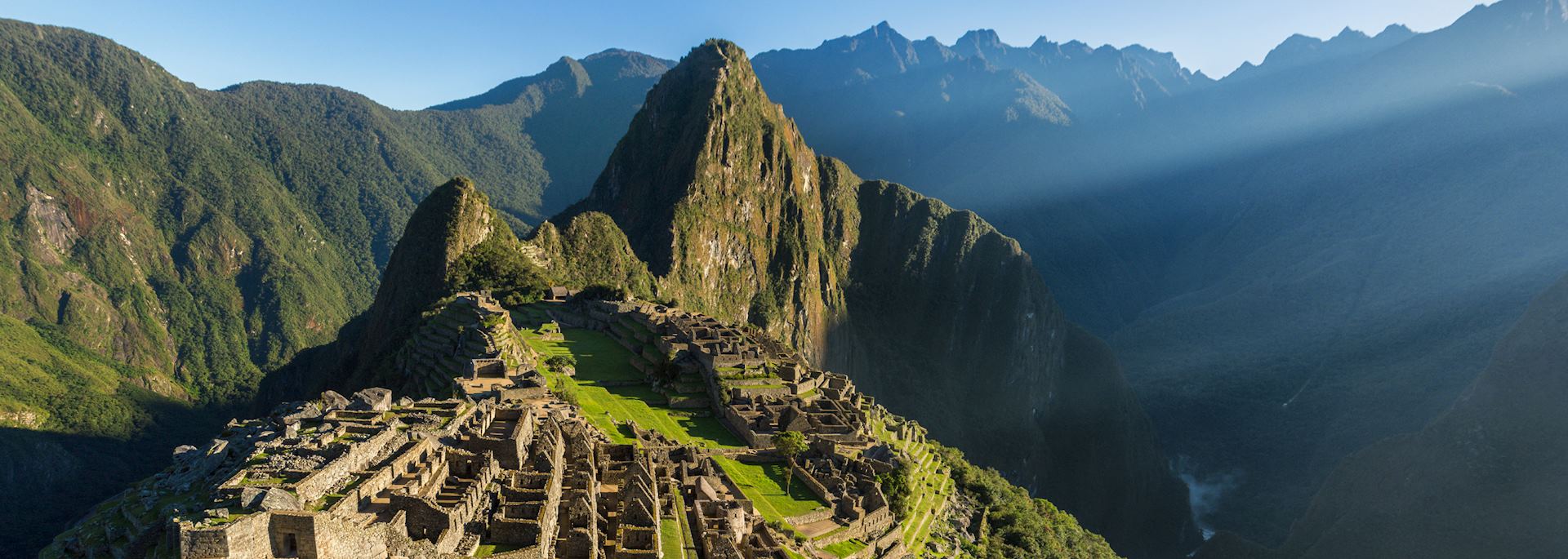
Visit Machu Picchu: A first timer's guide
- Machu Picchu
By Peru specialist Nik
Just shy of 600 years ago, a small plateau between two lushly forested peaks high in the Andes became a building site for the Inca Empire’s greatest city.
This citadel in the clouds was abandoned only 100 years later but Spanish invaders never found Machu Picchu. It was left to nature before explorer Hiram Bingham caught wind of it on an expedition in 1911 and decided to investigate. A hidden city protected by the mountains, and still wonderfully inaccessible other than by foot or train, Machu Picchu is now a New Seven Wonders of the World .
My Machu Picchu highlights
I’m often asked if Machu Picchu really lives up to its name. The emphatic answer is yes, and for two reasons.
Firstly, its buildings — the temples, palaces and houses — are in a remarkable preserved state. The Spanish never ventured up the mountains and so left it untouched.
Moreover, each time I visit Machu Picchu I’m bowled over by the setting. Out of view from the valley, you hear the roar and churn of the Urubamba River 500 m below. A protective wall of mountains surrounds you, which fades in and out of view as the mist falls and lifts. You have the distinct feeling of being high up in the world and part of a very well-kept secret.
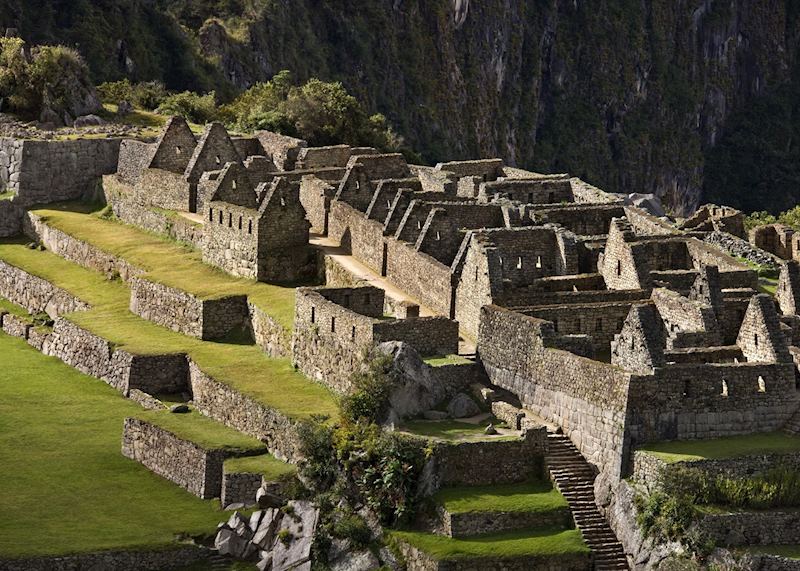
Three of my stand-out highlights
The intihuatana stone.
This carved pillar on a square stone base remains a testament to the Incas ’ knowledge and skill as astronomers. The name translates to the 'hitching post of the sun'. The corners point to the four cardinal points, and the stone still accurately indicates the positioning of the sun. If you happen to be watching at noon on either equinox, you’ll notice the stone’s shadow disappear for just a moment, as designed by its creators.
The Royal Tomb
This cave-like building is thought to be where sacrificial or burial rituals were performed, and there have been more than 100 skeletons excavated here. Just to the left of the tomb lies a series of ceremonial baths fed by a sophisticated aqueduct system — another reminder of the impressive masonry skill of the Incas.
Climb Huayna Picchu
You can climb Huayna Picchu, the witch’s hat of a mountain that stands guard behind Machu Picchu, as long as you book it well in advance as part of your admission ticket. Your ticket will show your allocated time slot to start the walk, and it takes about an hour to reach the top.
I wouldn’t recommend it if you don’t like heights — the last stretch of path narrows with no barrier to separate you from the edge. The reward comes from the view at the top, which our guides generally agree is the best place to see Machu Picchu from above. You could opt to climb part of the way to still get the knock-out view, albeit from a lower level.
Video: Our expert tips for visiting Machu Picchu

Machu Picchu: a first timer's guide
A first timer's guide to Machu Picchu.
Where to stay in Machu Picchu
I’d highly recommend an overnight stay at Machu Picchu or Aguas Calientes if you want to get up to experience the ruins early the next morning.
The Machu Picchu Sanctuary Lodge is the only hotel close to the entrance of Machu Picchu, a mere stroll away. Staying here ensures you’re best placed to avoid traveling time at the start and the end of the day, though this convenience comes at a considerable price tag.
Aguas Calientes has a good range of hotels. The buses start to roll out of town up to Machu Picchu early enough for you to arrive just after the gates open, and well ahead of visitors coming by train. Staying locally also is helpful if you want to visit the site more than once. Mist clinging to the peaks can be completely bewitching, but visibility can be changeable 2,450 m above sea level. A second visit can give you a completely different set of conditions to enjoy as you explore the architecture, and time to climb Huayna Picchu.
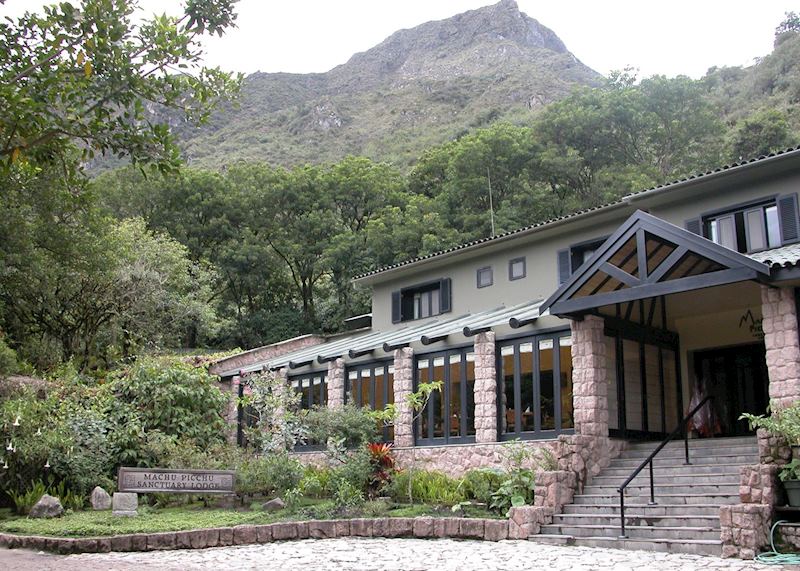
How to get to Machu Picchu
Your most common route to Machu Picchu is flying into Peru’s capital city, Lima , before transferring to an internal 1h 15m flight to Cuzco .
Cuzco sits at the base of the Andes in the southeast of Peru. It was the capital of the Incas and is the leaping-off point for Machu Picchu and the Sacred Valley , the one-time heartland of the Inca Empire. You can reach Machu Picchu from Cuzco on the train or by trekking.
A small town, Aguas Calientes, has sprung up in the valley below Machu Picchu. It serves as the disembarking point for the train or a gathering place after you’ve completed the Inca Trail and descended from Machu Picchu.
From as early as 5am buses leave here to travel up the windy road cut into the mountainside to the entry gates of Machu Picchu.
When is the best time of day to visit?
Machu Picchu is often busiest between 11am and 3pm when most train and bus visitors arrive, so the opportunity to see the site in the morning or at dusk could allow you to have a more meditative experience and better light for photography.
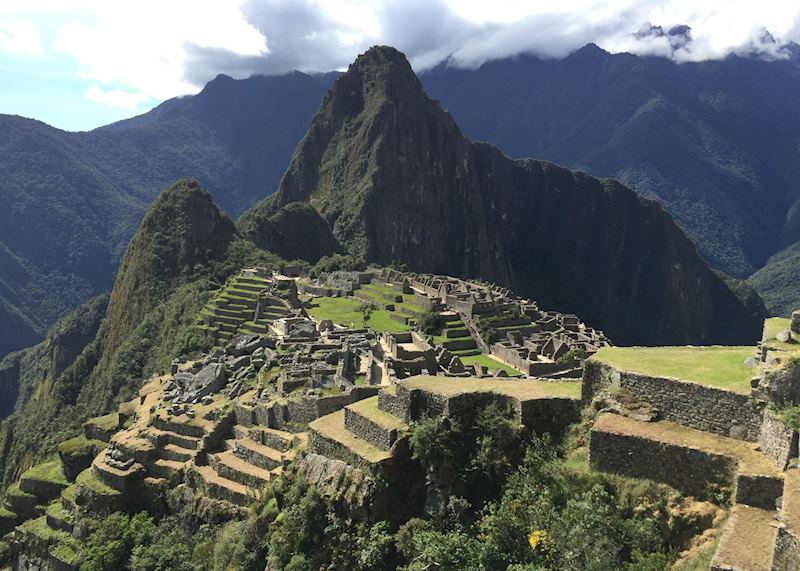
Machu Picchu by rail
The train journey from Cuzco to Aguas Calientes offers you the chance to see dramatic, natural scenery as you make your way through lush valleys and past rugged peaks, following the course of the Urubamba River.
There’s a variety of rail services, from regular carriages with comfortable seating, Vistadome services with panoramic windows through to the luxury Hiram Bingham train with fine dining and entertainment.
You can break up your journey mid-point by stopping or staying overnight at Ollantaytambo in the Sacred Valley, once an important administrative center for the Incas. The remnants of a sturdy fortress, complete with terraces, dominates the town. You would travel into the valley by road and then take the train from Ollantaytambo to Machu Picchu.
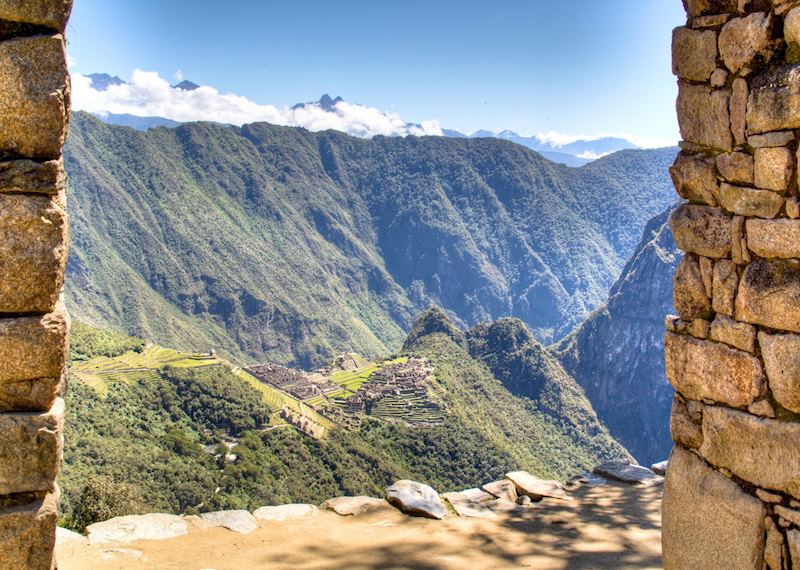
Machu Picchu by foot
Trekking vacations to Machu Picchu are ideal if you want to immerse yourself fully in the hugely varied landscape of snow-capped mountains, sapphire lakes, terraced fields and emerald-forested slopes.
Our guide on trekking vacations in Peru introduces a range of routes and distances so you can find a trip that’s tailored to your fitness level, the number of days you have available to explore and your preferred accommodation.
With group and private treks ranging from 1 to 12 days, you can cover the Inca Trail, Salkantay (known as the ‘alternative Inca Trail') or the Mountain Lodges of Peru route at a pace that suits you once you’ve had time to acclimatize to the altitude.
There are regulations restricting the number of walkers allowed on the Inca Trail. Only 500 people are allowed to start the Inca Trail trek to Machu Picchu each day, and this includes the porters. Permits sell out notoriously far in advance, so it’s essential to plan your trip as early as possible if you want to walk the Inca Trail.
A little note on altitude
Machu Picchu stands at around 2,450 m above sea level, and Cuzco at 3,400 m. At these heights, there’s 20 per cent less oxygen in the air. In the vast majority of cases, symptoms of altitude sickness are very mild (a little sleepiness or a slight fuggy head) and wear off after a day or two, but it can make doing anything energetic feel like a struggle.
Our Peru specialists can give you personalized recommendations about how to acclimatize ahead of your trek and combat any altitude sickness during it.
Travel insurance for Machu Picchu treks
It’s important to check whether your travel insurance will cover you for treks at altitude, especially if you’ve previously bought a policy to cover you for a number of trips throughout the year. It’s possible to buy specialist trekking travel insurance, and this tends to fall into pricing categories based on the altitude and length of the trek you wish to take on.
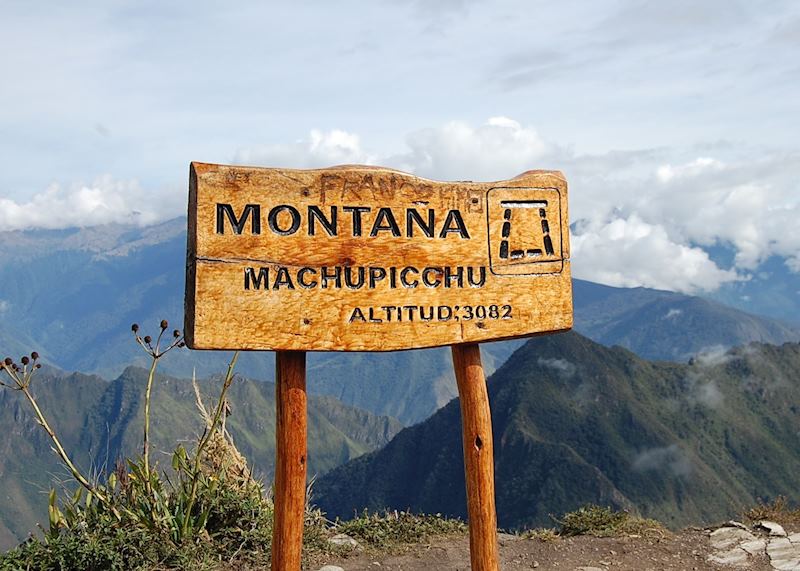
Where to eat at Machu Picchu
Aguas Calientes has a plentiful selection of restaurants to suit your tastes and wallet. One of our current favorites is Indio Feliz, an award-winning restaurant serving Peruvian dishes with a French twist tucked away in a side street.
You can also try Peruvian street food if you time it right. Every Sunday, slow cooked chicharrones (hog roast) is sold until it’s all gone. I tried it on a recent trip and the meat was amazingly succulent, with the best crackling I’ve ever tasted.
The best time to visit Machu Picchu
July and August is peak season, when the highest number of visitors are taking on the Inca Trail or wandering around Machu Picchu.
The Andean foothills are at their driest at this time of year too, with the rainy season taking place between November and March.
We favor visiting throughout the dry months of April to October, but it’s worth avoiding the July and August peak period if you’re not tied to traveling at this time.
It should be noted that the Inca Trail is closed to walkers during the month of February so restoration work can take place.
Trips to Machu Picchu
We’ve created a selection of itineraries that visit Machu Picchu as well as some of Peru's other highlights.
I’d suggest you need at least 9 days in Peru to take in Machu Picchu and the surrounding Incan ruins, with time to explore Cuzco before or after.
With a little extra traveling time you can extend your journey to cover time in the Peruvian Amazon , Lake Titicaca or the Colca Valley.
Tailor-make your trip to Peru
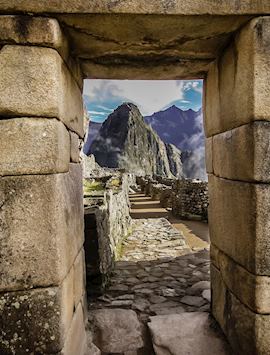
Discover Machu Picchu
8 days from $7,500pp

Luxury Peru tour
13 days from $12,750pp

Icons of South America: Cuzco, Machu Picchu, Iguaçu Falls & Rio
11 days from $13,450pp
Start thinking about your experience. These itineraries are simply suggestions for how you could enjoy some of the same experiences as our specialists. They're just for inspiration, because your trip will be created around your particular tastes.
Further reading
- Trekking to and around Machu Picchu
- Peru’s Inca wonders beyond Machu Picchu
- Machu Picchu plus one: tried-and-tested South American combinations
- Video: Helen's travels in Peru
- Trekking vacations in Peru: the best hikes (that aren’t the Inca Trail)
Plan your trip
Tell us about your plans and one of our specialists will plan a unique trip for you...
Request our brochure, The World Your Way

Order your digital copy via email.
Get Daily Travel Tips & Deals!
By proceeding, you agree to our Privacy Policy and Terms of Use .
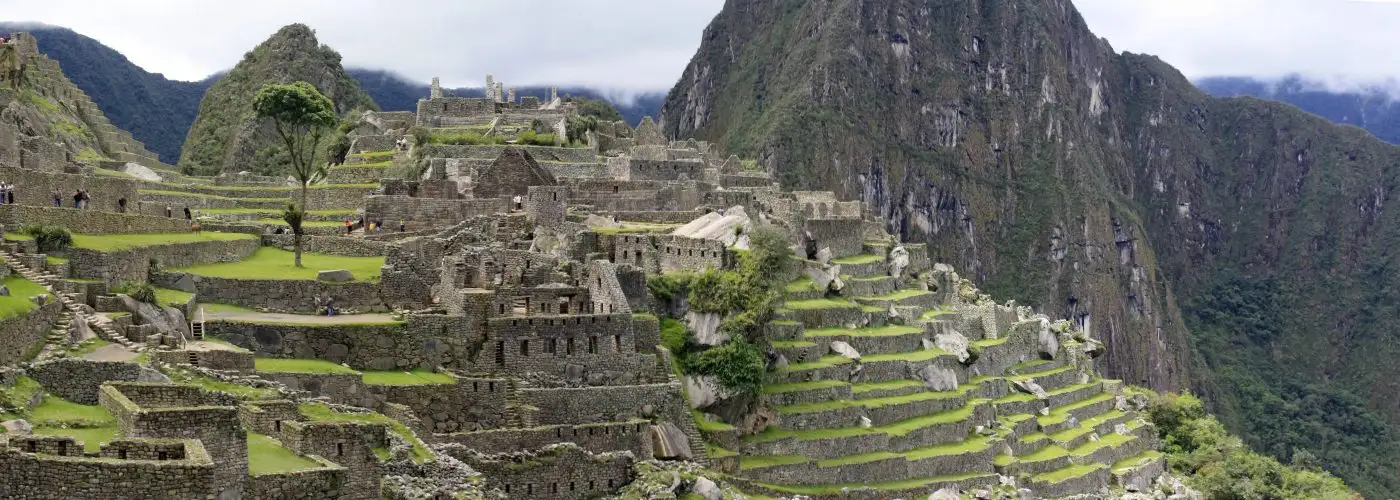
Machu Picchu Travel: Everything You Need to Know
Sarah Schlichter
Deputy Executive Editor Sarah Schlichter's idea of a perfect trip includes spotting exotic animals, hiking through pristine landscapes, exploring new neighborhoods on foot, and soaking up as much art as she can. She often attempts to recreate recipes from her international travels after she gets home (which has twice resulted in accidental kitchen fires—no humans or animals were harmed).
Sarah joined the SmarterTravel team in 2017 after more than a decade at the helm of IndependentTraveler.com. Sarah's practical travel advice has been featured in dozens of news outlets including the New York Times, the Chicago Tribune, USA Today, Budget Travel, and Peter Greenberg Worldwide Radio. Follow her on Twitter @TravelEditor .
The Handy Item I Always Pack: "A journal. Even years later, reading my notes from a trip can bring back incredibly vivid memories."
Ultimate Bucket List Experience: "Road tripping and hiking through the rugged mountains of Patagonia."
Travel Motto: "'To awaken quite alone in a strange town is one of the pleasantest sensations in the world.'—Freya Stark"
Aisle, Window, or Middle Seat: "Aisle. I get restless on long flights and like to be able to move around without disturbing anyone else."
Email Sarah at [email protected] .
Travel Smarter! Sign up for our free newsletter.
Hidden away for centuries in the mountainous cloud forests of Peru, the well-preserved Incan ruins of Machu Picchu are a must for any traveler’s bucket list. Though the UNESCO World Heritage site’s origins remain mysterious—was it a royal retreat? A religious site? The famed lost city of the Incas?—Machu Picchu travel has become a booming business, with upwards of 1.1 million visitors flocking to it each year.
[viator_tour destination=”937″ tours=”32188P3,18940P3,19945P3″]
Machu Picchu Travel Tips
To make the most of your trip, you’ll want to know the best time to visit Machu Picchu in order to avoid crowds, plus the best way to get there, and which type of ticket you should buy. For help planning a trip to Machu Picchu, use these comprehensive tips.
The Best Time to Visit Machu Picchu
The busiest time of year to visit Machu Picchu is between July and October, when the weather is typically dry and pleasant. If you’re planning your Machu Picchu travel for this time period, prepare for crowds and make sure to book tickets and tours well in advance.
The rainy season runs from November through March or early April, with downpours (and muddy trails) at their peak between January and March. The Inca Trail is closed each February for maintenance.
If you’re looking to avoid the worst of the crowds without risking too much rain, visit Machu Picchu during the months of April, May, and June.
The Inca Trail and Alternative Machu Picchu Treks
The most popular way for adventurous travelers to reach Machu Picchu is the famous Inca Trail, which takes you on a four-day trek through the mountains and directly to the ruins. For those who don’t have the time and/or fitness to conquer the full trail, there’s a two-day version of the Inca Trail that’s shorter and easier. Note that access to the trail is restricted to just 500 people per day (including support staff—you can’t hike the Inca Trail without a guide), and permits sell out months in advance.
Fortunately, there are less crowded alternative hikes to choose from. Consider the strenuous five-day Salkantay trek for incredible high-altitude scenery, or the four-day Lares trek for stops in local Andean communities. If you’re really up for a challenge, consider the Choquequirao trek , which takes you to hidden Incan ruins that most visitors to Peru never get to see.
Companies such as SAS Travel and Llama Path offer organized trips for these and other Machu Picchu treks.
Machu Picchu Package Tours
It’s nearly impossible to book a group tour of Peru that doesn’t include a stop at Machu Picchu. G Adventures , Intrepid Travel , and National Geographic Expeditions are among the many companies that offer package tours of Peru.
You can also book a shorter tour of Machu Picchu as part of an independent vacation. Just about every travel agent in Cusco can book a day or overnight trip from there to Machu Picchu, or you can reserve one in advance on SmarterTravel’s sister site, Viator . If you have the time, we’d recommend an overnight stay in the Machu Picchu area; driving to and from Cusco makes for a long, grueling day trip, starting as early as 4:00 a.m.
Planning an Independent Visit to Machu Picchu
Not a fan of traveling with groups? It’s easy enough to arrange your own visit to Machu Picchu. Most travelers arrive at Machu Picchu Pueblo (also known as Aguas Calientes) via a train from Cusco, Urubamba, or Ollantaytambo. Peru Rail and Inca Rail are the two main providers; you can buy tickets on their websites or at their ticket offices around Peru.
To get to the ruins, most visitors take a 20-minute bus ride up a winding mountain road. You can buy tickets to do so from the booths next to the bus station in downtown Machu Picchu Pueblo. Alternatively, you can walk from the pueblo to the ruins, which takes about 90 minutes and is mostly uphill.
You must buy your ticket to Machu Picchu in advance, through either the official government website or a travel agency: You can’t buy Machu Picchu tickets on arrival. Note that the government website only accepts bookings with a Visa credit card ( not Mastercard or American Express), and can be a bit confusing to use, especially if you don’t speak Spanish. You can use a Google Chrome browser to translate the site into English.
Machu Picchu recently made changes to its ticketing policy in an effort to manage the flow of crowds. Now you buy your ticket based on hourly entrance times, and although you can enter after the time stamped on your ticket, you won’t be able to get in before, though your ticket might have a more specific time table that you would need to adhere to. You’ll take a guided tour, which takes two to three hours, and if you exit, you won’t be able to get back in.
If you don’t use your ticket on the specified date and time, you won’t get a refund, and you won’t be able to use your ticket to enter Machu Picchu at any other day or time. The most popular entry time into the archaeological wonder is as early in the morning as possible: 6:00 a.m. If you want this time slot (or any other), book it on Machu Picchu’s official website (run by Peru’s Ministry of Culture) as soon as possible, as there are only 5,600 tickets sold each day. The site closes, and all visitors must be out, by 5:30 p.m.
Huayna Picchu and Machu Picchu Mountain
There are two optional hiking areas within the Machu Picchu ruins that require special tickets to access.
Huayna Picchu is the more popular of the two, involving a climb up the famous peak that appears in the background of most classic Machu Picchu photographs. At the trail checkpoint, you’ll see signs for both Huchuy Picchu and Wayna Picchu. Don’t be confused: Wayna is an alternate spelling of Huayna. Huchuy Picchu is the small mountain in front of Huayna Picchu.
The trip to the top of Huchuy Picchu and back takes only about 45 minutes. For more spectacular views, hike to the top of Wayna Picchu, which takes about two hours roundtrip. From this path you can also take a detour to see the Temple of the Moon, part of the Gran Caverna , or Great Cave, complex. This adds another hour or two to your total trekking time.
Hiking Machu Picchu Mountain is also an option, and is more rigorous and less crowded than the Huayna Picchu trail. Located on the opposite side of the ruins, Machu Picchu Mountain is higher than Huayna Picchu (it tops out at more than 10,000 feet, compared to Huayna Picchu’s 8,900 feet), so some travelers may be affected by the altitude. This hike takes an hour longer than Huayna Picchu, but the views are similarly spectacular.
Both the Huayna Picchu and Machu Picchu Mountain hikes are restricted to 200 visitors for each entry period: between 7:00 and 8:00 a.m., or between 10:00 and 11:00 a.m.
Machu Picchu Hotels
If you want to sleep right next to the ruins and be the first in line when they open at sunrise, you have one very expensive option: The luxe Belmond Sanctuary Lodge is located steps from the main entrance.
Most visitors stay in nearby Machu Picchu Pueblo, a small but bustling town with lodging options for every price point. One of the most indulgent is the Inkaterra Machu Picchu Pueblo , which is within walking distance of restaurants and the train station but feels like a remote resort, complete with bubbling fountains and lush landscaping. Guests stay in private casitas with colonial-style furniture, and many feature fireplaces or private plunge pools.
More moderately priced options in Machu Picchu Pueblo include the Casa Andina Standard and the Tierra Viva Machu Picchu , both of which offer comfortable rooms with river views.
Need-to-Know Machu Picchu Travel Tips
First and foremost, wear comfortable shoes : Machu Picchu is a large site with lots of hills and stairs, and there are few places to sit and rest. Walking sticks are prohibited except for “elderly and incapacitated” visitors, according to the official ticket. If you do need to use a stick or cane, make sure it has a rubber tip to protect the ruins. Visitors with wheelchairs can access the site with an operator called Wheel the World .
The weather can change quickly in the mountains, so you’ll want to pack sunscreen, a wide-brimmed hat, and rain gear . Throw in some insect repellent to fend off pesky mosquitoes.
The only toilets on site are right outside the entry gates. Bring change; there’s a small fee to use them.
Food options near the main gates are limited to a pricey buffet at the Belmond Sanctuary Lodge and a mediocre snack bar. Note that eating is technically forbidden within the ruins, though we spotted fellow hikers refueling with granola bars at the top of Wayna Picchu—just be sure to take any trash out with you.
To learn more about the history of Machu Picchu, stop at the Museo de Sitio Manuel Chavez Ballon , a small museum with information about the ruins. It’s located about a 30-minute walk from Machu Picchu Pueblo.
More from SmarterTravel:
- Machu Picchu: How to Plan a Perfect Trip to the Lost City of the Incas
- Machu Picchu Is Overrated, Go to Choquequirao Instead
- Sacred Valley, Peru: How to Plan the Perfect Trip
[viator_tour destination=”927″ type=”3-mod” tours=”14086P20,5243P120,65921P14″]
Sarah Schlichter recently spent the night in Machu Picchu Pueblo courtesy of Inkaterra Machu Picchu Pueblo. Follow her on Twitter @TravelEditor for more travel tips and inspiration.
Editor’s note: This story was originally published in 2018. It has been updated to reflect the most current information.
We hand-pick everything we recommend and select items through testing and reviews. Some products are sent to us free of charge with no incentive to offer a favorable review. We offer our unbiased opinions and do not accept compensation to review products. All items are in stock and prices are accurate at the time of publication. If you buy something through our links, we may earn a commission.

Top Fares From

Don't see a fare you like? View all flight deals from your city.
Today's top travel deals.
Brought to you by ShermansTravel
Greece: 8-Nt, Small-Group Tour, Incl. Aegina,...

Amsterdam to Copenhagen: Luxe, 18-Night Northern...
Regent Seven Seas Cruises

Ohio: Daily Car Rentals from Cincinnati

Trending on SmarterTravel
- 1 (800) 980-0435 or your travel advisor
All the best tours & things to do
Machu picchu travel guide.
World Travel Awards Winner
Endorsed by ASTA
In Alliance with Regenera
Rated Excellent by Tripadvisor
About Machu Picchu
Machu Picchu is one of the Seven Wonders of the World and is a synonym of historical richness, ancient culture, and dazzling architecture. But, What does Machu Picchu mean? The name comes from the ancient Quechua language and means “Old Peak”. This Incan citadel is surrounded by terraces, temples, water channels, and unbeatable magic . It has been considered a cultural heritage of humanity by UNESCO in recognition of its religious and political importance during the age of its inhabitants, the Incas.
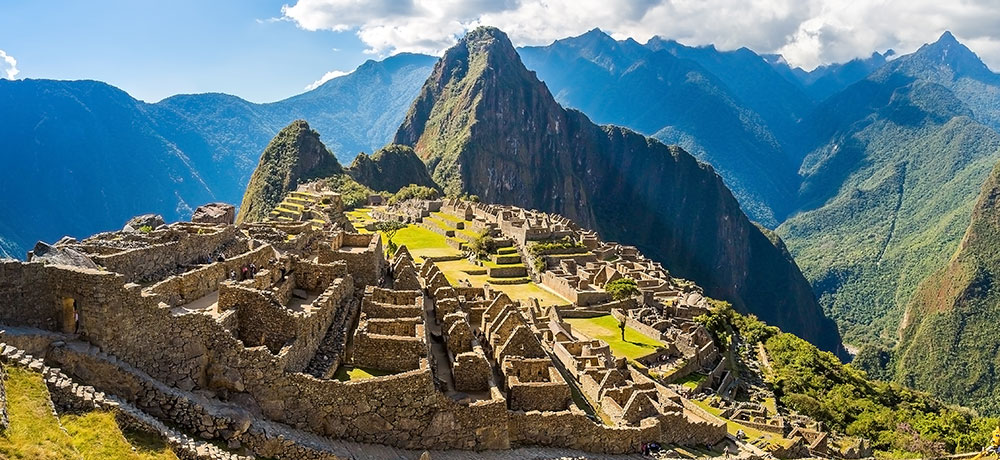
Certainly, there are a lot of things to do in Peru . So, Machu Travel Peru makes tailor-made tours to Machu Picchu which are designed according to your needs and desires. You will be dazzled by one of the most impressive architectural jewels of the world and marvel at its ancient history . It will be a special experience that will connect you with the ancestral Inca lifestyle. Also, every detail of your vacation in Peru will be perfectly organized by our expert team!
- Huayna Picchu is the famous mountain that appears in the background of every photo of Machu Picchu and you can climb up it.
- Machu Picchu Mountain is the namesake hill located on one side of the Inca citadel. Visit it with the family is a charming experience.
- Huchuy Picchu is another mountain, close to the citadel , where you can hike it without much effort and get views with another perspective of Machu Picchu.
- The Three Windows is a temple located in the superior area of Machu Picchu and is the best example of its beautiful architecture.
- Aguas Calientes town is the closest modern town to Machu Picchu. There, you will find excellent restaurants, hotels, and handicraft markets.
- The butterfly farm and the Inkaterra Foundation's spectacled bears conservation center in Aguas Calientes will put you in contact with nature.
Best Machu Picchu tours for 2024 & 2025
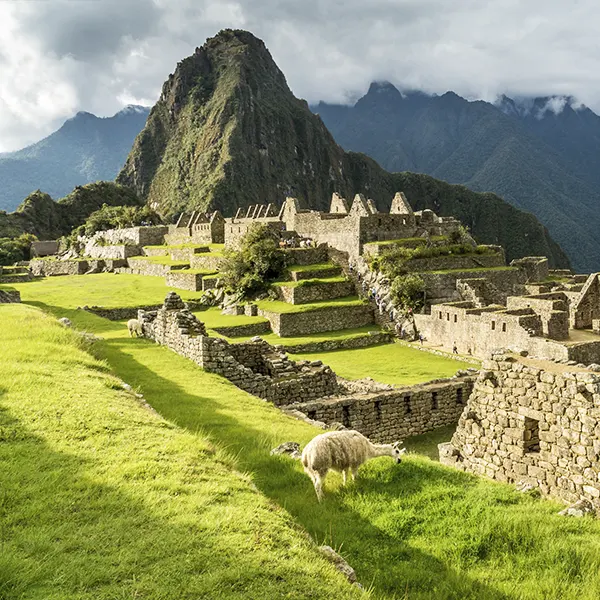
6 Days / 5 Nights
A memorable journey to Lima and Machu Picchu
Lima, Cusco, Sacred Valley, Machu Picchu

7 days / 6 nights
A Culinary Adventure in Peru
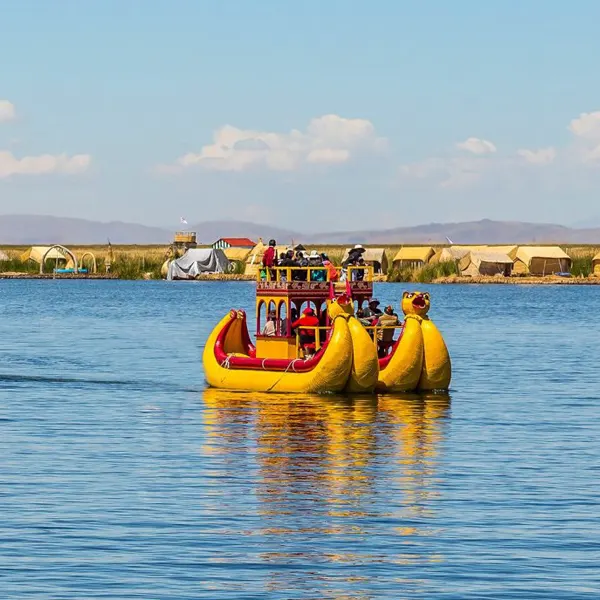
8 Days / 7 Nights
Discover Authentic Traditions At The Sacred Titicaca Lake
Lima, Cusco, Sacred Valley, Machu Picchu, Puno, Lake Titicaca
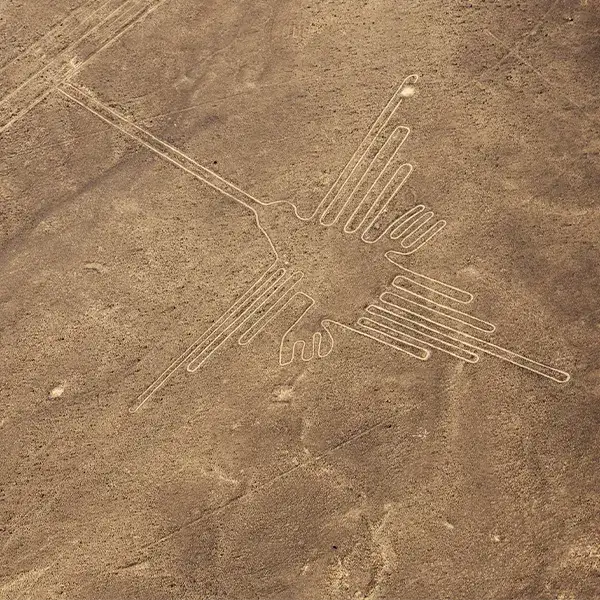
Overfly the mysterious Nazca Lines heading to Cusco
Lima, Ica, Paracas, Nazca, Cusco, Sacred Valley, Machu Picchu
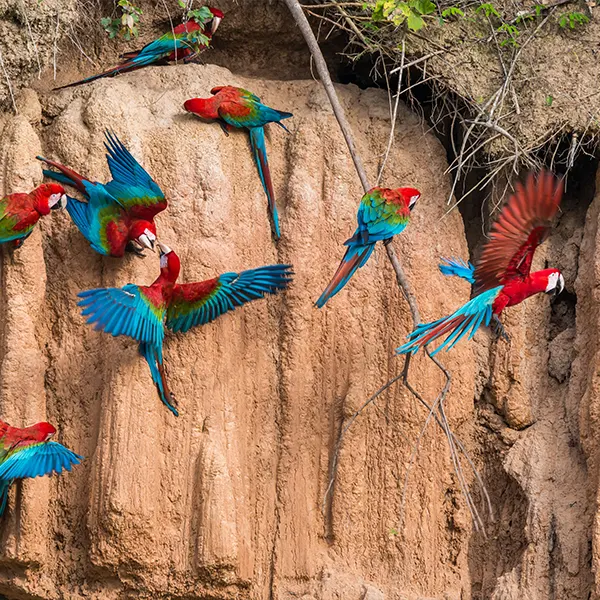
9 Days / 8 Nights
Explore the Paradise of Peru Jungle and Machu Picchu
Lima, Cusco, Sacred Valley, Machu Picchu, Puerto Maldonado, Tambopata
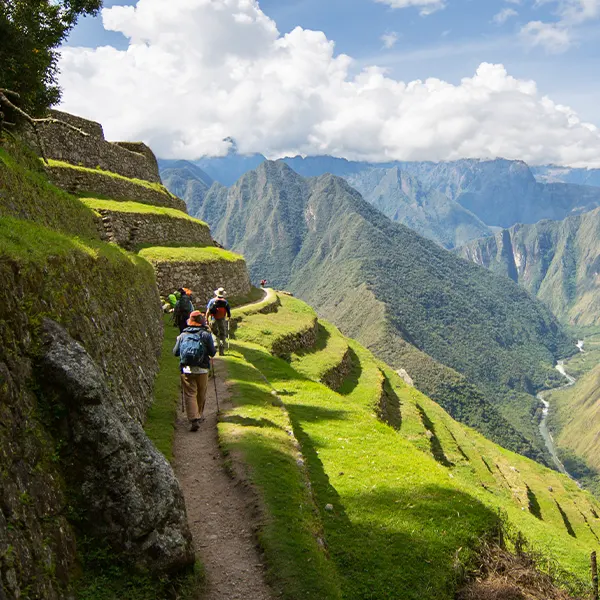
Wonders of the Inca Trail to Machu Picchu
Lima, Cusco, Sacred Valley, Inca Trail, Machu Picchu
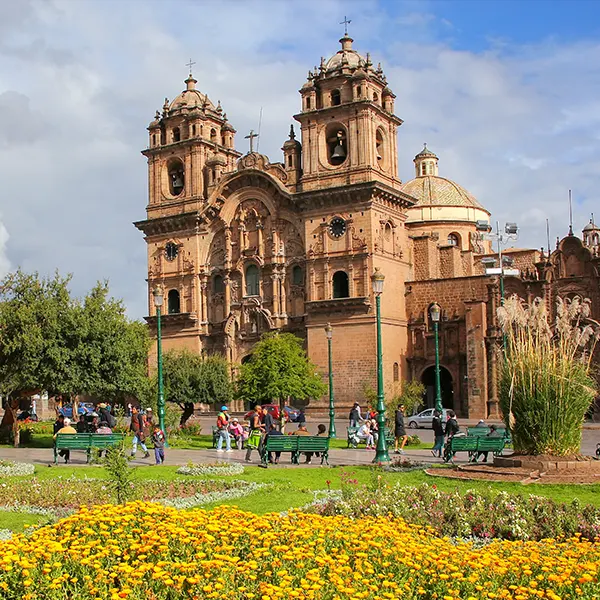
11 days / 10 nights
Exploring Southern Peru
Lima, Puerto Maldonado, Cusco, Sacred Valley, Machu Picchu, Puno, Lake Titicaca
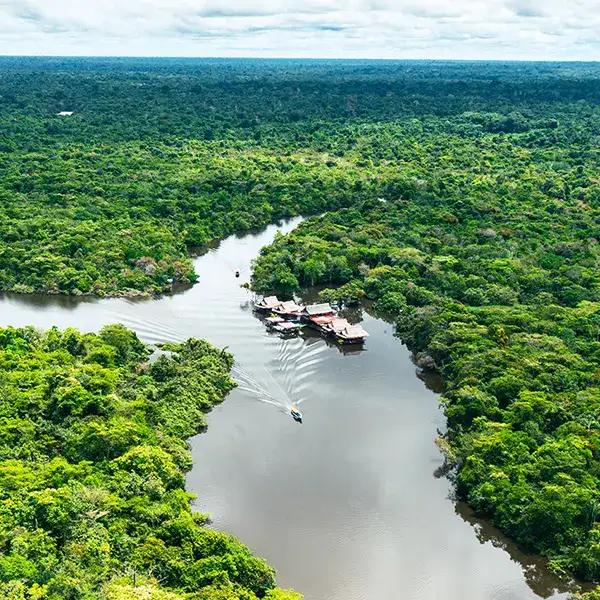
Explore Machu Picchu and Sail The Amazon River
Lima, Cusco, Sacred Valley, Machu Picchu, Iquitos
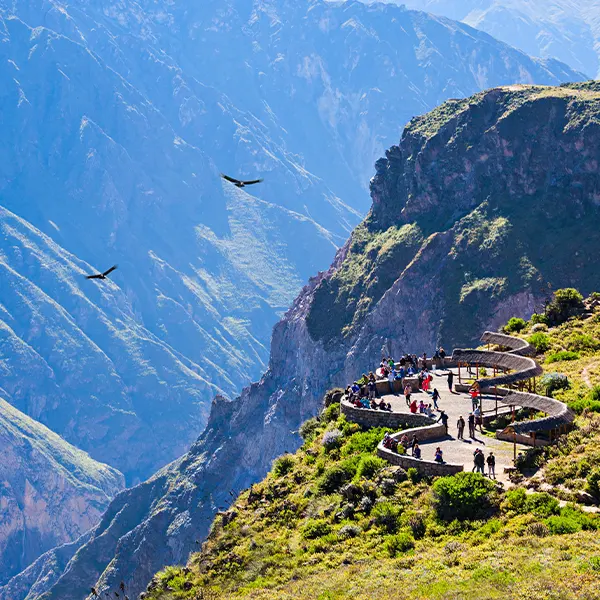
11 Days / 10 Nights
Secrets of Colca Canyon, Lake Titicaca and Machu Picchu
Lima, Arequipa, Colca Canyon, Puno, Lake Titicaca, Cusco, Sacred Valley, Machu Picchu
Machu Picchu History
The discovery of machu picchu.
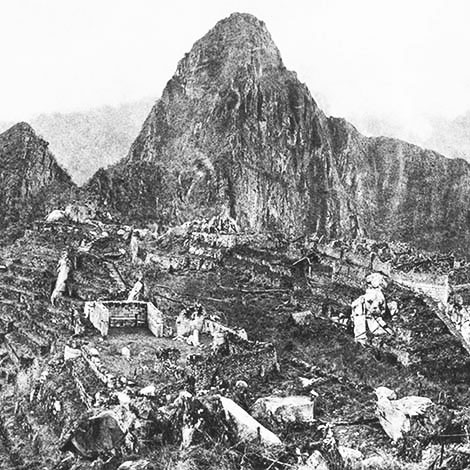
Never discovered by the Spanish conquerors, for many centuries the “Lost City of the Incas” lay forgotten, except by local Indians and settlers, until it was found on July 24, 1911 , by the US explorer Hiram Bingham . It was a fantastic find, not least because the site was still relatively intact, without the usual ravages of either Spanish conquistadores or tomb robbers. Accompanied only by two locals, Bingham left his base camp around 10 am and crossed a bridge so dodgy that he crawled over it on his hands and knees before climbing a precipitous slope until they reached the ridge at around midday. After resting at a small hut, he received hospitality from a local peasant who described an extensive system of terraces where they had found good fertile soil for their crops. Bingham was led to the site by an 11-year-old local boy, Pablito Alvarez , but it didn't take him long to see that he had come across some important ancient Inca terraces over a hundred of which had recently been cleared of forest for subsistence crops. After a little more exploration Bingham found the fine white stonework and began to realize that this might be the place he was looking for.
Origins of Machu Picchu
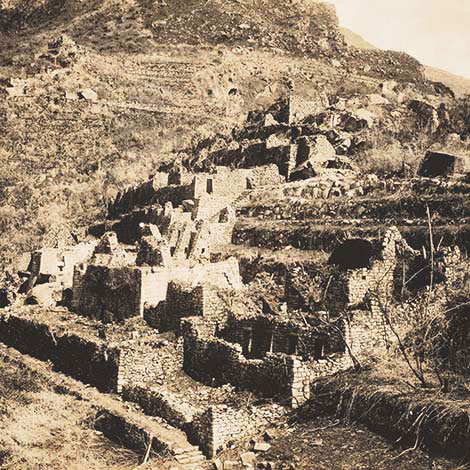
Bingham first theorized that Machu Picchu was the lost city of Vilcabamba , the last refuge of the Incas from the Spanish conquistadors. Not until another American expedition surveyed the ruins in the 1940s did serious doubts begin to arise over this assertion, and more recently the site of the Incas' final stronghold has been shown to be Espiritu Pampa in the Amazon jungle .
Meanwhile, it was speculated that “Lost City of the Incas” was perhaps the best preserved of a series of agricultural centers that served Cusco in its prime. The city was conceived and built in the mid-fifteenth century by Emperor Pachacuti , the first to expand the empire beyond the Sacred Valley towards the forested gold-lands. With crop fertility, mountains, and nature as sacred to the Incas, an agricultural center as important as the Inca citadel would easily have merited the site with fine stonework and temple precincts. It was clearly also a ritual center, given the layout and quantity of temples; but for the Incas, it was usual to not separate things we consider economic tasks from more conventional religious activities. So, Machu Picchu represents to many archeologists the most classical and best-preserved remains in existence of a citadel used by the Incas as both a religious temple site and an agricultural (perhaps experimental) center.
Machu Picchu Geography
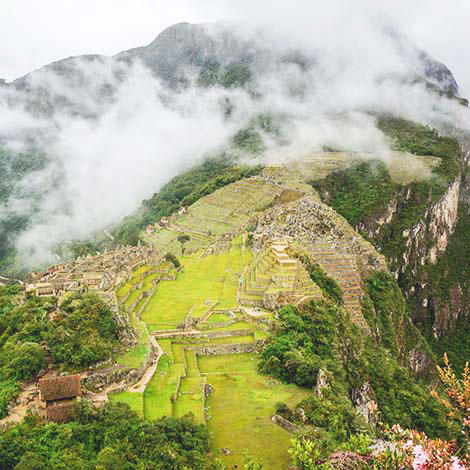
Machu Picchu is located in the Andes Mountain range at 7,970 ft (2430 m) above sea level. While the Inca citadel is located about 450 meters above the Sacred Valley. Not only is Inca citadel available for hikes, but also try Huayna Picchu (8,920 ft / 2,720 m) and Machu Picchu Mountain (10,100 ft / 3,080 m) .
Located on the cusp of the Andes Mountains and upper Amazon basin, the mild subtropical climate of Machu Picchu is more humid than Cusco and the Sacred Valley . The temperature of the Inca citadel is warm and humid during the day , while at night it is much cooler. The temperature can range between 12 and 24 degrees Celsius . And no matter what time you travel, rain can appear without warning and water never freezes. See Seasonal Info for more details.
Machu Picchu & Altitude Sickness
Altitude sickness is a common health problem for people who visit the Inca citadel. Everyone reacts differently, but severe reactions to high elevations are rare and hard to predict. Many travelers only experience minor symptoms, such as shortness of breath, headache, loss of appetite, or nausea, as a result of the altitude. Cusco and the Sacred Valley are at higher elevations than Machu Picchu.
Machu Picchu Seasonal Info
What weather to expect at machu picchu.
The Machu Picchu weather can change abruptly. In the morning the temperature can be cool and also at night , so bring a good jacket. During the middle of the day, it can be warm so dress in layers.
Average Daily Temperatures
- Day: 65-82 F (18-28 C)
- Night: 50-65 F (9-17 C)
- The Dry Season: April to October
- The Rainy Season: November to March
NB: In the highlands of Peru, there is a rainy season and dry season . But you should expect rain at any time of the year, so always come prepared.
How to get to Machu Picchu
Are you asking about how to get to Machu Picchu ? The spectacular Andean mountain scenery is undoubtedly picturesque and extremely varied. It encompasses glaciers, lakes, and forests. There are off-the-beaten-path routes to reach the Inca citadel that are considered more than exceptional and unique ones. They won't cease to surprise you. Keep in mind that for whatever way you choose to go to the citadel you will need to reserve your entrance tickets.
Classic ways
Arrive in style on a wonderful train journey. You can choose from train to Machu Picchu budget options to more luxurious and exclusive ones. The easiest and most frequent way to get is to take the train from Cusco (Poroy train station) to Aguas Calientes or Ollantaytambo to Aguas Calientes. There are two main companies that count on the highest standards of comfort, convenience, and safety. If you are traveling independently, it is advisable to book train tickets to Machu Picchu in advance. The total travel time can be between three and a half hours to four hours of travel.
When arriving at Aguas Calientes, shuttle buses are available to ascend the mountain and transport you to the Inca citadel. They operate throughout the day and leave every 15 minutes from Aguas Calientes to Machu Picchu and vice versa. The trip is quite short and it can last between 35 to 40 minutes depending on the pace. The bus station is just 5 minutes from the train station.
If we pay attention to an Inca Trail map , we can realize that this one is a specific section of the hundreds of routes built by the Inca Empire. One of the most rewarding and challenging ways to get to "Lost City of the Incas" is by following one of the paths of the Inca Trail. It's a spectacular network of tracks that wind across snow-capped Andean mountains, rivers, and breathtaking landscapes. Thanks to its natural and cultural treasures, it has become an attraction that draws thousands of enthusiastic travelers every year. Along your way, you can visit the Inca ruins and much more. Numerous tour operators offer the possibility of walking the Inca Trail to Machu Picchu . Please note that depending on your operator, you will have alternatives of different durations. The classic Inca Trail tour lasts 4 days and 3 nights . Although there are other variants of fewer days.
Choquequirao Trek
Those travelers who are interested in archeology should consider the Choquequirao trek. This trek is a four-day to nine-day hike through a wide variety of flora and fauna, spectacular and stunning Andean scenery, and an ancient trail leading to the well-preserved Inca ruins of Choquequirao . This challenging hike is definitely a once-in-a-lifetime adventure.
Salkantay Trek
If you are looking to enjoy a less crowded and more private experience, the Salkantay Trek is one of the best options. This is usually the second most popular way to hike to Machu Picchu . The Salkantay trek owes its name to one of the highest Andean peaks in Peru: The Salkantay Mountain . The Salkantay is one of the most imposing peaks in the Peruvian Andes and has a height of 6,271 meters above sea level. This incredible five-day trek is one of the best trekking alternatives to Inca citadel, but more difficult. You will pass through imposing Andean peaks, cloud forests, and dazzling jungle. Without a doubt, it's a must!
Machu Picchu FAQs
What is machu picchu.
If we want to answer correctly the question of what is Machu Picchu? Is an ancient Inca citadel located at 2,430m. above the sea level, in South America in the Peruvian Andes, and was built in the 15th century, used as a residential neighborhood, and ceremonial center, and was abandoned only one hundred years later. In 1986, Machu Picchu was declared a World Heritage site by UNESCO . Besides, in 2007, it was chosen as one of the Seven Wonders of the World since it's one of the most famous and spectacular sets of ruins in the whole world.
Where is Machu Picchu?
"Lost City of the Incas" sits above the Sacred Valley of the Incas , in the Cusco department. At 2,430 m., the Inca citadel is overlooking the Urubamba River and is surrounded by majestic forest-covered mountains. The access point is the town of Aguas Calientes.
How can I get to Machu Picchu?
Most travelers fly into the city of Cusco and from there there are a couple of ways to get to the Inca citadel such as taking the train or hiking, or taking a bus. If you decide to hike, here are several interesting trails you can take but the most popular and famous one is the Inca Trail. There are many alternative routes to Machu Picchu , you can choose the most suitable for you.
In order to take the train, you must go to the Ollantaytambo Train Station which is around 1.5 hrs. away from Cusco by bus. From there, you have to take a train trip to Aguas Calientes that takes around 2 hrs. Once you arrived at Aguas Calientes, you have two options: take a bus or walk up to the entrance to "Lost City of the Incas".
Regarding buses, you must take a bus from Cusco to the Hydroelectric train Station, the trip pass by two quaint towns like Santa Maria, and Santa Teresa , and takes around 4 hours. Once at the Hydroelectric station, you have two alternatives: take a train led to Aguas Calientes, the trip lasts 01 hours. Or, walk to Aguas Calientes for around 03 hours, following the railways.
When is the best time to visit Machu Picchu?
The truth is that the Inca citadel is available throughout the year. The best time to visit Machu Picchu will depend a lot on how you want to enjoy your adventure. In general, you can choose to travel in the high season or the low season. Each of these has its own advantages and disadvantages. Although the truth is that an experience like the Inca citadel can be appreciated at any time of the year.
- Travel during shoulder months (April, May, September, and October) for smaller crowds and generally good weather. Of course, if you want our opinion, the best month to hike Machu Picchu is September.
- The dry season : The most popular time to visit the Inca citadel is during the dry season (April to October) when cooler air, bright blue skies, clear days, and sunny blue skies are more common. But the nights are cold on hiking trails (The Inca Trail is closed in February for maintenance). June , July , and August tend to be the busiest months.
- The rainy season : Traveling to the Inca citadel during the rainy season (November-March) has benefits too. Of course, the temperatures are warmer, there are fewer people and the Inca citadel is intensely greener due to the heavy rains. Keep in mind that during the rainy season, the cost of a trip can be much lower. But, What is the benefit? Well, the ruins aren’t as crowded and flowers are in bloom. Consequently, better photos and postcards.
Can you get to Machu Picchu in a day?
Absolutely yes.There are many day trips designed to explore Machu Picchu, if you are in Cusco, you can start your journey very early in the morning, take a 1.5-hour bus ride to Ollantaytambo, and then a 2.5-hour train ride to Aguas Calientes. Once you arrive there, you can take a 45-min bus ride to the Inca citadel. You will have a couple of hours to explore the dazzling "Lost City of the Incas" and then, return to Cusco the same day in the same form. Bus to go down to Aguas Calientes, after a train to Ollantaytambo, and from it, a bus to Cusco.
Keep in mind that you must book your Machu Picchu tickets in advance.
Of course, visiting the Inca citadel citadel for just a couple of hours is not ideal. Also, this kind of full-day trip doesn't offer much time to visit and enjoy the citadel , and the Sacred Valley of the Incas.
How high is Machu Picchu?
Machu Picchu is at a height of 2,430 m. above the sea level - sitting at 1000 m. lower than Cusco- which is below the minimum height at which altitude sickness can hit you badly. It mostly affects people from low-altitude locations. This is an example of how wrong we can be about how high is Machu Picchu is and that it is also lower than Cusco situated over 3500 m.a.s.l. Be aware that a visit to the Inca citadel involves walking up and down many steep stairs, terraces, and ramps at different altitudes.
Altitude sickness in Machu Picchu, What to do?
Technically, yes. Altitude sickness can affect anybody who goes from low altitudes to high altitudes without giving the body time to adjust to the changes in oxygen level and air pressure.
Regardless of gender, age, or fitness level, most travelers can feel the effects of high altitude at over 2,000 m. The symptoms include dizziness, headaches, tiredness, and vomiting. Thus, Machu Travel Peru recommends taking your time to explore the Inca citadel, drinking plenty of water o coca leaf tea for altitude sickness . Even spending a couple of days in the city of Cusco to let your body acclimatize to the high Andean altitude.
What should I pack for Machu Picchu?
Your backpack will depend on the weather and the season, the Inca citadel is located in a tropical cloud forest on the Cusco jungle eyebrow. Therefore, the weather there can be warm and humid, totally different in front of Cusco (the city where depart the majority of transportation to the "Lost City of the Incas") which presents cold and dry weather due to the altitude. Therefore, preparing a backpack can be varied. Here, you have some tips to pack the more essential things for your Machu Picchu trip.
Backpack : A backpack of 25 liters will be enough for a full day trips, even for a trip of 2D/1N. Remember that you must take it during your tour for two hours or more (up to three) through the citadel of the Inca citadel. That's why the lighter the backpack, the better. Of course, if you plan to do the Inca Trail or spend more days in Aguas Calientes, you can carry a duffle bag or a carry-on of a maximum of 10 kg (22 lb) with dimensions of 62 inches or 158 cm (height + length + width) onboard train. This suitcase must remain in the hotel storage while you carry a small backpack during your tour. You cannot take your complete hand luggage to Machu Picchu.
Clothes: As usual, the clothes to wear in tropical and warm weather will be light. However, the moments when you leave Cusco heading to the Inca citadel (Usually early mornings) and during the returns (late at night), you can feel extreme cold. Therefore, packing the necessary things will be crucial.
- Warm jacket for the early mornings and night arrivals back to Cusco
- Rain jacket or (Poncho) for untimely rains
- Comfortable shoes for trekking (Remember, you will walk over stones)
- Sneakers or light shoes to stay in Aguas Calientes
- Support t-shirts and underwear
- Large light pants for trekking
- Long and light sleeve shirts for trekking
- Sunglasses, a hat, or a cup. To protect yourself from the strong sun of the zone
Food : Eat or consume any type of food or snack inside the Inca citadel is forbidden. But, you can carry them in your backpack and eat them before or after the tour (outside of the inca complex).
- You can carry chocolates, power bars or any fruits.
- You can carry water in your own bottle. Disposable plastic bottles are prohibited.
Some advice : There are some archaeological park regulations that any visitor has to comply with during the visits. The most important are:
- During your Inca citadel trip, you`ll find llamas. Please, don't feed them.
- Avoid using walking sticks. However, if you will use them, these have to be covered by a rubber tip.
- Do not go near the edges or go over the ropes.
- Don't take umbrellas. These are forbidden. You can bring a rain jacket instead.
Basics : The following list is the most essential things that you have to bring with you on your tour.
- Original passport. It will be required at the entrance of Inca citadel, on the trains and CONSETTUR buses.
- Cash in your pocket. Peruvian Soles S/. 300 approx. To eat, go to the bathrooms or buy some souvenirs.
- Repellent for mosquitoes. The archaeological complex is located in a tropical rainforest jungle and bugs usually are frequent in the mornings..
- Printed entrances to the archaeological complex, train tickets, and bus CONSETTUR tickets. To speed up the entry process to these services.
- Cell Phone rain cover
What is Huayna Picchu?
Huayna Picchu or Wayna Picchu, also known as the "stairs of death", is the large mountain that sits directly behind Machu Picchu.
For many travelers, Huayna Picchu mountain is one of the most dazzling places in the Inca sanctuary. The views from the top of this mountain are, without a doubt, mind-blowing. It's well worth the climbing effort. However, it's not recommended for people who suffer vertigo or cannot overcome their fear of heights.
What are the toilet facilities like at Machu Picchu?
Imagine waking up one morning in an exclusive hotel in Aguas Calientes, taking a light but protein breakfast, and beginning your tour. While you are transported from the town to the Incas citadel in a bus (45 min), and you are guided through all the attractive (03 hours), the digestion is in full process and sometimes your body may require you to go to the bathroom. Having considered that there are no bathrooms inside the Inca citadel, your only option is to go out from the citadel to use the bathrooms (located on the right side of the Archaeological park entrance) Once your needs are met, you decide to re-enter to Machu Picchu. But, What? you can't re-enter to Machu Picchu. Your entrance is valid only one time, and this is useless if you want to re-enter to archaeological complex .
In other words, answering the question, Can you pee in Machu Picchu? the answer is no. You will have to use the bathrooms of your hotel or pay for some (S/ 2 per cabin) located over the side of the Archaeological park entrance before entering the Inca citadel. A cautious man is worth two.
Can a disabled person visit Machu Picchu?
Machu Picchu, as a new world’s wonder and cultural heritage of Humanity by UNESCO, is an attraction suitable for everyone. Therefore, the administration of the Inca citadel has a special protocol to attend to those visitors with motor disabilities.
First , we recommend that these persons come to accompanied by a relative, friend, or someone who helps them to push the wheelchair or serves them as a support for walking.
Second , once the disabled person has purchased his tickets to visit Machu Picchu and is at the citadel entry control post, he must prove that they suffer from motor disabilities (a certificate, CONADIS card, medical certificate) to obtain assistance like an extra wheelchair (If that's the case), or a personal assistant to help to push the wheelchair (This will depend of availability of personnel and traffic of visitant in the day).
Third , the park rangers will be informed about the particular condition of a visitor and they will assist them at every point where they are guarding.
Fourth , the Inca citadel was built following the Incas architectonical style, with well-carved stones, narrow passages, sloping stairs, and walkways to the edge of the abyss. Therefore, the wheelchair will have limited access to some zones of the attraction. Ask the park rangers where is the most adequate route for visitors with motor disables, they will be glad to indicate to you the shortest and most accessible route for your tour. In this case, circuit 3 (Yellow).
Fifth . Of course, our recommendation, besides being accompanied by a relative or friend, is to hire the service of a tour guide : touring an archaeological park with so much history without an expert or someone who tells you about the most important facts of the marvel, would be boring. Or, if you prefer, you can take a Machu Picchu virtual tour , happily, nowadays technology is at the service of everyone, and there are interactive virtual maps of the citadel, in which you can enjoy every zone, see the beautiful landscapes, and knowing its history.
How is the tour to Machu Picchu?
The tours will depend greatly on the time spent there and the entrance shifts. In general, these are early morning tours, which means that it has to depart very early from Cusco (around 4 to 5 am) , taking a train to Aguas Calientes town (4 hours of trip) or taking a bus to Ollantaytambo train station (02 hours trip), and from there, take a train to Aguas Calientes (02 hours more).
Aguas Calientes is the support town of Machu Picchu . Once arrived there, you will have to take a bus to get to the citadel (45 min). The ticket will entitle you to enter at a certain hour to the attraction and spend there a certain time (03 hours as a máximum) . After that, you will have to take a bus to return to Aguas Calientes (45 min more).
In Aguas Calientes, you will have the time to take lunch, use the bathrooms, or go to the hot springs (The attraction that gives the town its name). At a certain hour, you will have to take a train to return to Ollantaytambo train station in the Sacred Valley , (if your hotel is located there) or directly to Cusco .
For those visitors who want to climb up to Waynapicchu (The mountain behind the citadel) or the Machu Picchu mountain (another mountain located in contraposition of Waynapicchu and receives the same name as the citadel), they will have to spend a night in Aguas Calientes , so that the next morning, very early, begin to climb up these mountains and get spectaculars views of the archaeological complex.
For those who want to spend 2 or 4 days on the Inca Trail and do the tour through Machu Picchu on the last day, they have the possibility of spending a night more in Aguas Calientes or taking a bus to return to Sacred Valley or Cusco . As we mentioned, all will depend on the time that you want to spend in the Inca citadel and the shift of visit.
How does entrance tickets to Machu Picchu work?
The entrances to Machu Picchu largely depend on the time of the visit and the place (circuit) of the visit. Therefore, the Machu Picchu park administration offers 4 different tickets to enjoy the many varieties of the archaeological complex. Also, the Machu Picchu tickets have different costs, divided by age. Adult, from 18 years old to more. Students, from 18 years old to 25 (Previously showing an original student card at moment to buy the ticket). Children, from 03 to 18 years old.
Llaqta of Machu Picchu (Circuit 1, 2, 3 or 4) : Llaqta is a Quechua word that means town or citadel. This is the most common ticket to visit the citadel, and It allows you to choose one of the 4 circuits to visit the Inca citadel . Each circuit can be toured in only one sense (from the beginning to the finish), without the possibility of going back or changing the circuit once begin the route. Also, the ticket comes with a certain hour (previously selected by the visitor, at the moment of the ticket purchase), which indicates the hour of the entrance to the citadel. For example, if your ticket indicates 08:00 am as your entrance hour, this means that you have a range of time from 08 to 09 am to the entrance. From your entry time, the maximum of 03 hours will be computed to remain in the citadel.
Circuit 4 + Waynapicchu Mountain : This means that you can climb up the Waynapicchu mountain (you`ll have a range of time of 3 hours for this) and after, the possibility of visiting the citadel by 2 hours more, following circuit 4 . In the same way, your ticket will indicate a certain hour, previously chosen by you, to enter the mountain Waynapicchu. If this indicates 10 am, you`ll have from 10 to 11 am to enter the mountain. Among Machu Picchu tickets , usually, this is the most demanded, for this reason, buying it, at least, 6 months in advance, will be the most recommendable.
Machu Picchu mountain + circuit 3 : This ticket allows you to climb up Machu Picchu Mountain (located at the south of the citadel, as opposed to Waynapicchu). Similar to its predecessors, this ticket indicates a certain hour to begin the climb to the mountain (this attraction receives the same name as the citadel), and after, visiting the citadel by circuit number 3 . The complete tour last 6 hours, at least, and many tours to Machu Picchu include it in their itineraries.
Circuit 4 + Huchuy Picchu mountain: This is the newest ticket option to visit Machu Picchu and climb the mountain Huchuy Picchu. This mountain is located at the north of the citadel and its visit last 01 hour at maximum. The ticket offers the possibility of climbing this mountain and visiting the citadel by circuit number 4 . A visitor can remain in the archaeological complex for around 04 hours with this ticket. In the same way, you have to choose an hour to the entrance to Huchuy Picchu at the moment of buying the ticket.
What are Machu Picchu hours of operation?
Usually, the archaeological complex is open from 06 am to 05:30 pm, all days of the week, even on holidays . Of course, this range of time is divided by the hours of entrance that each tickets types contain. This without considering the stay of up to 3 hours in the complex.
Llaqta of Machu Picchu (Circuit 1, 2, 3, or 4) :
Circuit 4 + Waynapicchu Mountain :
Machu Picchu mountain + circuit 3 :
Circuit 4 + Huchuy Picchu mountain:
How much does it cost to visit Machu Picchu?
The cost of a Machu Picchu trip includes different factors, besides the entrance ticket to the world wonder . The transportation cost from Cusco or Sacred Valley hotels to the train station, the train ticket to Aguas Calientes, the buses CONSETTUR (to get to the Inca citadel from the Aguas Calientes town), the service of a tour guide, it is due to a Peruvian government regulation in which indicate that any tourist can`t visit the citadel alone, they have to be accompanied by an authorized tour guide in all moment. And, naturally, the cost of entrance to the archaeological complex.
As you can see, the costs of tours to Machu Picchu have many variants. But, rest assure, we will treat each of them:
Car transportation : Whether you're staying in Cusco or the Sacred Valley of the Incas, this will be your first investment. Unfortunately, most of the train stations are located outside Cusco or in the north extreme of Sacred Valley, therefore, the visitor will need car transportation to get to these. If your train departs from San Pedro train station (the only one located in Cusco) you will need only a taxi (3$ one way) . But If your train departs from Poroy , located 14 km outside Cusco, you will need private transportation to get there from Cusco (10 $ one way) . Now, if your train departs from Ollantaytambo train station , located to 62 km from Cusco and 20km from Sacred Valley, you can pay 8 $ one way from Sacred Valley and 16 $ one way from Cusco .
Train Service : As you can see, the trains usually depart from Poroy or Ollantaytambo train station, only a pair of these depart from San Pedro train station, the only one located in the same Cusco city. Therefore, the cost of the train will depend of the distance to run from its starting point to the Aguas Calientes town round trip . The greater the distance, the higher the cost. Shorter distance, lower cost.
- Peru Rail offers train services from San Pedro, Poroy, and Ollantaytambo train stations (In order of distance from Aguas Calientes town). Besides distance, the costs of the trains depend on the level of service, being the EXPEDITION service, the cheapest, the VISTADOME service, the intermediate and the HIRAM BINGHAM the most expensive . The following costs are approximations and can vary in any moment.
- Inca Rail offers train services only from Ollantaytambo train Station. However, its cost depends on its three different levels of services. In order from cheapest to most expensive, there are the EXECUTIVE train, the 360º train, and the FIRST CLASS train . The following costs are approximations and can vary in any moment.
Bus CONSETTUR : Once arrived at Aguas Calientes town, you will need transportation to get to the top of the mountain where located the Machu Picchu citadel, 9 kilometers from the town. In this sense, the only company that offers the transfer service to the citadel is run by the Municipality of Aguas Calientes and is called CONSETTUR.
Guide in Machu Picchu : As we mentioned before, any visitors can visit the Incas citadel without an official tour guide. According to Peruvian government regulation, all visitors has to be accompanied by an authorized tour guide inside the archaeological complex. At the Archaeological checkpoint, the guard who verifies your entrance ticket will also inspect if you are accompanied by a tour guide. The offer is extensive, according to the demand, in this sense, a good tour guide, with years of experience, a good level of English language, and a university graduate in tourism, history, or archaeologic areas, can cost 70 to 80 $ per three hours of guiding in the citadel.
Entrance ticket to Machu Picchu : This section is the last link to answer the question How much does a trip to Machu Picchu cost ? As you can see, the cost of a Machu Picchu tour involves more than tickets for entrances or trains. In this sense, as we saw in a previous section, the entrance to the archaeological complex is divided into four types of entrances.
Therefore, depending on your schedule of train, the level of services, inter alia, we can get an average of 400 dollars per person .
What are the circuits to Visit Machu Picchu in?
In previous paragraphs, we indicated that the Ministry of Culture is the entity responsible for managing the Machu Picchu Archaeological Park. According to a recent investigation on the carrying capacity and erosion in the archaeological complex, the institution decided to delimit five circuits to visit Machu Picchu in order, to avoid crowds, slow down deterioration and conserve the attraction for the next generation. Also, once the visitor has started a route, there is no possibility of going back (To control this, park rangers are stationed at every corner of the citadel). In addition, the visitor cannot jump from one circuit to another, in the middle of the visit . If a route was chosen, it must be walked until the end.
Circuit 1 - Red - High-Short : This is a little route located in the upper sector of Machu Picchu . The circuit begins over the Andean terraces, continuing to the guardians` house, up to the principal entrance to the urban sector. Next, the circuit past the Temple of the Sun and the water mirrors, going down into the lower sector. Finally, the route leads to the exit. If you take this circuit, you’ll have the possibility to visit the Inca bridge and the Sun gate (Intipinku). The tour lasts 02 hours and 30 minutes.
Circuit 2 - Blue - High-Long : This circuit is the most demanded because is the only one that covers most of the Machu Picchu areas ; the upper and lower sectors, the same zones as Circuit 1, the intihuatana (Pyramid) area, Llamakancha, the Sacred Rock. After, the circuit goes down into the lower sector, passing by Condor temple up to the exit. The tour lasts 3 to 4 hours and it is perfect for those who want to explore the citadel in detail.
Circuit 3 - Yellow - Low-Short : This circuit is especially recommended by people with motor disables because the route is short and hosts few stairs and low slope areas. The access is through the storehouses (Qolqas), following the Inca house and the water fountains. Finishing in the Pisonae Square. Also, this circuit is combined with the visit to Machu Picchu mountain. The tour lasts 1 hour.
Circuit 4 - Sky Blue - Low-Long : The circuit was designed to be combined with the visit to Huaynapicchu mountain . The tour lasts approx 1 hour and 30 minutes and includes all the zone visited in circuit 3, plus the Llamakancha, the Sacred Rock, and the warehouses. The circuit continues to the lower sector, leading to the rear section of the citadel.
Circuit 5 - Green - Low-Middle : This is new rote thinking for those who arrive from Inca Trail . The circuits passed by the same zone as circuit 5, with the difference that this does not reach the extreme eastern sector, where the entrance to the road to the Huaynapicchu mountain is located. The tour lasts 01 hour and 15 minutes.
What rules to consider to visit Machu Picchu?
The Inca citadel like another world wonder with thousands of visitors per day has regulations and prohibitions that all visitors have to comply with. Happily, these are not many and are the most common that you can find in another attraction. Following, you have some rules to consider to visit Machu Picchu to comply with the rules of the site and avoid any inconvenience.
The following rules have to be considered by the present year.
- A tour guide is required, before, during, and after the Machu Picchu tour. To visit alone the citadel is forbidden.
- An only tour guide for up to 10 persons. That means a tour guide can guide a maximum group of 10 people. From the 11th person, a second tour guide is required.
- The maximum stay in the citadel is 04 hours. Enough time to walk any of the 5 designed circuits in the archaeological complex. A tour guide and this regulation of time help to free up space, avoid confusion, and protect the citadel.
- Re-enter the citadel is forbidden, except for those visitors who have a Machu Picchu with mountain ticket. Also, remember that there are no bathrooms inside the citadel. So, if you want to go to the bathroom, you will have to go out and use those that are located next to the entrance to the archaeological park, but, be careful, You will not be able to re-enter the citadel!
- Visitors have to respect the distance between them during the excursion in the archaeological complex. In this case, for individual persons, a minimum distance of 5 feet (1.5 meters) between visitors is suggested. In the case of groups, a minimum distance of 66 ft (20 meters) will be ideal.
Prohibitions
The things and items described in the following list are forbidden. The park rangers and the National Police guard the zone. And, If a visitor is caught with these items, he will be immediately expelled from the archaeological park without the right to a refund and will have to submit to the law.
- Purses, bags, or backpacks large than 40x35x20 cm.
- Kitchenware like thermos, pots, cutlery, and plates.
- Any kind of food.
- To be under illegal substance effects or carry any illegal substance.
- Carry any type of alcohol bottle or be under the effects of this substance.
- Selfie sticks, monopods, portable chairs, tripods, walking sticks, and umbrellas.
- Feed domestic or wild animals (Except guide dogs)
- Any type of Aerosol.
- Paint any type of graffiti that deface or alter any part of the citadel.
- Any type of musical instrument. For example, speakers or megaphones.
- Make disturbing or loud noise (Shout, scare, talk loud inter alia)
- Strollers for babies.
- Hard-sole or heels shoes.
- Use cell phones or virtual apps outside of designated areas or in narrow paths.
- Undress, jump, lie down, run or generate turmoil.
- Dressing clothes, showing posters, photos, films, and banners for promotional purposes.
- Any kind of weapons or knives.
- Perform fashion shows, bawdy dances, or any obscene acts contrary to good manners or morality.
- Move, touch, or extract any stonework or rock from the citadel structure (Walls, arcs, door frame inter alia)
- Lean or climb over walls and structures of the complex.
- Remove, collect, disturb or extract elements of the local flora or fauna.
- Flyover with drones, any craft, or paragliders.
- Get out of the established route or circuit to go to another.
- Carry out the trade or sell anything along all the Archeological park until Puente Ruinas (Ruins bridge)
- Start a fire, smoke, or vape any kind of fire.
- Throw garbage.
- Carry plastic bottles.
Do you need a tour guide for Machu Picchu?
Yes, you need one . As we mentioned in many sections, entering Machu Picchu citadel without the assistance of a tour guide is completely forbidden. According to the laws and norms of the Peruvian government, through the Culture Ministry, all visitors have to be accompanied by an authorized tour guide. This authorization comes from Cusco universities and institutes specialists in Tourist training. Therefore, the best will be to hire the service of a travel agency , these already include a tour guide service in their packages.
Which experiences are best for tours in Machu Picchu?
The location of archaeological complex is an advantage to develop different experiences. Let us remember that the archaeological complex is located in the jungle eyebrow of Peru, 75 kilometers northwest of Cusco. In this sense, activities like trekking, hiking, and even rappelling can be developed during the trip leading to the Inca citadel. The best itinerary to know Machu Picchu is not just one but many . Following, you will have the most representative tours:
- Full day trip by train, from Cusco to Machu Picchu.
- 2-Days-1-Night, Maras Salt Mines, Moray, and Machu Picchu tour.
- 16-Days from Lima including the Peruvian Amazon, Machu Picchu, and Lake Titicaca.
- First class Pullman train to Machu Picchu with lunch
- 2-hours Small group Machu Picchu tour.
- Day-trip tour by Vistadome train from Cusco.
- 5-Day trek trip Machu Picchu nature and village trek.
- Machu Picchu day trips from Cusco
- Alternative Machu Picchu day trip from Cusco
- Awesome Inca Jungle excursion from Cusco.
- 5-Days-4-Nights Salkantay trek to Machu Picchu.
- 5-Days Choquequirao trek to Machu Picchu.
- 4-Days-3-Nights Inca Trail Machu Picchu from Cusco
- Cusco and Machu Picchu tour.
- Alternative 2-Days-1-Night Inca Trail to Machu Picchu
Machu Picchu Attractions
The Inca citadel with its large ruins and perfect architecture is one of the world's most incredible archaeological sites. Its breathtaking location captivates many visitors who want to experience a once-in-a-lifetime adventure. You have a good selection of attractions to choose from during your Machu Picchu tour .
The Temple of The Sun
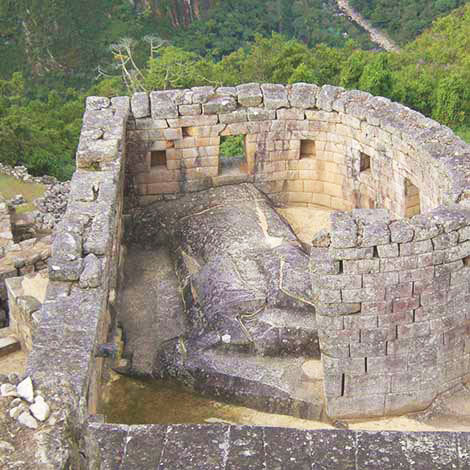
One of the best places to visit is located next to the main fountain. It is the only round building in the archaeological complex. This wonderful, semicircular, and tapering tower of fascinating stonework is best viewed from above. The Temple of the Sun is recognized for having some of the best stonework in the archaeological complex. It is believed that it functioned as a kind of astronomical observatory. The Temple of the Sun provides exceptional views of both, the June solstice sunrise and the constellation of the Pleiades -an important astronomical Andean symbol related to crop fertility- which rises over the nearby peak of Huayna Picchu.
In addition, you can see some niches where it is believed that offerings have been placed.
The Royal Tomb
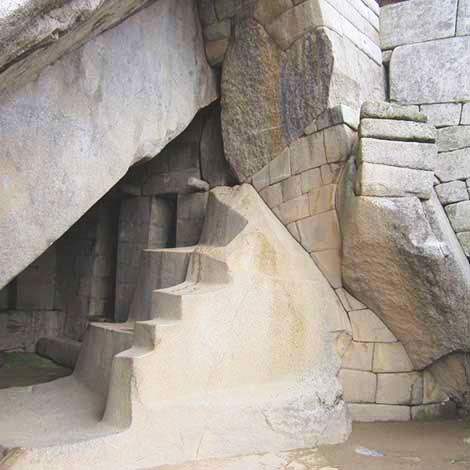
It is also known as the Palace of the Princess. As in the Temple of the Sun, some tall niches were found for the offerings. This natural rock cave is located below the Temple of the Sun. And the base of the building has a structure that resembles that of a cave. It was for these reasons that Hiram Bingham mentioned it as a "grave". And despite being known as the Royal Tomb, no graves or mummies were ever found there. Its purpose was highly debated, probably because it represented access to the spiritual heart of the mountains.
The Funerary rock
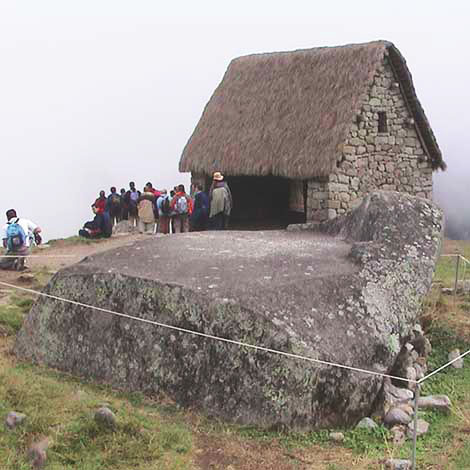
The rock is located just outside the Watchman’s Hut. The different investigations are still not very clear about the main function. Although it is believed that it could be a sacrificial altar. The Funerary Rock is an important symbol of the Inca civilization. Due to its funeral character, the building was intended for the mummification process. It represents, symbolically, the entrance to the cemetery in the Inca citadel. It is also believed that it could also have been used in the mummifications of deceased nobles. In addition, according to some studies, the Funerary Rock also had a close relationship with the study of the cosmos and the stars, especially the sun.
The Sacred Plaza
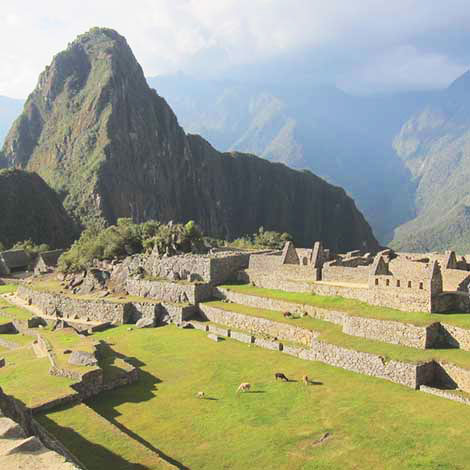
The Sacred Plaza or Central Plaza is the large green area that separates the residential buildings from the functional buildings. It was a political and social center. Due to its excellent location, it was considered the most important architectural ensemble of the Inca citadel. In its surroundings, you can find some of the most important structures. Among them are the Main Temple, the Temple of the Three Windows, Intihuatana, the Temple of the Moon, and the Priest's House. It is the commonplace of the different llamas that graze in the surroundings.
The Intihuatana
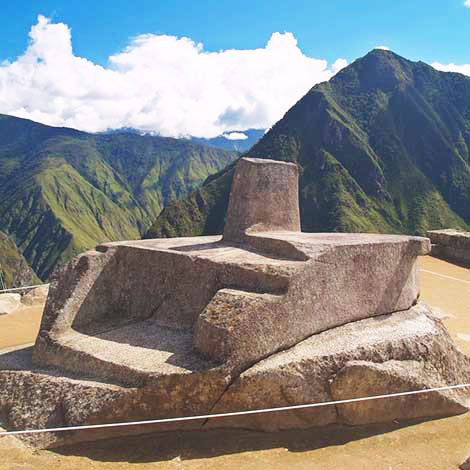
It is one of the most emblematic and iconic places of the archaeological complex. Intihuatana means "Hitching Post of the Sun" and refers to the carved rock pillar at the top of the Intihuatana hill. It has been carved in the shape of the Inca Empire's map. Its exact use remains unclear, but the Inca astronomers were able to predict the solstices using the angles of this rock pillar. Besides, the Intihuatana seems to be aligned with important mountains such as Veronica, Salkantay, Pumasillo, and Huayna Picchu. This structure was not the only one of its kind, but it is one of the only ones in contemporary times. Intihuatanas from other sites were destroyed by the Spanish.
The Temple of the Moon
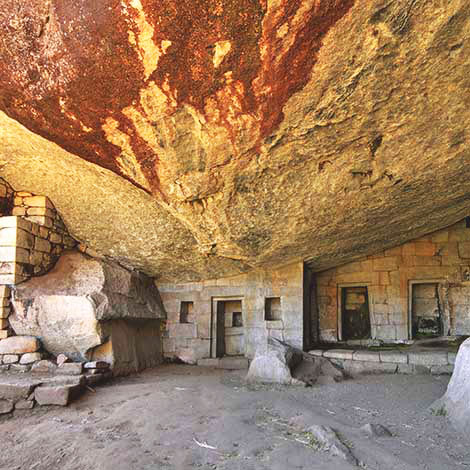
The Temple of the Moon is an Inca ceremonial temple. The site has stone masonry and a shallow cave. In the center of the cave is a throne carved out of the rock. This temple is located inside a natural cave below the top of Huayna Picchu mountain. Its name is due to the fact that it is often lit up by the moonlight. However some archeologists believe the structure was probably dedicated to the spirit of the mountain. The Incas believed the caves could connect them with the world of the dead. The caves are believed to have been used to house mummies.
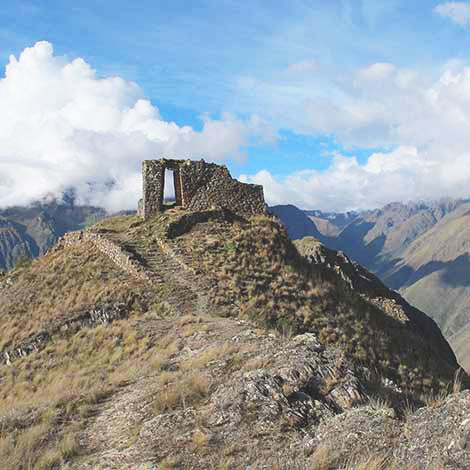
Intipunku or the Sun Gate is one of the most important archeological constructions around the Machu Picchu sanctuary. It was once a fortress of the Inca citadel and, according to history, its steps were a control gate for those who entered and exited the citadel. Intipunku was designed to workshop the Inti, the Sun god. The rising sun passes through the Sun Gate each year on the summer solstice. Nowadays, it's also the name of the final section of the famous Inca Trail. At the top of Intipunku construction, you will witness an incredible view of the entire site, with the unmistakable shape of Huayna Picchu in the background.
Aguas Calientes
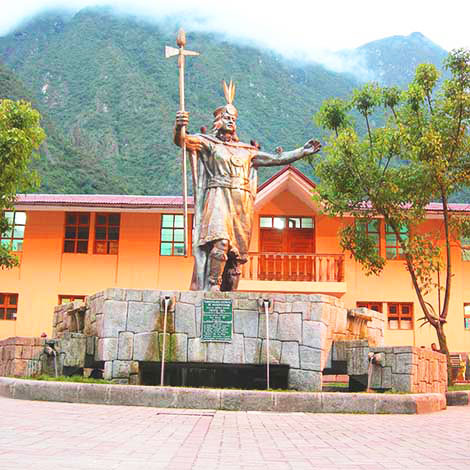
Also known as Machu Picchu Pueblo , this town is the closest access point to the historical Inca citadel, about 6 km away. The name Aguas Calientes translates to Hot Springs, and that is why it bears that name. Despite being a small town, it has a lively and bustling vibe which counts with many hotels and restaurants, as well as natural hot springs. The small town can be an excellent alternative where to stay. It is located much lower than the Sacred Valley and Cusco. What makes it an ideal destination to acclimatize to the height of the Inca citadel.
The Thermal baths
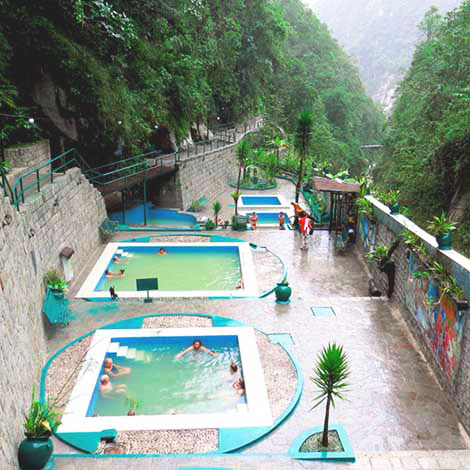
Machu Picchu Museum
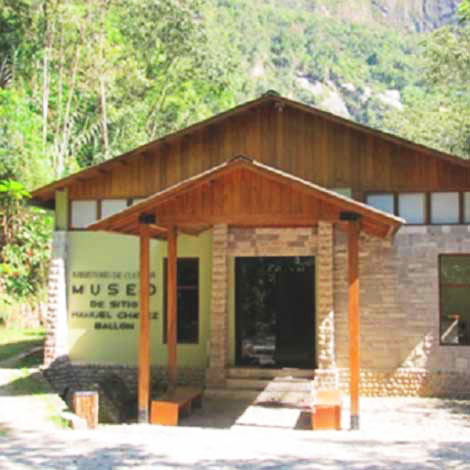
The museum is located in Puente Ruinas, approximately 2 km. from Aguas Calientes, at the foot of Machu Picchu mountain. It's dedicated to the Inca citadel history. It has a series of rooms with interactive displays with lots of interesting facts. You will get an understanding of the importance of these ruins and Inca history.
Principal temple
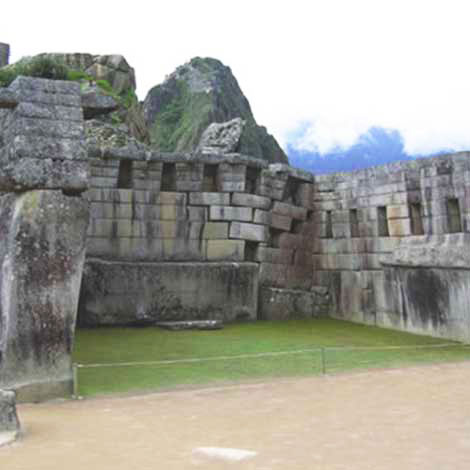
This is another of the most important buildings around the Sacred Plaza. Its name is due to its large size compared to the other structures. Together with the Temple of the Three Windows, they make up the two buildings with the greatest spiritual significance. This temple is an impressive rectangular-shaped building that counts with massive solidity and perfection. It consists of two lateral walls and one rear wall, and a total of seventeen trapezoidal-shaped niches which were used for ceremonial offerings. During the Inca times, the temple housed royal mummies since the Incas considered them as deities. They worshiped not only them but also their supreme god Wiracocha.
House of the High Priest
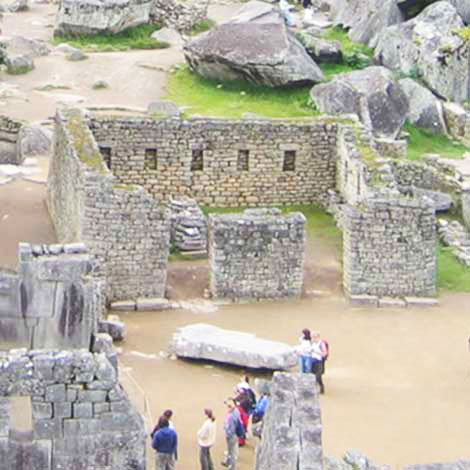
It is another of the important structures around the Sacred Plaza. It is not entirely clear whether a high priest actually lived there. But it is one of the only residences with four walls. Located in front of the Principal Temple, it was built with a lower architectural quality than the temples on its sides. There is little information about these mysterious ruins. One of the many mysteries of the archaeological complex that still have to be solved.
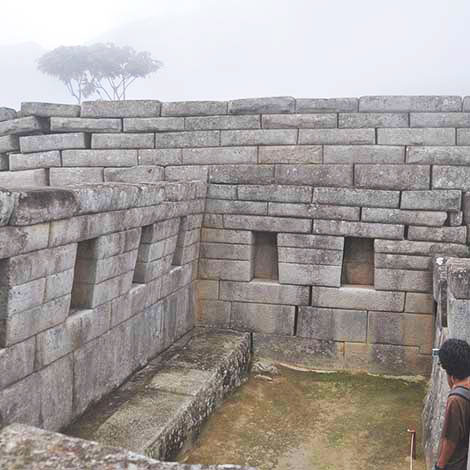
Considered by many to be one of the finest structures in the citadel. It is also often called the "House of Ornaments". This small but famous building is located behind the Principal Temple. It counts with many well-carved niches used for the storage of ceremonial objects. The Sacristy is known for its two rocks flanking its entrance that contain 32 angles each. Inside you will see an unusual low platform at the bottom of the back wall. It seems that it was used as a kind of stone seat or bed.
Inca Drawbridge
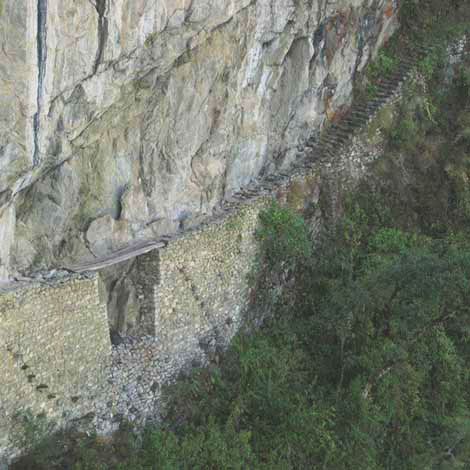
It was built as a secret entrance for the Inca army. The Inca bridge is an original wooden drawbridge that was designed to control access to the Inca citadel. There is an elevated walk that brings you from the Hut of the Caretaker to the Inca drawbridge. But you will only be able to admire the bridge from a nearby viewpoint since, some years ago, someone crossed and tragically fell. Actually, there is no bridge, if not a stone section in the middle of a cliff. Where there should be a bridge there is a drop of about 6 meters. This gap is usually filled in with several tree trunks.
Huayna Picchu
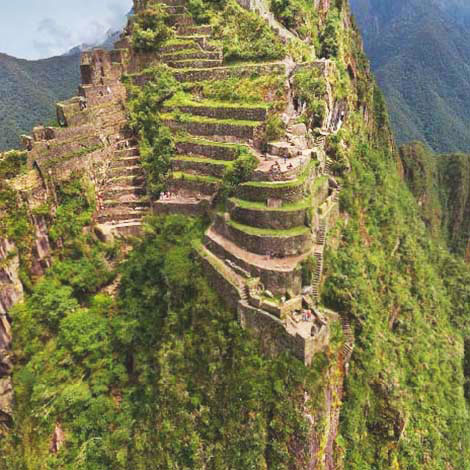
It is one of the most spectacular panoramic views of the Inca citadel. The famous Huayna Picchu or Wuayna Picchu is located behind of the Inca citadel, at a height of 2,720 m. You can get there using a path that departs from the Inca citadel. It is not a hike with great difficulties and it has many advantages to be able to enjoy it. You can enjoy the exclusive Temple of the Moon and much more. At the top of the mountain, you will not only find a small set of Inca constructions but also witness breathtaking and amazing views of the ruins. The tickets have to be booked in advance as access to Huayna Picchu is limited to 400 people per day.
Temple Of The Cóndor
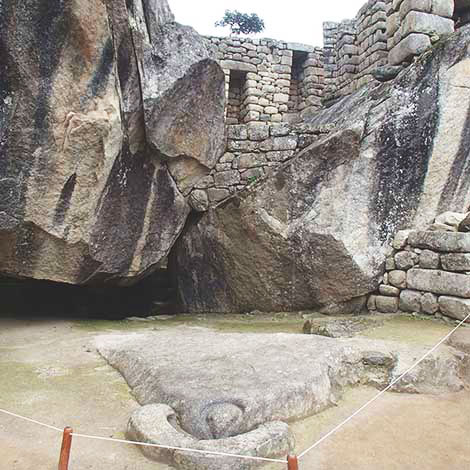
The Temple of the Condor is situated in the urbanized zone of the Inca citadel where you will find a gigantic stone condor carved in fine detail with its wings extended as if it were in full flying. Definitely, one of the most spectacular and impressive examples of what the Incas could do with the stones. In fact, the condor was a sacred symbol for the Inca civilization, a god that was worshiped since it represented wisdom and the celestial domain. It was called hanan pacha in Quechua.
Guard House
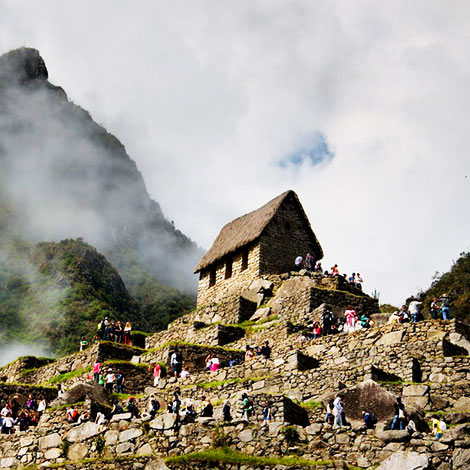
With total security, we can affirm that the Guard House is the most visited point in Machu Picchu. It is due to its strategic location, over the agriculture sector, in the upper zone. With a panoramic view of the citadel, many scholars affirm that this enclosure was inhabited by the guardian of the citadel, who controlled the entry and exit of people to Machu Picchu. The enclosure has three windows that overlook the Inca drawbridge and the final part of the Inca trail, the only two entrances that connect the citadel with the outside world. But you already know, if you are wondering where the best postcards of the archaeological complex are taken, the guardian's house is your answer.
Sacred Rock
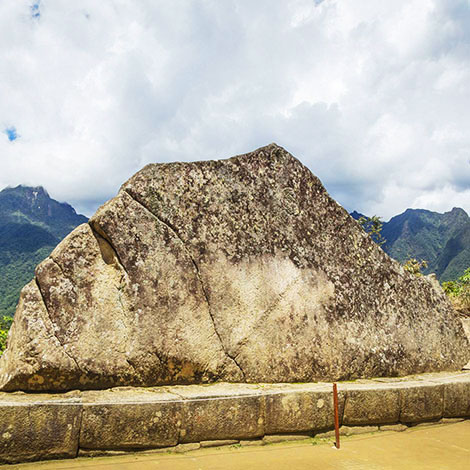
This 3-meter-high monolith with a 7-meter base is located at the north end of the archaeological complex, close to the Huayna Picchu mountain path entrance. This fine-carved rock resembles the shape of the Pumacillo, a mountain located many kilometers from it, but in its same parallel. The rock is between two Huayranas (Inca rectangular roofed enclosures where visitors or participants of an Inca ceremony rested). This is the main reason why it is believed that Sacred Rock was used as an atrium for the worship of the Apus (mountains). Also, its base is finely carved too and could serve as a platform where were deposit offerings to the mountain.
Temple of The Three Windows
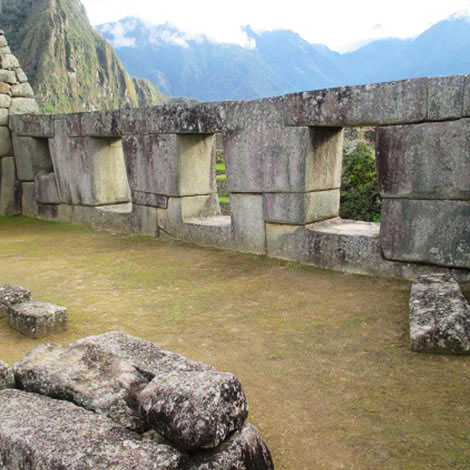
This was an enclosure in the "Hannan" sector or high neighborhood of Machu Picchu, surrounding the Sacred Plaza, where all religious and ceremonial buildings were situated. Today, the enclosure no longer exists but a trapezoidal wall remains that faces the north sector of the citadel. This wall, of perfectly carved stone, contains three trapezoidal windows in the direction to the north. Besides them, there are two covered windows (niches), each one in the west and east extreme of the wall, respectively, where gold and silver offerings were placed. This temple was used for religious ceremonies. Some scholars affirm that the worship activities developed there were destined for the Inca trilogy, Uku Pacha (underworld), Kay Pacha (this world), and Hannan Pacha (the heaven). These could be represented by the three windows.
Things to Do in Aguas Calientes
Aguas Calientes is named after the hot springs in the city that are often overlooked. For most travelers, the main reason to come to Aguas Calientes is to get to the dazzling Inca citadel. That is why it is also usually known as Machu Picchu Pueblo.
Therefore, there are several interesting things to do in Machu Picchu , like swimming in the hot springs or appreciating a great variety of butterflies in "the butterfly house". Also, the local town has two beautiful waterfalls; Mandor and Allcamayo, where you can refresh their waters from the warm and humid weather. In addition, the town counts with hotels, bars, and restaurants. You will find typical Peruvian and Cusco food to spend the night before or after your tour. Keep in mind that Aguas Calientes is not necessarily on the renewing front of Peruvian cuisine. But if you are looking for high-end restaurants, you may want to explore the luxury hotels in town.
Tips and preparation for visiting Machu Picchu
Without a doubt, a visit to Machu Picchu will be one of the most fulfilling and exciting trips you will ever embark upon. But it's important to take care of all the details to be able to take advantage of your journey. Before embarking on your vacation, take into consideration these tips:
Choose the right time
The archaeological complex is located high up in the Andean mountains and covered with tropical forests. For this reason, it's pretty important to choose the right time for visit Machu Picchu.
There are two seasons in the highlands, the dry and the rainy season. The dry season, from May to September, coincides with the high season. During these months, there are clear skies and no risk of rain or fog, but large crowds. While in the rainy season, from October to April, you will expect highly daily rainfalls but short crowds.
Post note: The Inca Trail is closed in February for maintenance work.
Passport and other documents
The passport, as the main international ID document to enter and out of any country, will have to be valid 6 months beyond your dates of travel and a visa if is required. For those persons from the United States, a visa to enter Peru is not required. For the rest of the countries, it`s recommendable to find out the entry requirements at the embassies of the different countries existing in Peru.
Before departing from your country to come to Peru, make a copy of your passport, and main traveler documents and guard them in other parts of your original documents (In case these last ones are lost). Another important recommendation is to take photos of these documents and carry them on your cell phone, for any urgent or emergency.
Medications and treatments
If you come to Peru with any pre-existing disease or treatment, make a detailed list of your medicines. If necessary, supply these in your country of origin before taking the flight to the Andean country. It may be that some of your medications are not in Peru.
Backpacks or bum bags
Pack a carry-on bag, with a second change of clothes, in addition to your large suitcases for your international flight to Peru. Just in case of loss of luggage in the hold.
Entrance ticket to Machu Picchu
As we told in before paragraphs, the archaeological complex has strict regulations regarding the number of visitants per day. This is due to the results of a recent study of load capacity, erosion, and deterioration of the Inca wonder. For this reason, the maximum capacity of visitors per day is around 4000. Consequently, the Machu Picchu entrance tickets for a certain day are sold out 4, even 5 months in advance. In this case, having already your entrance tickets, even before your flights to Peru, or your hotels, or tours will be the best recommendation. Happily, Peru has the best travel agencies in South America who can help you with this item.
Trains to Machu Picchu
There are two train companies in Cusco, Peru Rail, and Inca Rail. Both offer transportation services from Ollantaytambo (a train station located 31 km from Aguas Calientes). Happily, both train companies have the same regulation regarding luggage and backpacks onboard. You can take a duffel bag or carry-on bag of a maximum of 10 kg (22 lb) with dimensions of 62 inches or 158 cm (height + length + width) on board the train. Of course, if you are going to spend not more than 2 days in Aguas Calientes a backpack of 25 liters will be more than enough.
Therefore, preparing an extra backpack, besides your large luggage to come to Peru, will be important.
Inform yourself before traveling
Tourism means planning. In this sense, learning about the weather, the exchange rate, and processes to reach a certain destination, will be of great importance. For that, there are travel blogs like Machu Travel Peru that contain updated information about travel in Peru. We encourage you to take a look.
Book your ticket in advance
We recommend buying your ticket well in advance to find availability. Aside from that, they are highly in demand, the Peruvian government established crowd-control measures. Thus, in order to avoid disappointment -especially during the high season- two or three months in advance would be great. See more information about Huayna Picchu tickets .
In addition, the Machu Picchu entrance ticket is only valid for one day. Thus, take into consideration that there is no possibility of exchange or refund. So it is highly recommended to make your reservations long before you plan to leave for Peru.
Stamp your passport
Just outside the entrance to the Inca citadel, there is a barely marked station where you can get your stamped passport. If you are looking to fill your passport with the wonderful stamp of Machu Picchu, you cannot miss this opportunity.
Altitude sickness
You never should underestimate altitude sickness during your visit to the Inca citadel. As we mentioned above, the best way to avoid it and make your trip pleasant and without problems is to spend a couple of days in Cusco without doing any activities that demand a physical effort. Avoid over-fatigue and keep hydrated as much as you can. Your body will be acclimatized to the new height. Also, another way to prevent the symptoms is taking coca tea or chewing coca leaves which will help you to recover your energy.
Arrive early
The best way to avoid the crowds at the Inca citadel is to arrive as early as possible. You can stay in Aguas Calientes for the night and go to the sanctuary really early in the morning. The archaeological complex opens for the first shift of visitors at 6:00 a.m. You will also have the opportunity to watch a dazzling sunrise over the Inca ruins.
Pack light and smart
Make sure you are well-prepared with the essentials to make your experience unforgettable. Don't forget to bring a sun hat, sunscreen, insect repellent -locals use shampoo as an anti-mosquito method-, comfortable hiking shoes, raincoat, and layers of clothing -Andean weather is kind of unpredictable-. Also, water, snacks, and extra cash.
Complementary walks
Both for the mountain of Huayna Picchu and for the mountain of Machu Picchu will require a separate ticket. As with entrance tickets, there are a limited number of tickets. The view of the Inca ruins is usually a highlight for visitors, but the views offered by these routes are fascinating. The Huayna Picchu hike may present some steeper and narrower sections. While the Machu Picchu mountain route is much more relaxed and family-friendly. Keep in mind that doing both walks on the same day is virtually impossible.
Although Machu Picchu and Huayna Picchu require tickets, there are free hiking opportunities inside the Inca citadel such as The Sun Gate and the Inca Bridge. The first one takes around two hours round trip and the second one takes less than an hour round trip. Both are relatively gentle trails where you will witness fantastic and impressive views of the archaeological complex. You will have magnificent possibilities to take a great variety of Machu Picchu pictures .
Stay for lunch
Just outside the entrance, you can find a wonderful cafeteria and a casual bar with a fascinating terrace. Although we highly recommend having lunch at the Sanctuary Lodge buffet. It can be a bit expensive but it is worth every penny. In case you are traveling on a budget, the town of Aguas Calientes has wonderful restaurant options. Some are cheaper than others.
Food and drinking
Life is too short to eat bad food, isn’t it? Check out some of the best restaurants in Aguas Calientes.
Inkaterra Hotel Restaurant
Inkaterra Hotel is a hotel chain that is considered the best in Aguas Calientes. This contemporary place is an airy open dining room that overlooks beautiful forest gardens. The menu counts with a variety of dishes, they include traditional Peruvian and international cuisine.
Located in the railroad Km. 110. It’s open daily, from 12 p.m. to 4 p.m. and from 6 p.m. to 10 p.m.
The Tree House
The Tree House is a delightful and welcoming restaurant that counts with peaceful Zen vibes and a laid-back atmosphere. It offers a great variety of dishes dubbed "Peruvian Fusion". A few examples of the exquisite fusion cooking on offer are Camote Ravioli, Cuy Confitado, and Thai chicken soup.
It’s located in Jr. Huanacaure 105 and it’s open daily, from 12 p.m. to 9 p.m.
Indio Feliz Restaurant Bistro
It offers an original and delicious Franco-Peruvian cuisine in a cozy and welcoming atmosphere.
It’s located in Calle Lloque Yupanqui 103. It’s open daily, from 12 p.m. to 10 p.m.
Toto’s House
This cozy restaurant offers a buffet lunch (served from 11:30 a.m. to 3:00 p.m.), oven pizza, grill, a great selection of main courses, desserts, and many more. It’s specialized in Peruvian and international cuisine.
Toto’s House is located in the heart of Aguas Calientes, facing the main shuttle bus stop. From there, you will have nice views of the Vilcabamba River. The dining room decoration is dominated by a grill stove. It’s open daily, from 11 a.m. to 4 p.m. and from 6 p.m. to 10 p.m.
Chullpi Machu Picchu Restaurant
This restaurant has a sophisticated and minimalist atmosphere. It offers a stylized, and avant-garde version of the exquisite flavors of Peruvian cuisine. Vegan options are available as well.
It’s located in Av. Imperio de Los Incas 140. It’s open daily, from 12 p.m. to 10 p.m.
Full House & Peruvian Cuisine
The best dishes of Cusquenean and Peruvian cuisine you will find in this restaurant. The Full House & Peruvian Cuisine is one of the Aguas Calientes restaurants that fastest growing in recent years. Soups, typical dishes, Peruvian snacks, desserts, pizzas, and much more. It is located close to the hotel Casa Andina and the Vilcanota river. Enjoy a great dinner with a spectacular view of the river and the spirit of Machu Picchu seeing you since up.
It’s located in Av. Imperio de Los Incas Nº 620 and it’s open daily, from 11 a.m. to 22 p.m.
Mapacho Craft Beer Restaurant
Mapacho Craft Beer Restaurant is the best option if you want to spend a relaxed afternoon taking a handicraft beer, chatting for a while, and taste some delicious hamburgers and Peruvian Snacks. The restaurant counts a great variety of handicraft beers, and cold and hot drinks, natural juices, smoothies, burgers, pizzas. Definitely, Mapacho is a great option for those who have tasty good beer and some snacks.
It’s located in Av. Imperio de Los Incas Nº 614 and it’s open from Monday to Friday, from 10 a.m. to 22 p.m. And Saturdays and Sundays from 10 am - 00:00 pm.
Chullos Craft Beer & Home Made Food
Chullos is a local initiative of Uriel Huaman chef. Delicious burgers combined with a handicraft beer (made by themselves). Without mention, its specialties are in Peruvian dishes like Lomo Saltado (Sautéed Loin), Aji de Gallina (chicken chili), or Arroz Chaufa (Chaufa rice). Innovation is not lacking in this restaurant, international recipes made with Peruvian ingredients result in delicious combinations of Novo-Andean food. We invite you to try it.
It’s located in Avenida de Los Incas Nº 612 and it’s open daily, from 08 a.m. to 22 p.m.
Machu Picchu Tours & Treks

As the mist lifts off the mountains and over the Inca ruins, Machu Picchu evokes an otherworldly feeling
It’s one of the world’s most incredible archaeological sites, with a breathtaking location to match. With all that Machu Picchu has to offer, it’s easy to understand why so many are drawn to the visitor heartland of Peru . The ultimate decision is how to get there. Choose a trek or take the train? You could hike through cloud forests along the classic Inca Trail, fulfill your Andes experience on the Quarry Trail or challenge yourself on the Choquequirao trek – it's up to you. We don’t need to tell you why the adventure is worth your while. Our local leaders will keep you safe, informed and inspired every step of the way.
Our Machu Picchu trips
Let's create an exclusive trip for your group.
Machu Picchu highlights
Which route is right for you.
With its spectacular natural scenery and profound cultural encounters, the Inca Trail is an international beacon for trekking. Attracting thousands of hikers each year, it's a challenging yet rewarding hike that stays with you for a lifetime. Although rated moderate, the relentless uphill (and downhill) hiking is tough - the fitter you are, the more you’ll enjoy it.
For an impressive hike off the beaten path, consider the Inca Quarry Trail. This lesser-known trek offers the same magical scenery of the Andes mountains, passing through local villages and visiting three smaller archaeological sites the other trails don’t. Another bonus is that the hike doesn’t require a permit – so once you book, you’re set.
Take your boots further with a challenging eight-day hike moving through high-altitude cloud forests, over mega mountain passes and along an ancient trail leading to the well-preserved Inca city ruins of Choquequirao. This trail might be secluded and not for the faint-hearted but it's also one adventure you'll never forget, and that's a promise.
Meet our team
Why choose us.
All our guides are certified local tour guides and trained in-house on Intrepid Safety Policies. Each trekking guide also receives exclusive Intrepid training, provided by mountain rescue experts in the field.
All our guides and trek leaders have been trained by medical specialists in handling altitude illness and are proficient in first aid. Our team carries oxygen cylinders on all treks for emergency use.
Our team members live and work in the Andean region, which means revenue from all our treks benefit the local economy.
We take care of the details, so you can focus more on enjoying the journey. Our tours include all meals, with essential camping equipment and the option to hire additional hiking equipment if needed.
We are proud to have the tick of approval from the Rainforest Alliance indicating that we meet and operate at the highest standards in environmental, social and economic sustainability.
We strive to use travel as a force for good. That’s why we choose to give back to the communities we visit, carbon offset all our trips and take our social and environmental responsibilities seriously. We’ve been officially certified as the world’s largest travel B Corp, which means when you choose Intrepid Travel, you can rest assured you’re traveling to improve the planet.
Machu Picchu tour reviews
Filter by rating
Inca Trail Express
Peru Family Holiday
Premium Peru
Articles of Machu Picchu
Inca Trail Trek Permits: How to Secure the Easy Way
The joy of seeing Machu Picchu with the descendants of its builders
Machu Picchu or Chichen Itza? Which historical site should you visit?
What I wish I knew before hiking to Machu Picchu
An open thank you letter from blind athlete, Dan Berlin, to his local leader
Behind the scenes on the hardest physical challenge of my life: the Inca Trail
Why trekking the Inca Trail was the best way to celebrate turning 50
10 things you’ll only know if you’ve travelled in Peru
Machu Picchu travel FAQs
What is machu picchu.
Machu Picchu is a magnificent reminder of the power and ingenuity of the Inca civilization.
The ancient citadel, built in the 15th century, was abandoned only 100 years later, and many mysteries remain.
Listed by UNESCO as a World Heritage site in 1983 and announced as one of the Seven Wonders of the World in 2007, Machu Picchu makes a lasting impression.
Where is Machu Picchu?
Overlooking the Urubamba River, the site of Machu Picchu sits above the Sacred Valley – located in the Cusco region of Peru.
How can I get to Machu Picchu?
Many travellers fly into the capital of Cusco before taking the train or choosing a hiking tour. The stepping stone to Machu Picchu is Ollantaytambo, about 1.5 hours away from Cusco by bus.
From Ollantaytambo, the most common ways to get to Machu Picchu are:
- Hiking the Inca Trail (one way to Machu Picchu)
- Taking the equally scenic and rewarding Quarry Trail
- Trekking the challenging 8-day Choquequirao Trail
Can I still hike if I take the train?
So, you want to experience the Inca Trail but aren't quite up for the entire hike?
The one-day option takes you by train part of the way where you hop off and trek the trade highway of the ancient Inca empire.
You will arrive at the Sun Gate in the afternoon to take in the views of Machu Picchu.
Is hiking the only way to get to Machu Picchu?
On all of our trips that visit Machu Picchu, you can choose the rail journey instead of the hike – simply specify while booking that you’d prefer the train option. There's no extra cost for this, though please note fees may apply if you decide to change to the train option after your Inca Trail permit has already been purchased.
Learn more about taking the train to Machu Picchu
When is the best time to visit Machu Picchu?
You can visit Machu Picchu all year round. The most popular time, and therefore the most crowded, is in June and July.
Low cloud cover during the dry season from April to October also means cold nights on hiking trails, so you'll need thermals for a good night’s sleep.
The wet season is from November to March. Temperatures rise and the region receives heavy rainfall, so waterproofs are essential if you're hiking. If you don't mind a bit of rain, the plus side is that crowds are smaller. If you want to hike the Inca Trail, note that it closes every year in February for maintenance.
Can you get to Machu Picchu in a day?
Yes, you can. Starting with an early rise in the morning, take a 1.5-hour bus ride to Ollantaytambo, then a 2.5-hour train to Aguas Calientes, followed by a 30-minute bus to Machu Picchu.
You will have a couple of hours to visit Machu Picchu and then return to Cusco the same way.
None of our trips visit Machu Picchu this way, as we believe it doesn’t allow enough time to explore (and really enjoy) the site and the Sacred Valley area.
How high is Machu Picchu?
Machu Picchu is found deep in the cloud forest at 2440 m (7972 ft) above sea level, sitting at 1000 m (3280 ft) lower than Cusco.
What does this mean for you? In terms of altitude, you're unlikely to experience any altitude issues at Machu Picchu itself.
But be aware, trekking to Machu Picchu involves walking up and down several steep stairs, ramps and terraces at various altitudes, which can be strenuous.
Will the altitude affect me?
Most people start to feel the effects of altitude at over 2000 m (6561 ft) regardless of age, gender or fitness level. While our leaders have basic first aid training and are aware of the closest medical facilities, it is very important that you make yourself aware of the causes and effects of traveling at altitude. Monitor your health and seek assistance accordingly.
It is essential to take it easy, drink plenty of water and speak to your group leader immediately if you feel unwell.
We recommend seeing your doctor if you have health concerns before the trip, especially if you have a pre-existing medical condition or are taking any medication.
Do I need a permit to hike to Machu Picchu?
Everyone hiking to Machu Picchu via the iconic Inca Trail or the shorter Inca Trail Express requires a permit. You don't need a permit to trek via the Quarry or Choquequirao trails.
If you do the Inca Trail with Intrepid, our adventure consultants secure your permit for you so you can focus on getting excited – just make sure you have your passport details handy at the time of booking.
Permits are available on a first-come, first-served basis, so booking well in advance is critical.
We endeavor to purchase your permit within two working days of receiving all necessary information.
What should I pack for Machu Picchu?
For a day trip exploring Machu Picchu, we recommended taking a small backpack with the essentials: sunscreen, hat, water bottle (filled before departing), a few snacks and mosquito repellent. It helps to wear breathable pants, a long shirt and a waterproof jacket – since the UV index is higher in the Andes and the site is prone to rainfall.
If you plan to trek before visiting Machu Picchu, read our detailed packing instructions in your Essential Trip Information.
What is Wayna Picchu?
Wayna Picchu (also known also as Huayna Pichu or Wayna Pikchu) means ‘young peak’ in Quechua – although the mountain appears anything but young, towering behind Machu Picchu.
Known as the ‘stairs of death’, the hair-raising climb takes about three hours to return. More recently, a cap of 400 people a day has been introduced on the number of visitors allowed to climb.
Can I climb Wayna Picchu with Intrepid Travel?
We have performed risk assessments on all our optional activities, and unfortunately, we don't consider climbing Wayna Picchu a safe activity at this stage.
Reaching Wayna Picchu involves climbing steep, narrow and exposed sets of stairs, and we just can't guarantee your safety.
Our leaders are specifically prohibited from assisting you in visiting Wayna Picchu.
What are the toilet facilities like at Machu Picchu?
There are public toilets located at the main entrance of Machu Picchu and none after entering the site – so make sure you time your stop before heading off to explore.
Take some coins with you as there is a small fee to use the toilet facilities.
What does the Rainforest Alliance tick of approval mean?
The Rainforest Alliance is a non-profit organization. It is working to build strong forests, healthy agricultural landscapes and thriving communities.
The green frog seal shows that an enterprise has been audited to meet environmental, social, and economic sustainability standards.
The Rainforest Alliance recognizes Intrepid as one of Peru's top certified tourism businesses.
Can I visit Machu Picchu if I have a disability?
Yes, but of course it will depend on your level of disability, fitness and what support will be available to you.
People who are visually impaired have completed the Inca Trail (with the right support crew, of course).
Contact us to discuss your particular circumstances and we can assess it from there.
Does my trip support The Intrepid Foundation?
Yes, all Intrepid trips support the Intrepid Foundation. Trips to this country directly support our global Intrepid Foundation partners, Eden Reforestation Projects and World Bicycle Relief. Intrepid will double the impact by dollar-matching all post-trip donations made to The Intrepid Foundation.
Eden Reforestation Projects
Eden Reforestation Projects are helping to mitigate climate change by restoring forests worldwide; they also hire locally and create job opportunities within vulnerable communities. Donations from our trips support restoration across planting sites in 10 countries around the globe. Find out more or make a donation World Bicycle Relief
World Bicycle Relief provides people in low-income communities with bicycles to mobilize school kids, health workers, and farmers in far-out areas – giving them access to vital education, healthcare, and income. Donations help provide Buffalo Bicycles – specifically designed to withstand the rugged terrain and harsh environment of rural regions – to those who need them most. Find out more or make a donation
- Search Please fill out this field.
- Newsletters
- Central & South America
- More to Explore
The Best Time to Visit Machu Picchu
:max_bytes(150000):strip_icc():format(webp)/Becker1-5b734a56c9e77c0025caddbd.jpg)
Chris VR / TripSavvy
If you're traveling to Peru chances are your plans could include a visit to Machu Picchu. After all, the ancient archaeological site is the most visited tourist attraction in the entire country, drawing more than a million travelers each year. The best time to visit Machu Picchu is May to June or September to October, when the weather is nice and crowds are thin, but the site is well worth a visit any time of the year.
History of Machu Picchu
Dubbed one of the New Seven Wonders of the World , Machu Picchu is the rare tourist attraction that actually lives up to its massive hype. Located 50 miles northwest of the Peruvian city of Cusco , the ancient mountaintop citadel was originally built sometime around 1450 for the Incan emperor Pachacuti. A century later however, the site was abruptly abandoned for unknown reasons.
For centuries the fortress was unknown to the outside world until an American explorer by the name of Hiram Bingham discovered it in 1911. He spent the next several years excavating the site from the surrounding jungle and mapping its walls and buildings. Bingham's discovery fired the imagination of people across the globe, turning Machu Picchu into one of the best known archeological sites on the planet.
Later, Machu Picchu would be named a UNESCO World Heritage Site and would begin welcoming tourists. Most come via a train out of Cusco, although the more adventurous will hike the Inca Trail to arrive at the fortress via an old road that was used by the Inca themselves.
Visiting Machu Picchu
Nestled high in the Andes mountains, Machu Picchu is open to visitors all year round. That means you can make plans to visit the site no matter when you will be in Peru. Of course, what part of the year is best to accommodate your specific needs depends on several factors, including weather, size of the crowds you're willing to deal with, and how you want to get there.
Visiting During Rainy Season
The rainy season in Peru runs from November into April, bringing gray clouds, frequent rain showers, and the occasional storm with it. In fact, it rains nearly every day during this period, which keeps crowds to a minimum, but can also make a Machu Picchu visit a very soggy affair. On the other hand, the rainy season also brings the warmest weather too, which means that conditions are generally comfortable when the rain isn't falling.
While rain is an ever-present threat at this time of the year, the upside is that the number of visitors to the site is much lower. That makes it easier to explore Machu Picchu at your own pace, although you'll definitely want to pack a rain jacket .
Of special note, January through March are the absolute rainiest of all of the months, so keep that in mind as you make your travel plans.
Visiting During Dry Season
Peru's dry season tends to run from about mid-April to the end of October, with cooler air, bright blue skies, and plenty of sunshine dominating the forecast. The improved weather tends to usher in an influx of visitors to Machu Picchu as well, with more travelers arriving at the site on a daily basis. Cooler temperatures are also a part of the dry season however, particularly in the early morning and later evening. Rain showers aren't completely out of the question either and heavy afternoon mists occur on a regular basis too.
Travelers visiting during this time of the year have a better chance of enjoying a clear, sunny day, although they'll have to deal with larger crowds as well. If you don't mind sharing Machu Picchu with a few thousand of your closest friends, this might be a good time to go.
Visiting in High Season
The high season for Machu Picchu — which is to say its busiest period in terms of number of visitors — comes in July and August. Those months fall right in the middle of the dry season and generally have the most stable and predictable weather of the entire year. Of course, that is exactly why most people choose that time to visit the mountain fortress, leading to some of the largest crowds found at the site all year long.
If you absolutely don't want to deal with crowds, than avoid going during these months. However, if your primary goal is to have the best chance at good weather, than this is when you should book your trip. Just be prepared to wait in line and share the space with plenty of others.
Visiting in Shoulder Season
The so-called shoulder season is when travelers can expect the best mix of weather and crowds, with a good chance of dry conditions and a fewer people. For Machu Picchu the shoulder season takes place in May, June, September, and October. During those months, the chance of rain remains at a minimum and while the crowds remain large, they are not nearly as massive as those found during the high season.
Those looking to optimize their time in Machu Picchu, while still giving themselves the best chance at good weather, the shoulder season is a safe pick. There is a high likelihood that you'll avoid rain and the site won't be completely overrun with other travelers.
Hiking the Inca Trail
As already mentioned, Machu Picchu is open year round and travelers can make plans to visit during any month of the year. But if your goal is to hike the Inca Trail to Incan city you'll want to avoid visiting in February. The trail is actually shut down for the entire month to perform routine maintenance on the route to ensure that it stays safe, scenic, and sanitary. You'll just have to book your trek in one of the other months of the year based on the weather and the size of the crowd you want to contend with.
Best Time of Day
No matter what month of year you choose to visit Machu Picchu your experience can be altered substantially depending on what time of the day you go. The site is open from 6 a.m. to 5 p.m. each and every day, with the largest crowds arriving later in the morning and staying until mid-afternoon.
Savvy travelers can arrive there first thing in the morning and take advantage of the smaller crowds or plan to get there late in the day as other tourists begin to filter out. Taking advantage of this strategy may mean you have to book a night at one of the local hotels, but it could be totally worth it in order to spend time in such an iconic destination with fewer people around.
Frequently Asked Questions
The best time to visit the ruins of Machu Picchu is in the shoulder season, either between May and June or between September and October.
Peru's rainy season lasts from November to April, which can make the hike to Machu Picchu wet and muddy. However, crowds tend to to be much thinner.
Machu Picchu experiences its busiest season in July and August, because these months fall right in the middle of the dry season and the weather is more predictable.
Peru Telegraph. "How many tourists visited Machu Picchu in 2018?" Retrieved February 12, 2021.
Ancient History Encyclopedia. "Machu Picchu." Retrieved February 12, 2021.
Weather Spark. "Average Weather in Cusco, Peru, Year Round." Retrieved February 12, 2021.
Related Articles
More related articles.
How to get to Machu Picchu

The far-flung ruins of Machu Picchu, a former Inca empire, sit atop a Peruvian mountain bathed in fog. These incredible ruins are a popular tourist attraction but not as easy to reach as you might think.
If you're hoping to visit this impressive site, it will take some time to arrive — and you might need to take a collection of planes, buses and trains to make it there. Know, too, that some mask and vaccination requirements are still in place for visiting Machu Picchu, so you'll want to check the latest guidance and prepare accordingly.
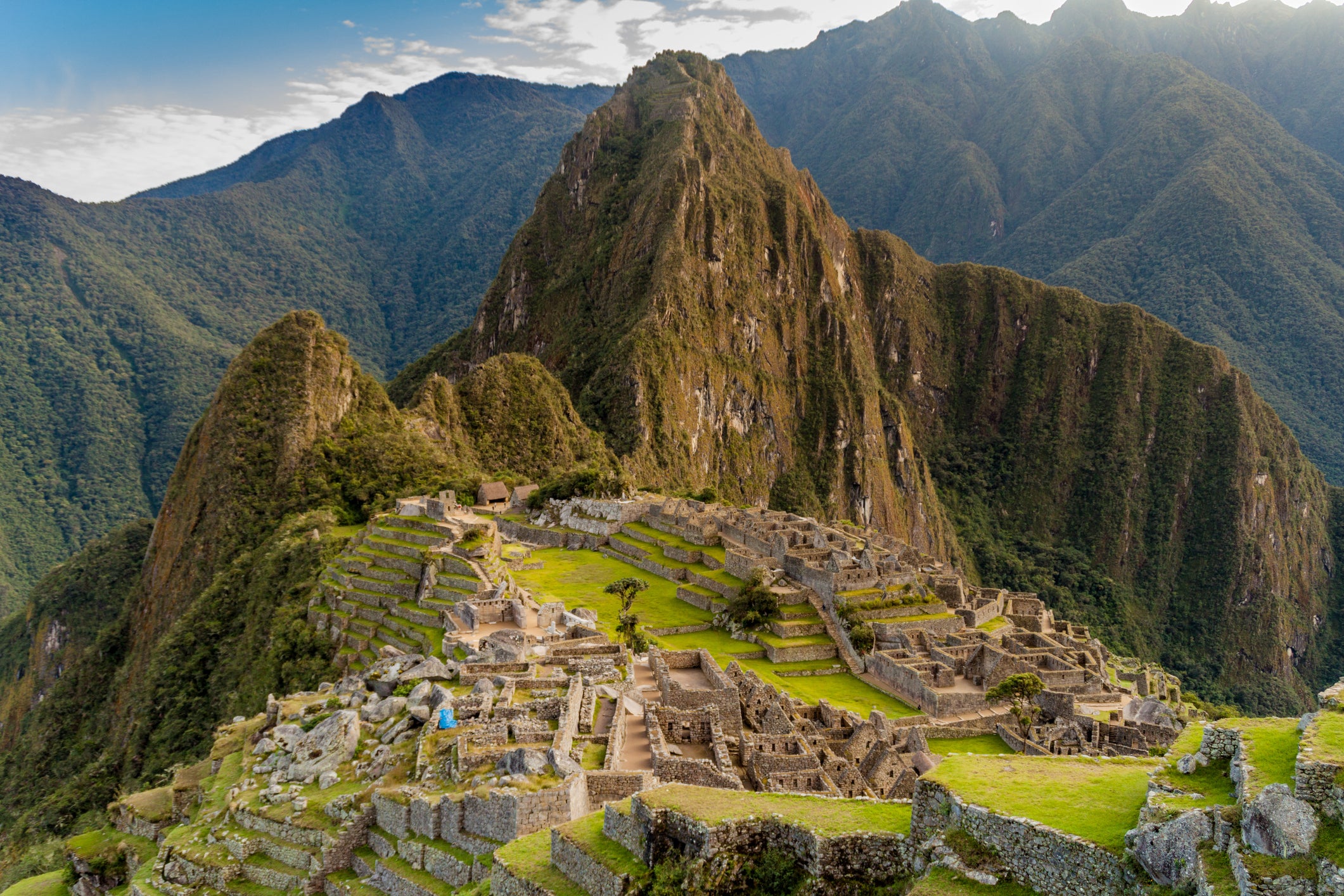
To help you map out your adventure to the "Lost City of the Incas," here's a step-by-step guide with all you need to know about getting to Machu Picchu, including how to use your points and miles for the journey.
Related: The best times to travel to Machu Picchu
How to get to Lima, Peru, from the US
Machu Picchu sits a few hundred miles southeast of Lima, Peru's capital, high up in the Andes Mountains. Since getting to Machu Picchu itself takes several steps, a nonstop flight from the U.S. to this bustling city is often the preferred way to go, though you could also reach Peru from another Latin or Central American hub.
Should you decide to fly directly from the U.S., you'll find that there are various options for flying to Lima nonstop.
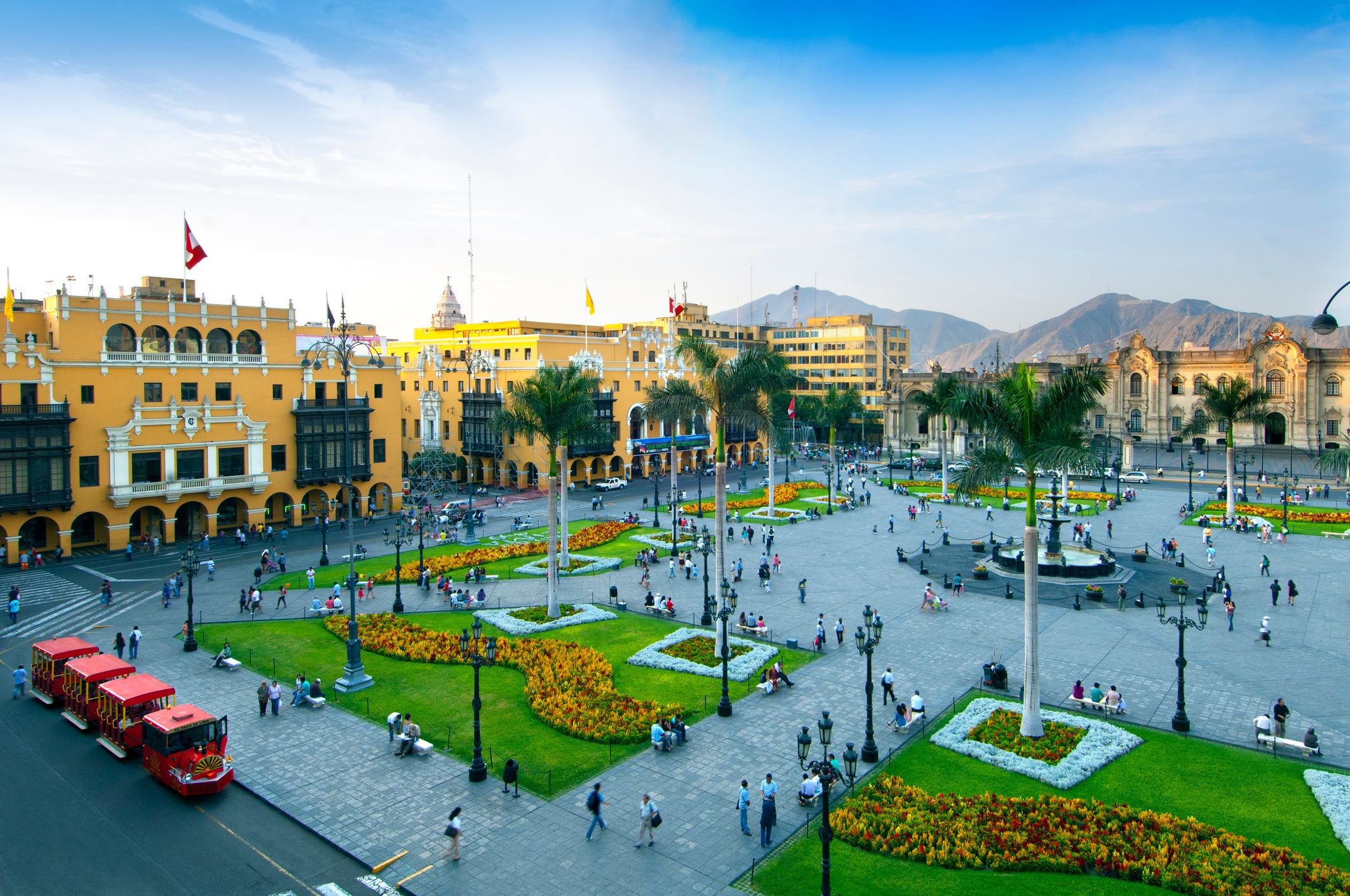
American Airlines flies nonstop to Lima's Jorge Chávez International Airport (LIM) from Miami International Airport (MIA) and Dallas Fort Worth International Airport (DFW) . LATAM Airlines offers service to the city from MIA, John F. Kennedy International Airport (JFK) and Los Angeles International Airport (LAX) , while SkyTeam partner Delta Air Lines flies from Hartsfield-Jackson Atlanta International Airport (ATL) . United Airlines also flies to Lima from Houston 's George Bush Intercontinental Airport (IAH) , and Florida dwellers have even more options from MIA thanks to JetBlue Airways and Spirit Airlines , both of which fly nonstop to Lima.
Since Delta and United use dynamic pricing, you'll have to try your luck when it comes to getting solid award fares. However, you can use credit card rewards to help you accrue enough miles to cover the cost of flights. Chase Ultimate Rewards transfer to United, while American Express Membership Rewards transfer to Delta. Those with Delta elite status may want to fly with LATAM since Medallion status and benefits are recognized thanks to a reciprocal partnership between the two airlines .
Related: The complete guide to earning and redeeming with LATAM Pass
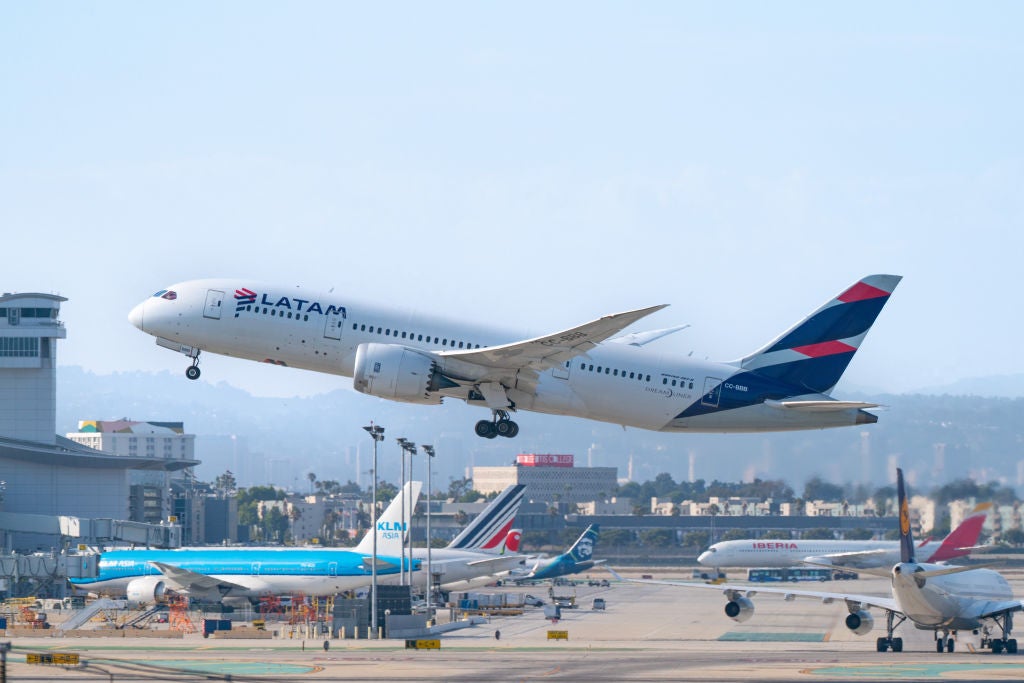
If you need to stock up on LATAM Pass miles, you can transfer Marriott Bonvoy points to LATAM Pass at a 3:1 ratio, with a 5,000-point bonus for every 60,000 points you transfer. If LATAM is your best option and you want to use miles, consider getting a Marriott cobranded credit card to earn a point bonus that'll transfer to the airline for your Machu Picchu adventure. Other options for earning LATAM Pass miles include opening one of the airline's cobranded credit cards or booking hotels using Rocketmiles .
Oneword flyers should consider flying American. The airline does publish an award chart , though it's rare to find prices as low as specified due to dynamic pricing. However, if you're lucky (and traveling on off-peak dates), you might find a one-way MileSAAver Off Peak award ticket for 17,500 AAdvantage miles in economy or a one-way MilesSAAver award ticket for 30,000 miles in business class.
For those sans points and miles, tickets on Spirit from Miami to Lima can often cost less than $300 round trip. Just know that everything from your carry-on bag to seat selection and beyond will cost extra on Spirit.
Related: Everything you should know before flying Spirit Airlines
How to get to Cusco, Peru, and the Sacred Valley from Lima
No, you're not at the base of the Andes just yet. The next step in your Peruvian adventure should be to get from Lima to Cusco. The most direct way to arrive is by plane, which takes about an hour from Lima. There are other options like the bus, but considering it can take around 25 hours (or more), flying is the quickest choice.
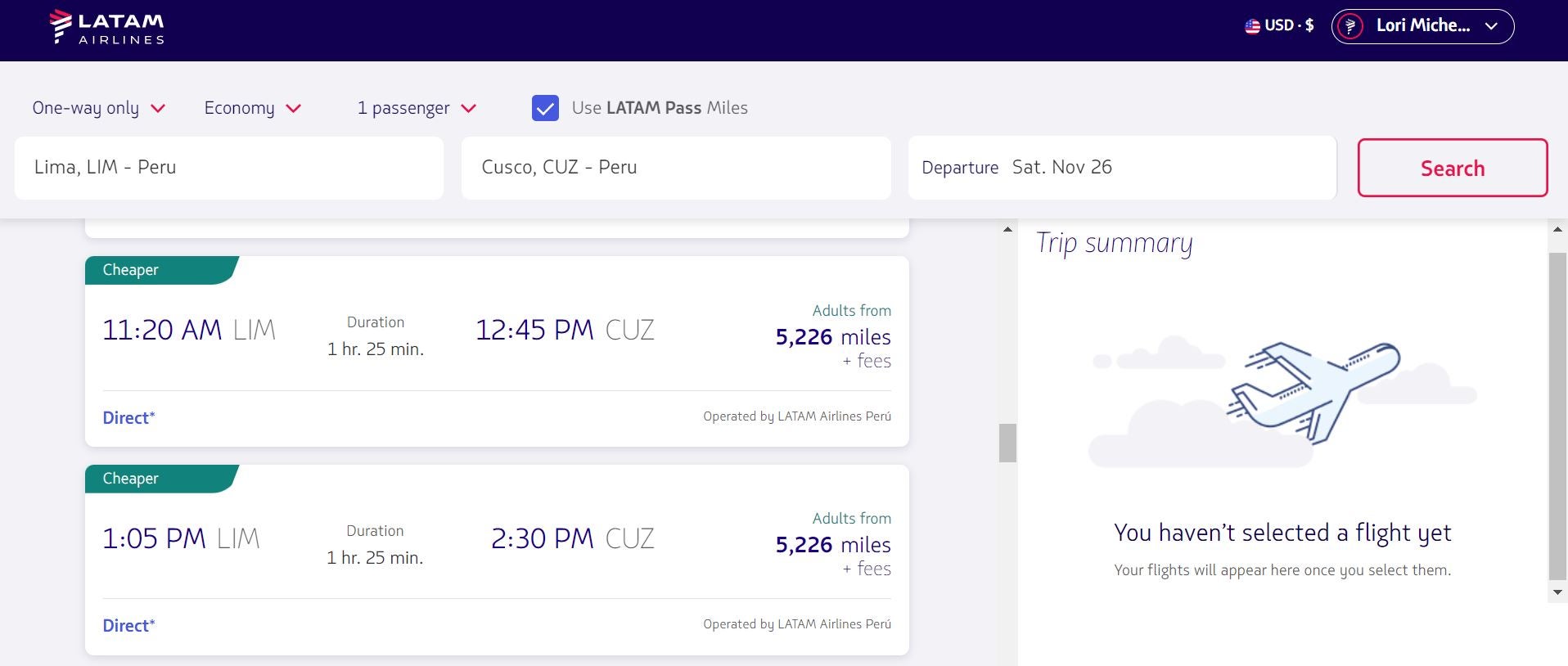
The ideal option (especially for Delta elite flyers) is LATAM, which offers one-way award tickets for a little more than 5,000 LATAM miles, plus fees. But you may not want to bother with miles, as tickets cost around $50 each way. Those ready to brave a low-cost carrier might be able to shave $10 or $15 off LATAM's price by flying with a carrier like Sky Airline, JetSmart Airlines or Viva Air Colombia.
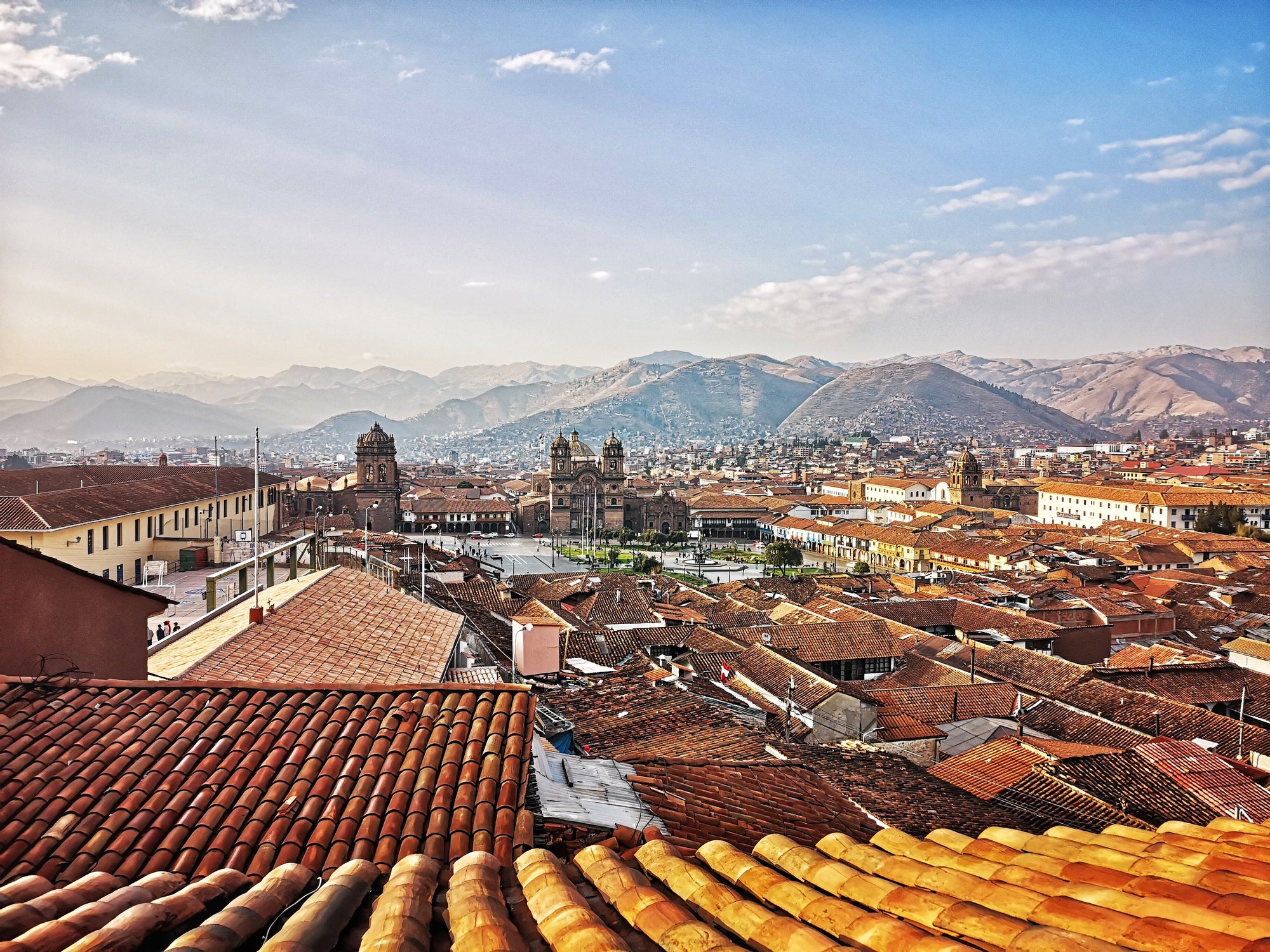
Once in Cusco, you'll want to spend at least one night in the city itself or the surrounding Sacred Valley , as getting to Machu Picchu will still take a considerable amount of time after arriving.
How to get from Cusco to Aguas Calientes, Peru
This is where the fun really begins. The quickest way to arrive at the gateway to Machu Picchu, the town of Aguas Calientes, from Cusco is by train, which takes around three hours. There's also a two-hour train ride you can take from Ollantaytambo, Peru, to the site, should you decide to stay in the Sacred Valley before continuing your journey. Other options, including a bus and hiking, are available as well.
The most luxurious train to Machu Picchu is the Hiram Bingham , a Belmond-operated train that costs around $500 one-way. Aside from this splurge, the main trains — known as the Expedition and the Vistadome — are operated by PeruRail . The Expedition trains cost about $60 each way, while the Vistadome trains cost around $75 per one-way ride. The latter provides an enhanced experience that includes snacks and even a fashion show where travelers can view and purchase items made from alpaca wool.
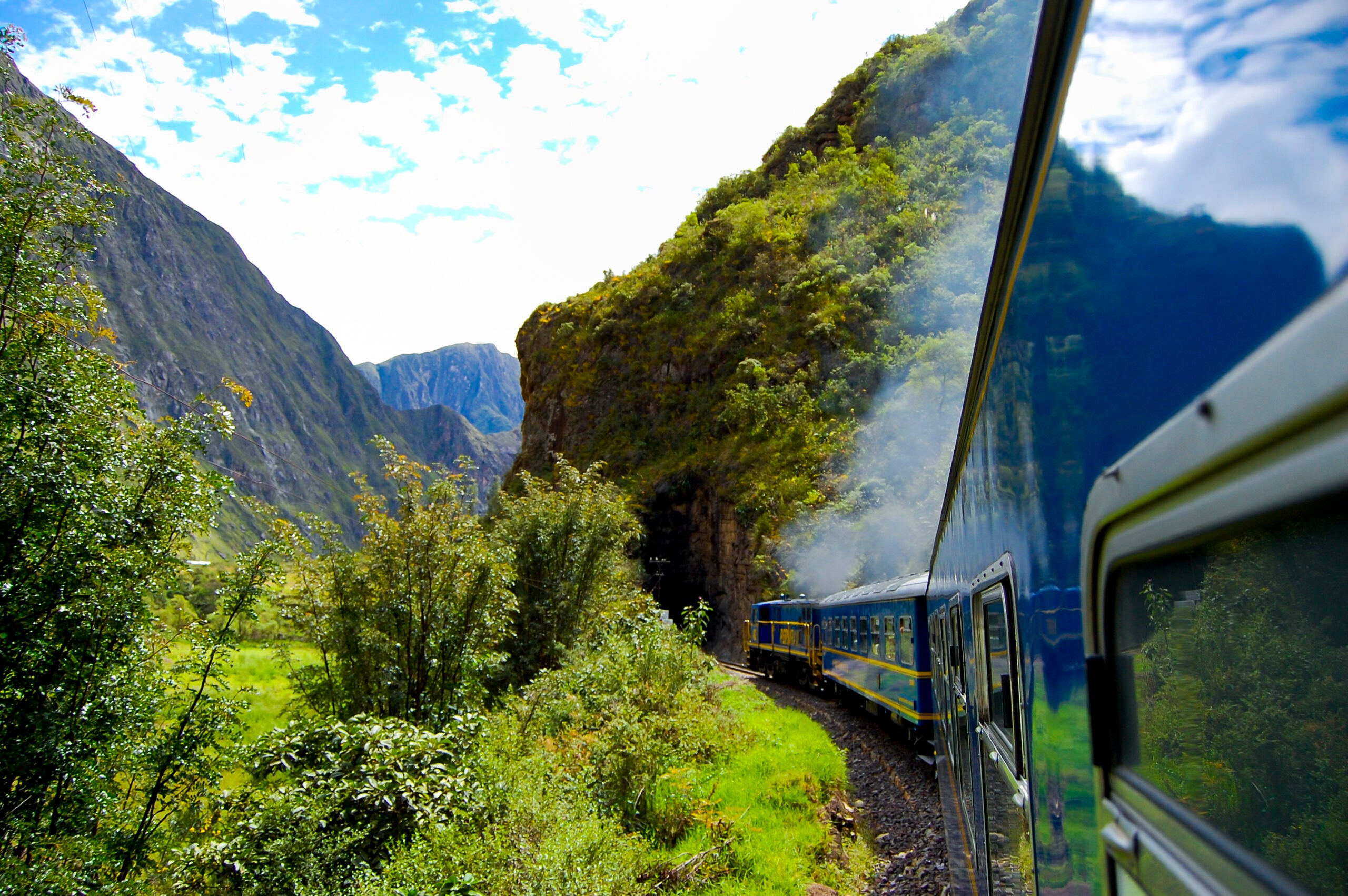
Inca Rail is another train company that offers various options for travelers between Cusco and Aguas Calientes via its Voyager and 360 trains. Prices are comparable to the PeruRail trains, and, like PeruRail, Inca Rail also offers an exclusive train experience. Inca Rail's Private train gives you and your group an entire train car to yourselves, where you'll enjoy a three-course meal, Champagne and a Peruvian cooking class as you travel. This particular service even offers a private bus to Machu Picchu from the train station.
If you can't decide between Inca Rail and PeruRail, use budget and timing to decide. Pick a train that's the right price at a time that's most convenient for you, as the services are relatively similar. LATAM Pass frequent flyers may want to select Inca Rail trains, as you can connect your account and earn one LATAM Pass mile for every dollar spent on Inca Rail.
Trains to Machu Picchu leave from the Poroy train station, which is located 11 miles outside of Cusco. If you're staying in or exploring the Sacred Valley, you can catch the train from the Ollantaytambo train station, which is less than 40 miles northwest of Cusco. The last stop on each route is the Aguas Calientes station.
Bus and walking
Budget travelers (or anyone up for a unique, scenic experience) should consider the shuttle and walking trail option known as the Hidroeléctrica. Since there are no actual roads that lead into the town of Aguas Calientes, you can't drive all the way, so while you'll take a bus the majority of the way, a three-hour trek is required at the end.
To partake in this option, you'll need to book a spot in a group shuttle (your hotel or any tour operator can help you book one) that departs from either Cusco or Ollantaytambo. The journey will cost anywhere between $10 and $25 per person, depending on the bus and how many people are in your group. You'll weave through the Andes as you approach Aguas Calientes, stopping for lunch in a town called Santa María. Once the shuttle drops you off at a location that seems to be in the middle of nowhere — the Hidroeléctrica — you will enjoy a peaceful walk alongside train tracks for about three hours until you arrive at Aguas Calientes.
For this journey, be sure to pack light, as you'll be carrying your belongings on your back. Some Cusco hotels let you leave larger suitcases or luggage in their storage rooms if you plan on returning to Cusco again for a night after your Machu Picchu visit, so consider one of these properties if you don't want to bring all of your belongings during the walk.
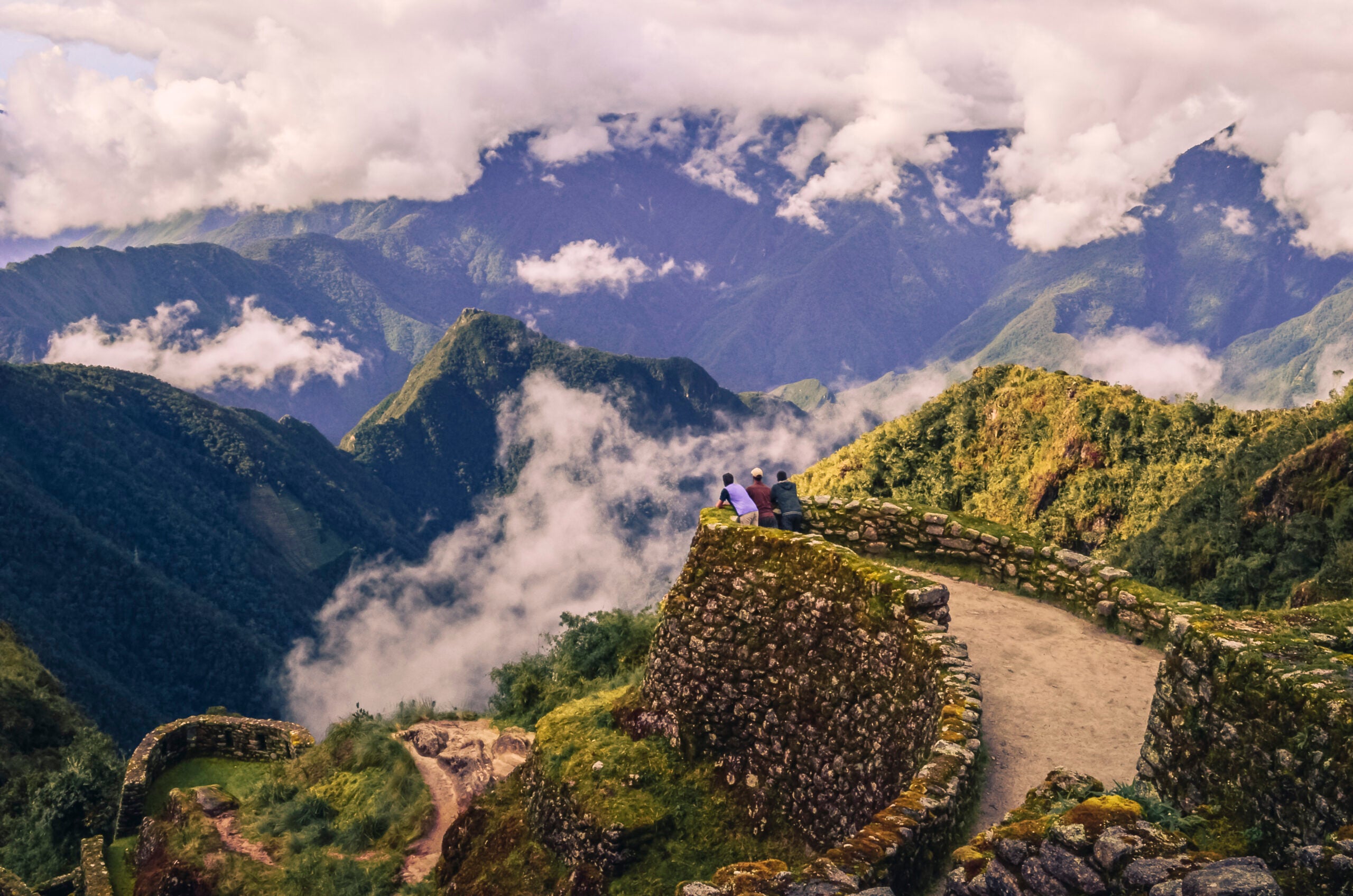
There are various guided treks that end in Machu Picchu. Depending on the option you choose, you'll find that they last anywhere from a few days to weeks.
Hiking the Inca Trail — the most famous route — starts from a base near Cusco. Additionally, there are alternative treks that leave from other bases in Cusco and the Sacred Valley, including the Lares Trek and the Salkantay Trek. These treks are guided and typically include meals and porters. It's best to book through an online travel provider or agency.
In some instances, travelers have been able to walk the entire route along the train tracks from Ollantaytambo to Aguas Calientes. However, this free, eight-hour walk can be unsafe at times due to train tunnels. It's highly monitored by track guards, so we don't recommend this option.
Related: 9 mistakes travelers make when visiting Machu Picchu
The final step: Aguas Calientes to Machu Picchu
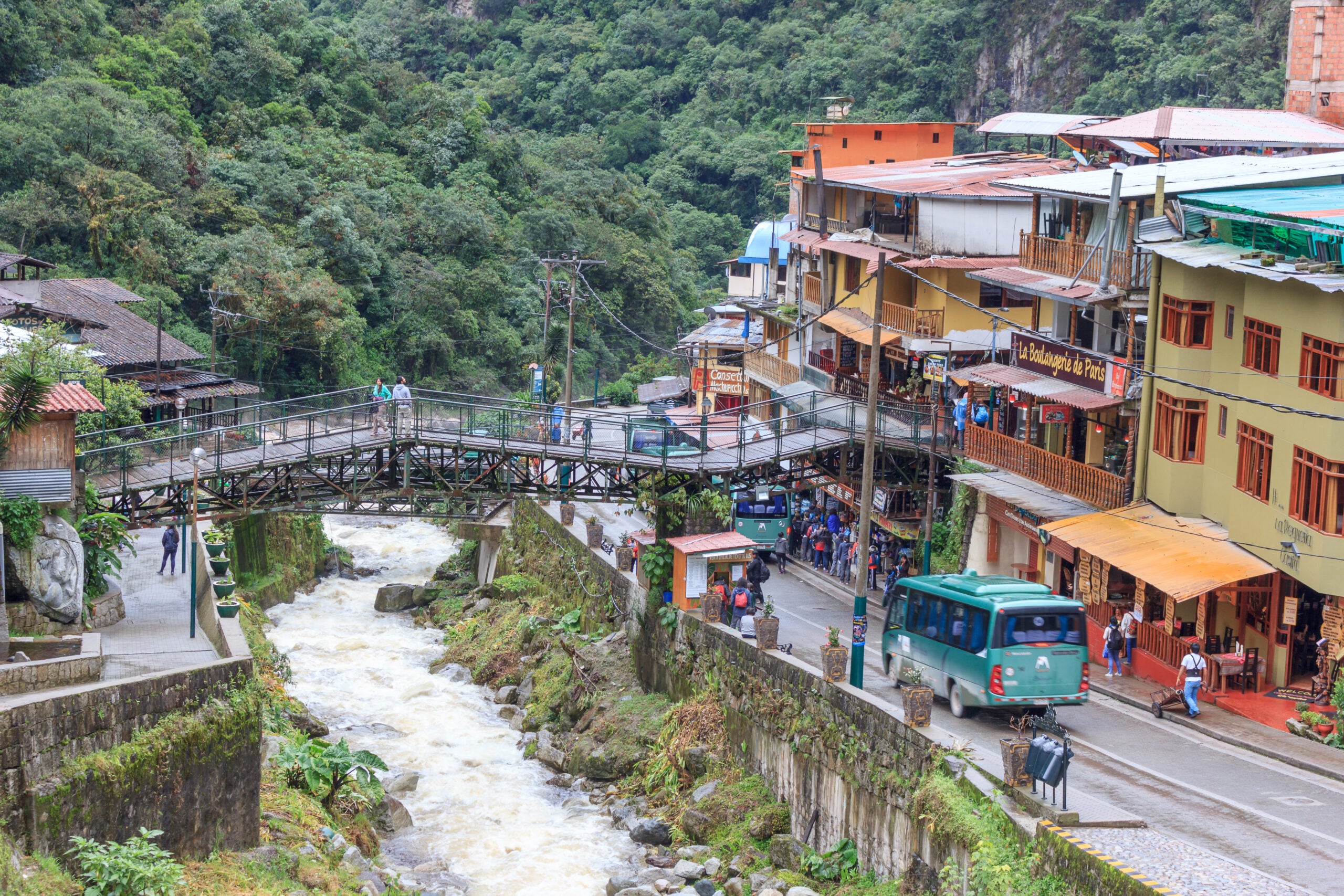
By this point, you're so close, yet so far. Aguas Calientes is the gateway to Machu Picchu, but you are not at the ruins just yet. You still have to make the vertical ascent to the citadel itself, which is a grueling trek that will take you about 4,000 feet uphill.
Anyone planning to hike Huayna Picchu or Machu Picchu Mountain may not want to embark on this walk, as it can be exhausting (though you can always walk back down, which is easier). If you do want to walk, follow the Camino Peatonal Trail. Leave early since this walk will take you a few hours to complete.
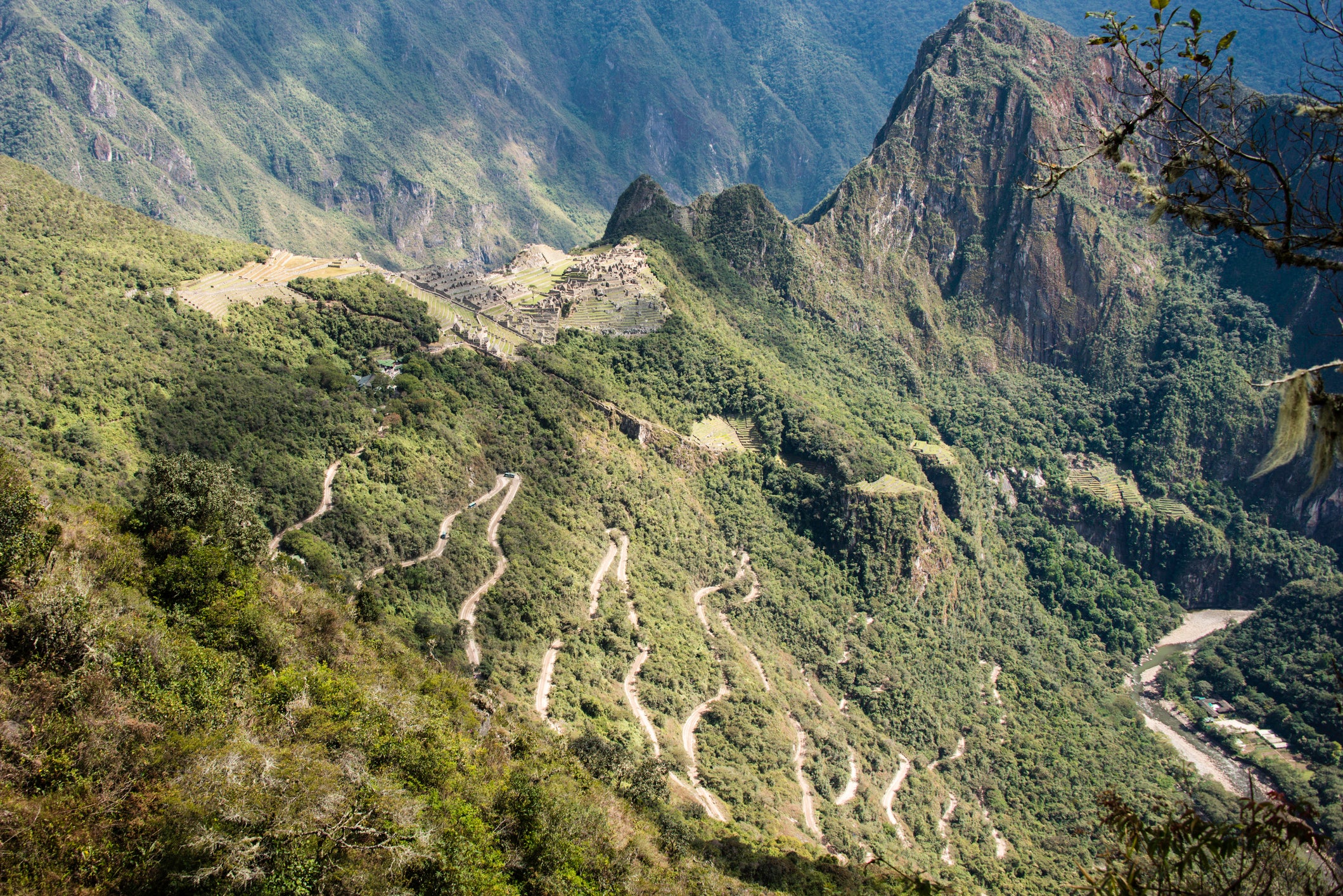
An alternative way to reach Machu Picchu is to take the bus. Buses leave every 10 to 15 minutes from Aguas Calientes, starting at 5:30 a.m. and running until 3:30 p.m. Keep in mind that people line up to catch the first bus, so it's best to arrive at the bus stop early. The ride up takes 20 to 30 minutes, and the last bus returns to Aguas Calientes at 5:30 p.m.
You can buy bus tickets in advance or on the day of your visit starting at 5 a.m. Bus tickets cost $12 per one-way ride or $24 round trip. Buy your tickets at the bus station in Aguas Calientes or another certified spot in Cusco or Aguas Calientes. Some agencies can help you book them online ahead of time, too, though you'll need to pay an additional fee. If you've booked your Machu Picchu tickets through a tour agency, ask about bus tickets, as some will include them.
Remember that you can always book your own Machu Picchu tickets online through the official website . Don't forget to also bring your passport. You'll need to show it to enter the ruins.
Bottom line
If it seems like Machu Picchu is hard to get to, you're right. The process requires several steps thanks to its remote location atop a mountain.
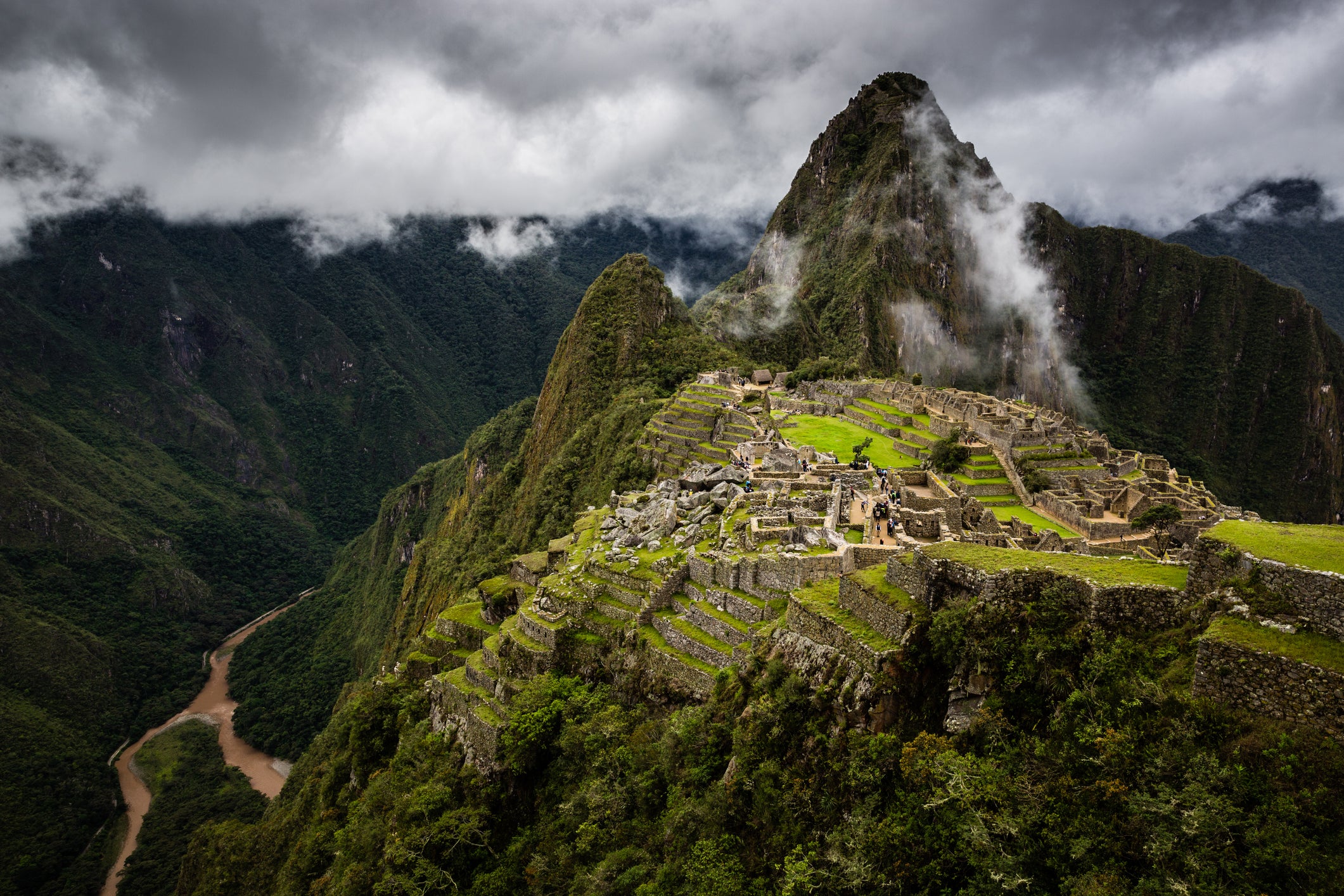
Know, though, that you don't have to do the trip all in one go. Take a few days in Lima, some time in Cusco and the Sacred Valley, and even a couple of nights in Aguas Calientes to prepare for your trek. Or, consider staying put in one of these destinations after your Machu Picchu adventure to unwind.
Peru is a magical place to explore with many unique attractions beyond Machu Picchu, so taking your trip slow and discovering other highlights can make the long journey worth it.

The Best Time to Visit Machu Picchu, Peru
By Author Arakita Rimbayana
Posted on Last updated: 6th October 2023
The Lost City of the Incas, aka Machu Picchu, draws some 1.2 million visitors yearly to its incredible stone vestiges left behind on a remote mountain.
With visitor numbers still down on those registered pre-pandemic, now remains a brilliant time to head to the former Inca citadel located in the south of Peru.
However, weather concerns can affect your experience, which is why this article aims to help you identify the best time to visit Machu Picchu.
If I’m being honest, there’s a reason why the Peruvian Highlands are so lush and green – which is why there’s always a risk that it’s going to rain when you’re hiking to or just visiting this incredible archeological site.
But you shouldn’t let that put you! Not only does the city look much more atmospheric with a bit of cloud cover, but the weather can change quickly, meaning you’re still very likely to get a glimpse of it from the famed photography location (see the picture below).

Here are my general recommendations for the weather conditions you need to consider when planning a trip to Machu Picchu.
Click to navigate this article:
- January: This is the peak of the rainy season in Peru. Trails to Machu Picchu are wet, the air is humid and the chance of more rain is high, making it challenging to hike the Inca trail and the other routes to Machu Picchu. If you don’t mind hiking in the rain – and missing out on the views – then be our guest; alternatively, opt for the train from Ollantaytambo or Cusco to Aguas Calientes, instead.
- February: This is the wettest month of all and, as a result, the Inca trail is closed due to unsafe weather conditions and for maintenance along the path. This is definitely not the best time to visit Machu Picchu, but if you must, alternative treks, such as the Salkantay , are still open.
- March: As precipitation levels lower and the Inca trail is reopened after the maintenance break, March can be a great choice for visiting Machu Picchu – although you can still expect to get a little wet during hikes. Bring a waterproof outer shell and plenty of layers to respond to the unpredictable temperatures and weather conditions you’re likely to face.
- April: As the rainy season draws to a close, Machu Picchu remains quiet before the rush of tourists arrives later in the year. This makes April the best month to visit Machu Picchu, with the weather mostly dry but with the occasional light showers.
- May and June: As the dry season arrives, so do the visitors! Events such as Inti Raymi, the traditional ceremony of the Inca Empire, fall in June and add to the melee. Though it’s still not yet high season, if you visit Machu Picchu in May or June, you should expect large crowds at the archeological site, especially in the morning. That said, good weather makes these months a great time for hiking the Inca trail .
- July and August: The peak of the dry season is also the high season for visitors to Machu Picchu. Expect to queue to get on the bus from Aguas Calientes up to the site and through the main gate at Machu Picchu, as well as take turns at the best photo spots. If you have no other option than visiting Machu Picchu during the high season then we suggest either arriving at the site as early as possible or in the afternoon.
- September: The dry season is coming to an end, making this the tail end of the high season for visitors, although numbers are lower than in the preceding two months.
- October and November: Alongside April, October and November are the best months to visit Machu Picchu. Even though the wet season is near, you can expect more sunny days than rainy ones. October is usually busier than November due to the fact that there’s less rain and so you’ll have a better chance of avoiding downpours.
- December: As the average rainfall picks up, the number of visitors drops to almost half that of the previous few months. Expect dense fog in the early mornings and showers in the afternoon, making the weather conditions less than ideal. However, there is still the possibility of clear skies during breaks in the rain.
Planning Your Trip to Peru?
Save time, stress & money with a customized travel itinerary planned for you by a Peru expert
What previous clients have said:
Going to a new and exciting place is an adventure AND has its challenges. Being able to carve out an in-depth plan with someone that has been there and whom you can trust was extremely helpful. We felt comfortable embarking on a six-week backpacking trip with kids ages 8 and 11 with Steph on our team. Her expertise and ability to hear what we wanted gave us a great jumping point for planning. Her advice and wide array of options also allowed us to be flexible. It also gave us peace of mind knowing that we had someone we could call if our plans went awry. Every one of Steph’s recommendations panned out to be incredible pieces of our trips and we would highly recommend her!
What you need to know about visiting Machu Picchu
While the weather is a crucial factor in influencing when you should visit Machu Picchu, you should also consider the following:
- Since its reopening after the Covid-19 lockdowns, the Peruvian government has been limiting the number of visitors to Machu Picchu. Compared with pre-pandemic visitor numbers of 5,940 per day, only 5,044 people are now allowed to enter the site . As a result, it’s often necessary to purchase your Machu Picchu ticket months – sometimes up to nine – in advance. You can check ticket availability on Machu Picchu’s official website .
- Each ticket comes with a one-hour time window of entrance; 6 to 7 am is the earliest and 2 to 3 pm is the latest. You may not enter outside of your ticket’s entrance time. Arriving late means your ticket is forfeited.
- Once purchased, tickets to Machu Picchu cannot be rescheduled or refunded.
- Accommodation rates during the peak season are significantly higher than in the low season. Read our guide to the best accommodation in Cusco for some ideas of where to stay.
- Curious about the cost of visiting? Read our guide to how much it costs to go to Machu Picchu .
Which seasons offer the best weather conditions for Machu Picchu?
Weather conditions can make or break your experience of visiting Machu Picchu. For that iconic view of Machu Picchu with the towering Huayna Picchu and Machu Picchu mountains above and clear blue skies as a backdrop, visiting on sunny days is a must.
Heavy mist in the morning or afternoon can be as bad as heavy downpours, as both cause low visibility. As a result, you can forget the view: even seeing ten metres ahead can be a challenge.
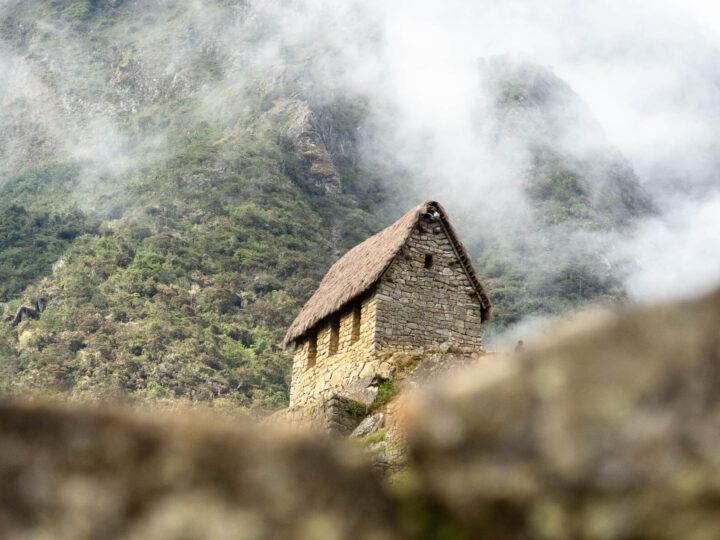
But to understand when are the best weather conditions for Machu Picchu, you must first understand the weather in Peru. While Lima may see only sunny days for weeks, Aguas Calientes – the closest town to Machu Picchu – may be inundated with rain. The weather varies considerably across Peru because of the terrain and ecosystems around this vast country and the impact of both the rainy and the dry seasons.
Machu Picchu weather by season
- December to March (rainy season)
At the Inca site, the average temperature ranges between 12 and 24°C (54-75°F). You can expect showers mostly in the afternoon. Though there is no certainty which months will experience the heaviest downpours, February has the highest precipitation level on average.
Due to safety reasons and for maintenance, the Inca trail is closed during February, while other treks (such as the Salkantay and the Lares) are at their wettest during this month. Trails in Machu Picchu itself can be dangerous during the rainy season, especially those leading up to Huayna Picchu Mountain.
Want a cheeky 5% discount on the Inca trail?
Alpaca Expeditions are not only one of the most sustainable companies offering Inca trail treks to Machu Picchu, but their guides, porters and chefs are the ultimate hosts.
They’re now offering Worldly Adventurer readers a 5% discount on all of their hikes – just mention Worldly Adventurer when you enquire!
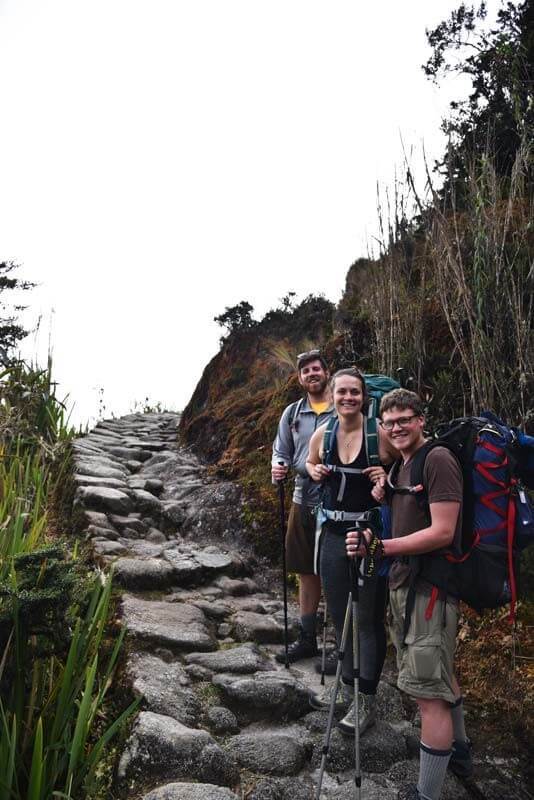
- May to September (dry season)
The average temperature ranges between 17 and 19°C (62-66°F), making these the coldest months at Machu Picchu. Unlike most tropical areas, Peru and, specifically, Machu Picchu is colder during the dry season, but you’re less likely to experience an overcast day.
As the precipitation of the rainy season has turned the landscapes lush green, the dry season offers the best views and the most photogenic conditions.
It is, for this reason, the peak season for tourism falls during July and August, which also coincides with summer vacations in the northern hemisphere.
- April, October, and November (shoulder season)
The rainy season ends in April, although rain showers are still likely during this month. It’s better to visit during the last month of dry weather (October) before the rainy season starts.
However, it’s worth remembering that even though the shoulder seasons are supposed to be dry, the weather remains a little unpredictable, with occasional downpours (but more sunshine!).
As a result, the best time of year to visit Machu Picchu according to the weather and the possibility of clear views of the archeological site is from June to July.
However, this settled, dry weather attracts the most crowds. Trekking to Machu Picchu – and most parts of the Andes mountains generally – is extremely popular during these months.
To learn more about the weather in Peru and when to visit, read our article about the best time to visit Peru .
Which months are better for avoiding crowds at Machu Picchu?
Though it’s open every day, Machu Picchu’s busyness should also influence when you choose to visit. Large crowds mean more queueing time at the entrance and more effort to get unobstructed views of the site itself.
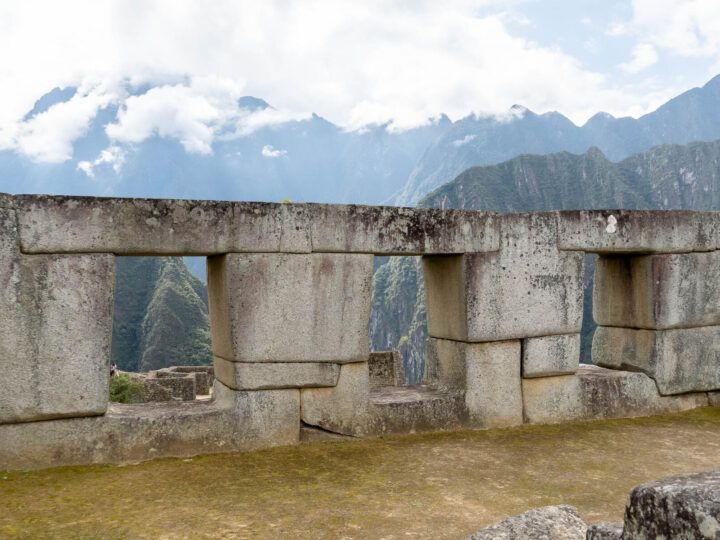
The low season – from December to March – means fewer crowds but possibly very wet weather conditions. That said, there may be one sunny day between weeks of rainy days, just like there may be a little rain during the dry season.
But it’s a big gamble since you cannot reschedule or refund your Machu Picchu tickets.
Here are the rough estimations of average daily visitors based on the number of tickets sold in 2018 , before the pandemic hit. August received the most visitors, with more than 4,800, and December was the least, with 1,900.
As you can see, even during low season, Machu Picchu still attracts many people. This should come as no surprise, considering it’s one of the things you must see in Peru’s Sacred Valley .
Daily average Machu Picchu tickets sold in 2018
- January ± 2,800 visitors per day
- February ± 2,400 visitors per day
- March ± 2,800 visitors per day
- April ± 3,200 visitors per day
- May ± 3,700 visitors per day
- June ± 3,600 visitors per day
- July ± 4,500 visitors per day
- August ± 4,800 visitors per day
- September ± 4,200 visitors per day
- October ± 4,000 visitors per day
- November ± 3,200 visitors per day
- December ± 1,900 visitors per day
So, when is the best time to visit Machu Picchu?
Considering weather conditions and crowds, the shoulder season is the ideal time for exploring the Inca citadel. The months of April, October, and November provide the opportunity to avoid the worst of the weather and the majority of other tourists.
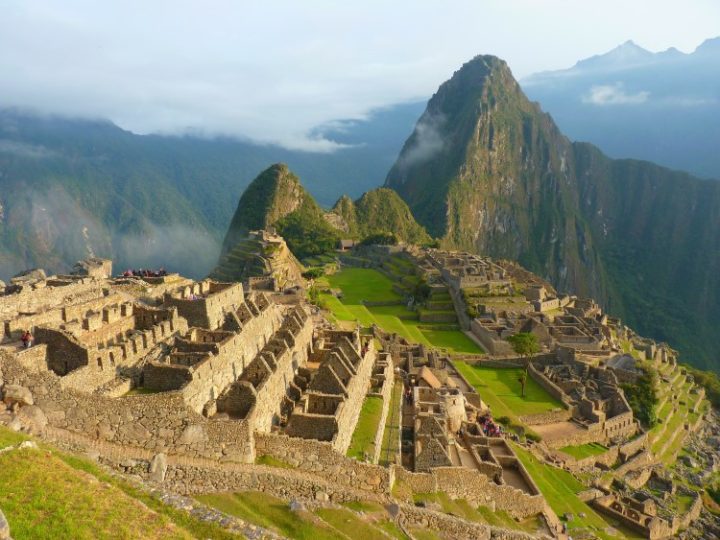
During these shoulder months, you’ll have quieter treks, as crowds are a fraction of what they are in high season. Keep in mind that even on sunny days, you can expect cold nights where the temperatures may drop below freezing.
Pack extra warm clothes and layers for your time hiking the Inca trail or the Salkantay and staying in Cusco and the wider Andes.
The best time of the year to visit is one thing, but choosing the best time of day is another. Among the nine available time slots, five are in the morning. Which of those is the one to choose?
The answer depends on how you plan on arriving: on a train from Ollantaytambo or Cusco or on foot through the hiking trails. Those interested in the former should check our recommendations about the best hotels in the Sacred Valley and, if you’re a fan of the ultimate comfort, the best luxury hotels across Peru .
If you’re taking the train to Machu Picchu
Even in low season, you’ll still be among hundreds (or even thousands) of people visiting the Inca citadel. So there may still be long lines, especially when waiting for the bus to and from the site. The most popular time is early morning, especially between 8 to 11 am.
So, if you want to avoid the busiest time, opt to go in the afternoon (12 to 1 pm, 1 to 2 pm, or 2 to 3 pm time slots).
Alternatively, you can also try to be the first one to arrive before the gate opens for the first time slot (6 to 7 am). Beat the crowds by getting on the earliest bus to Machu Picchu from Aguas Calientes; this departs at 5:30 am from Avenida Hermanos Ayar , right by the river.
Going that early in the morning means spending at least one night in Aguas Calientes (Machu Picchu pueblo) itself.
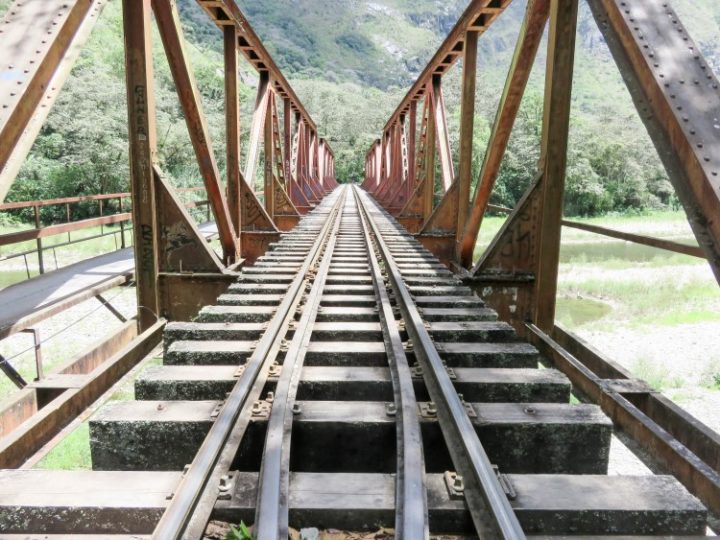
I booked my bus ticket weeks before my visit to secure my seat on that first bus. I noticed those who purchased theirs on-site had to wait for the following bus, even if they’d probably aimed for the first bus. Therefore, it’s best to book your bus tickets in advance (you can do it here ).
Another way to ensure you’ll be the first in line when the gates to Machu Picchu open is to hike from Aguas Calientes instead of taking the bus. The catch is that you will need to start early, as the hike may take around one to two hours, depending on your fitness level – and it’s all uphill.
Insider tip: You can also use these tips during the busiest months to minimize the queues – although be aware that many visitors will try to do the same. Even if you ride the earliest bus, those who hike from Aguas Calientes may get there before you.
For those hiking the Inca trail
The most adventurous trek is the Inca Trail to reach Machu Picchu . Not only is it an excellent challenge, but allows you to relive the pilgrimages undertaken by the Inca themselves.
While the Inca built many trails throughout the Peruvian Andes, the route to Machu Picchu is a part of the Qhapaq Ñan (“Royal Road”) used exclusively by Inca royalty and pilgrims.
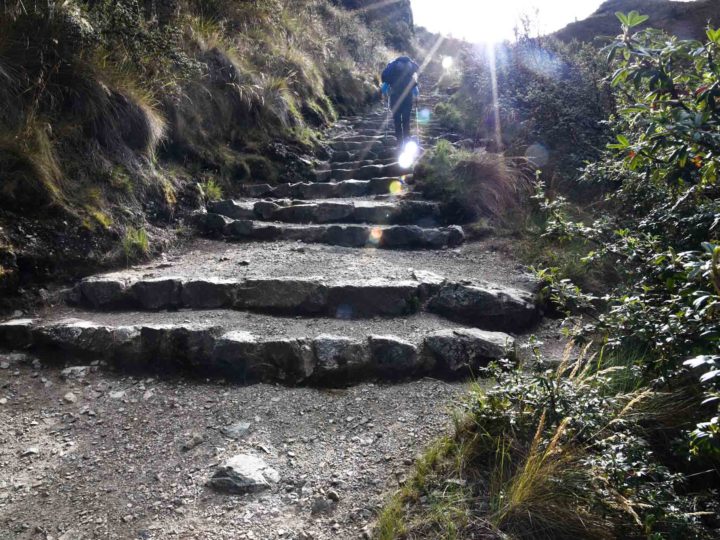
Regardless of when you trek, the end of this four-day hike is the arrival at the Sun Gate in Machu Picchu, with most reaching here at 6am to see the sunrise. If you’re a slower hiker, you may struggle to do this, however.
If you’re still keen to avoid large crowds, visiting during low or shoulder season will give you a better chance of achieving this.
Much like your ticket to Machu Picchu, your Inca trail permits must be purchased months in advance. I highly recommend trekking with the locally-owned company Alpaca Expeditions . They were brilliant when I visited Machu Picchu and they also work really hard to support indigenous communities across Cusco.

Essential Guide to Machu Picchu Hikes and Historical Sites
Exploring Machu Picchu is a dream for many travelers, and it’s easy to see why. Nestled high in the Andes Mountains, this ancient Incan city offers breathtaking views and a rich history that captivates all who visit.
Whether you’re a history enthusiast or an adventure seeker, there’s just something about hiking through the ruins and uncovering the secrets of the United Nations Educational, Scientific and Cultural Organization (UNESCO) World Heritage site.
In this article, you’ll explore the best hikes and historical spots in Machu Picchu. Dig in to make the most of your trip!
Choosing the Right Hiking Trail
Machu Picchu is one of the best hiking destinations to consider for your next adventure. There are several ways to experience it, but the journey is just as exciting as the destination.
For many, the hikes leading to the ruins are the highlight of the trip. Each Machu Picchu hike offers its own challenges, rewards, and unique views of the surrounding mountains and valleys.
Here are some of the popular hiking trails to Machu Picchu:
Inca Trail
The Inca Trail is by far the most famous and popular hike to Machu Picchu. This 26-mile (42-kilometer) trek takes about four days to complete. It leads hikers through beautiful landscapes, cloud forests, and Incan archaeological sites.
The trail follows ancient paths that the Incans themselves once walked. It’s the only trek that leads directly to the Sun Gate (Inti Punku), offering hikers a stunning first view of Machu Picchu at sunrise. However, make sure you book several months in advance if you plan on taking this route, as permits for the Inca Trail are limited.
Salkantay Trek
If you’re looking for a more off-the-beaten-path experience, the Salkantay Trek is a fantastic alternative to the Inca Trail. It’s longer, typically taking five to six days, and covers approximately 46 miles (74 kilometres).
The hike takes you through diverse ecosystems, from lush tropical forests to snowy mountain passes, with incredible views of the Salkantay mountain peak. While it doesn’t lead directly to the Sun Gate, it offers a different but equally rewarding perspective of the region.
Lares Trek
The Lares Trek is another excellent option for those seeking a more cultural and less crowded experience. This three—to four-day trek takes you through traditional Andean villages, where you can witness local customs, interact with the Quechua-speaking people, and see how they live in the highlands.
The Lares Trek is less strenuous than the Inca or Salkantay treks, making it a good option for travelers looking for a less intensive hike. The route continues beyond Machu Picchu itself, but most tours include a train ride to Aguas Calientes, followed by a visit to the ruins.
The Inca Jungle Trek
For the adventurous at heart, the Inca Jungle Trek offers a unique and thrilling way to reach Machu Picchu. This four-day trek combines hiking, biking, and even white-water rafting and zip-lining. It’s an exciting and varied route that allows travelers to experience the jungle, mountains, and rivers of the region.
The trek ends with a visit to Machu Picchu, and while it’s not the traditional route, it’s perfect for those looking for a fun and dynamic Machu Picchu tour.
Huayna Picchu
Huayan Picchu is the towering mountain you see in the background of the most iconic photos of Mach Picchu. Hiking to the top of Huayan Picchu provides a bird’s eye view of the Citadel and the surrounding valleys.
This steep and narrow hike takes about two hours to go on a round trip, but the effort is well worth it for the panoramic views. However, permits for Huayna Picchu are also limited and sell out quickly, so be sure to book in advance.
Machu Picchu Mountain
If you’re looking for another breathtaking view, consider climbing up Machu Picchu Mountain. It’s the larger peak on the opposite side of the Citadel. This hike is longer and less crowded than Huayna Picchu, which takes about three to four hours on a round trip.
The views from the summit are spectacular, offering a sweeping vista of the ruins and the Andes Mountains. But like Huayna Picchu, you’ll need permits and to book ahead.
No matter which trail you choose, each offers a unique and rewarding way to experience Machu Picchu’s stunning landscapes and rich history. Remember to plan early and book in advance to get the Machu Picchu tickets.
Visiting Machu Picchu Historical Sites

Once you arrive at Machu Picchu, there’s plenty to explore within the ancient Citadel itself. This UNESCO World Heritage site is a testament to the architectural and engineering brilliance of the Incas. Here are some of the most significant historical sites you’ll want to explore:
The Sun Gate (Inti Punku)
The Sun Gate is the traditional Machu Picchu entrance for those hiking the Inca Trail. It offers an awe-inspiring panoramic view of the ruins, especially at sunrise, when the sun’s first rays light up the ancient city. Even if you didn’t hike the trail, you can walk to the Sun Gate from Machu Picchu in about an hour to get a stunning view of the ruins.
The Temple of the Sun
One of the most sacred sites within Machu Picchu, the Temple of the Sun, was used for astronomical and religious ceremonies. Its unique curved walls and finely crafted stonework demonstrate the Incas’ skill in construction. The temple was built to honor Inti, the Sun God, and on the summer solstice, sunlight aligns perfectly with the temple’s windows, showcasing the Inca’s astronomical knowledge.
The Intihuatana Stone
The Intihuatana Stone is another vital spiritual and astronomical site within Machu Picchu. This carved rock pillar is believed to have been used as a sundial, allowing the Incas to measure time and mark crucial celestial events. It’s often referred to as the “Hitching Post of the Sun,” symbolizing the Incas’ attempt to harness and control the power of the sun.
The Sacred Plaza
The Scared Plzza is the heart of Machu Picchu, surrounded by some of the most critical structures in the city. Here, you’ll find the Main Temple of the Three Windows and the House of the High Priest. This central gathering space was likely used for religious ceremonies, political events, and other communal activities.
The Room of the Three Windows
The Temple of the Three Windows is part of the Scared Plaza and is named for its three large, trapezoidal windows that overlook the valley below. These windows are thought to represent the three realms of Inca mythology: the underworld, the earthly world, and the heavens. The temple’s construction is another example of the precision and skill of Inca masonry.
Exploring these historical sites within Machu Picchu offers a deeper understanding of the Inca civilization’s brilliance and spiritual beliefs. Each structure provides a glimpse into their advanced knowledge and rich culture, making your visit a truly unforgettable experience.
Conclusion
Exploring Machu Picchu is a journey that offers both adventure and a deep dive into history. Regardless of the hiking trail you choose, each path brings its own rewards. Along the way, you’ll encounter breathtaking views, ancient ruins, and an appreciation for the remarkable achievements of the Inca civilization. Not to mention the historical sites within the Citadel, which provide a fascinating glimpse into the ingenuity and spiritual significance of this ancient city. No matter which hike or historical site you explore, Machu Picchu promises to leave you awe-inspired and enriched by its enduring mystery and majesty.
Related Posts

6 Epic Tourist Attractions in Peru
This page may contain affiliate links. More info in our Privacy Policy One of the most diverse and exciting countries in South America, Peru is…
Read this article »

Visiting Machu Picchu for the First Time: Complete Travel Guide
This page may contain affiliate links. More info in our Privacy Policy If you’ve never heard of Machu Picchu, then you must have been living…

7 Essential Tips to Make Your Trip to Peru Memorable
This page may contain affiliate links. More info in our Privacy Policy Even if you are a seasoned traveler, you know that no amount of…
Leave a Comment Cancel Reply
Your email address will not be published. Required fields are marked *
This site uses Akismet to reduce spam. Learn how your comment data is processed .
Inca Trail to Machu Picchu 4 Days Group Tour - Rosmel
Machu Picchu
See more photos
- Email address verified
About this trip
The Classic Inca Trail to Machu Picchu is one of the world’s oldest pilgrimages and is consistently ranked among the ten best hikes on the planet. Over 4 days, you will be hiking an ancient trail that was lost together with Machu Picchu. Hike with the best tour operator of Inca, stay in the best campsites, and beat the crowds to all places.
DAY BY DAY SUMMARY
-Day 1: Cusco – Km 82– LLactapata – Ayapata (14km, 8hrs) -Day 2: Ayapata – Warmiwañuska - Runcuraccay – Chaquicocha (16km, 10 hrs) -Day 3: Chaquiccocha – Phuyupatamarca – Wiñaywayna (10km, 6hrs) -Day 4: Wiñaywayna – Machupicchu – Cusco (6km, 2 hrs)
Highlights of TreXperience
-Stay in the best and noncrowded campsites
-Enjoy our hot showers after a long day of the hike
-Learn and interact with our native Tour Guides and porters
-Come back to Cusco in the Panoramic Exclusive trains
-We promote gender equality and Women´s empowerment
-2% of the price you pay goes to support our Social Projects
What’s included
- Transportation All Included from begining to end
- Train Panoramic exclusive train
- Meals All Meals except Last day lunch
- Porters Persnal Porter for 7 kilos of pesonal stuff
- Camping equipment We provide: personal tents, dining, kitchen, and portable toilet tents
- Entrance fees Inca Trail & Machu Picchu
- Tour Guides Professional tour guides
- Meals Organic, Local, typical Peruvian dishes
- Porters Full local team of happy porters
What’s not included
- Extra hikes Huayna picchu
- Items Sleeping bags, Poles, or air mats
- Meals Last day lunch
- Tips to: Porters, chef, and guides
Available Packages
Students contact us to get a special discount!
Available options
Your organizer, photo gallery.
- Search Please fill out this field.
- Manage Your Subscription
- Give a Gift Subscription
- Newsletters
- Sweepstakes
24 Life-changing Trips Everyone Should Experience at Least Once
From African safaris to must-visit cities, these once-in-a-lifetime travel destinations will make you want to plan your next great adventure.
Elizabeth Rhodes is a special projects editor at Travel + Leisure , covering everything from luxury hotels to theme parks to must-pack travel products. Originally from South Carolina, Elizabeth moved to New York City from London, where she started her career as a travel blogger and writer.
:max_bytes(150000):strip_icc():format(webp)/elizabeth-rhodes-25083778bc654f69b30ce8417affc82c.jpg)
What's next on your travel list? With so many places worth traveling to, it can be hard to narrow down your top spots to visit.
Sometimes, it's the famous attractions, delicious food, and stunning hotels that draw us to a certain destination, and other times, it's the bragging rights that come with checking off every continent, country, or state. Whatever your motivation, we've rounded up 24 incredible trips, complete with once-in-a-lifetime experiences and iconic sights you won't find anywhere else in the world.
So, what makes a trip truly life-changing? That answer varies from traveler to traveler, but one thing is for sure: From African safaris to classic road trips, this list will make you want to plan your next great adventure.
alexisassa/Getty Images
Deciding between the historic cities of Rome, Venice, Naples, and Florence for the top destination to visit in Italy feels impossible, so the entire country deserves a spot on your list. Start in the Eternal City and head north through the rolling hills of Tuscany to visit Florence, followed by Milan or Venice, or go south to the beaches of the beautiful Amalfi Coast and Sicily.
New York, New York
Visiting the Statue of Liberty , standing at the top of the Empire State Building, walking across the Brooklyn Bridge: These are just a few of the things you can only do in New York City. Whether you dream of visiting all the places you've seen on screen, catching a Broadway show, or eating your way through the city's diverse neighborhoods, there's no doubt that NYC deserves a spot on your list.
Tokyo, Japan
Old and new come together in Japan's bustling capital city. Historic temples and shrines, busy shopping districts, delicious food, a huge music scene, and some of the world's best theme parks and attractions — whatever your interests, there's something for you in Tokyo .
Paris, France
From watching the Eiffel Tower sparkle and viewing famous works of art at world-renowned museums to eating delicious French pastries, there are innumerable reasons that Paris deserves a spot on your list. Of course, other dreamy French destinations like Mont-Saint-Michel, Chamonix, and the Riviera are well worth a visit, too.
Busy medinas, intricate architecture, and a unique combination of cultural influences make Morocco unlike anywhere else on the planet. Whether you're traveling to bustling Marrakesh, pretty coastal towns, or remote desert towns (or hopefully, all three), a trip to Morocco is bound to be one to remember.
Monica Farber/Travel + Leisure
From the whitewashed homes of Santorini to the Ios party scene to the relaxing atmosphere of Milos, there's a perfect Greek Island for every type of traveler. Island hopping gives you the chance to experience more of what the country has to offer, but plan to spend a couple of days in Athens at the beginning and/or end of your trip.
Machu Picchu
Rory Fuller/Travel + Leisure
Seeing the historic ruins of the Incan Empire set among the breathtaking Andes at Machu Picchu is an undeniably life-changing experience. The stunning citadel ruins of Machu Picchu are worth the journey — and for some travelers, that trip, often taken by train or on foot as a multi-day trek, is a big part of the experience.
African Safari
Seeing majestic animals like lions, elephants, and rhinos in the wild is a dream best accomplished with an African safari . South Africa, Tanzania, Uganda, and Kenya are among the most popular safari destinations — and in each of those countries, you'll find incredible lodges and tour operators who can help you spot these creatures in their natural habitat.
fmajor / iStock / Getty Images Plus
Whether you dream of cruising down the famed Nile River, seeing the Pyramids of Giza , or visiting the ancient Valley of the Kings, Egypt's historic wonders make the destination unlike any other (and worthy of a spot on your travel list).
The Maldives
Unlike many of the action-packed trips on this list, the Maldives is synonymous with relaxation, luxury, and romance. A stay in an overwater bungalow set atop turquoise blue waters is the ultimate getaway that's worth the long-haul flight and oftentimes pricey accommodations.
Antarctica Cruise
Hoping to visit all seven continents? Cross Antarctica off your list with a cruise. Several major cruise lines have journeys to Antarctica, offering incredible views of the ice and wildlife from the comfort and safety of a ship. Travelers typically fly in and out of Buenos Aires en route to Ushuaia (where most cruises depart from); we recommend spending a few days in the fascinating Argentine city before your expedition.
Irjaliina Paavonpera/Travel + Leisure
Dubbed one of the natural wonders of the world, the Great Barrier Reef is a can't-miss for many wildlife lovers. Of course, Australia's gorgeous coastline, the iconic Sydney Opera House, and fuzzy creatures like kangaroos and koalas are also reasons to head to the destination. Fly into Sydney and spend a few days there before heading out to explore more of this expansive country teeming with natural beauty.
Galapagos Islands
Incredible and diverse plant and animal species make the Galapagos Islands another must-visit for nature-loving travelers. This stunning archipelago off the coast of Ecuador is best explored by cruise, so you can take in as many breathtaking landscapes and animals as possible during your trip.
Like the other countries on this list, India has countless destinations worth exploring, but one of the most famous attractions that travelers dream of seeing for themselves is the Taj Mahal. This 17th-century white marble mausoleum has drawn visitors to Agra for years. Luxury travelers might consider a train trip aboard the Maharajas' Express (with a stop at the Taj Mahal) as the ultimate experience. Travelers planning to visit the Taj Mahal or take the luxurious train ride will want to fly into Delhi, India's capital territory.
Petra, Jordan
Astalor / Getty Images
The stunning ancient city of Petra is made up of several impressive structures carved into sandstone rock faces, including the famous Al-Khazneh. The city dates back thousands of years, making this UNESCO World Heritage Site a must-visit for history buffs.
The Himalayas
Passing through India, Pakistan, Afghanistan, China, Bhutan, and Nepal, the Himalayas are home to some of the world's highest peaks — and that means breathtaking mountain views, too. For adventurous and active travelers, trekking to Everest Base Camp is a once-in-a-lifetime experience.
American National Park Road Trip
The classic American road trip is a mainstay on many travelers' lists — and for good reason. The country's incredible national parks , including Grand Canyon, Yellowstone, and Yosemite, are best explored on road trips with stops at charming small towns and kitschy roadside attractions.
Great Wall of China
aphotostory/Getty Images
Stretching across China for thousands of miles, with sections dating back nearly 2,000 years, the Great Wall is regarded as one of the New Seven Wonders of the World . Visitors can hike along parts of the wall — some areas are located within driving distance of Beijing, so it's a perfect day trip from the city.
Easter Island
The hundreds of monolithic moai statues have drawn curious visitors to Easter Island for years. This remote Polynesian island is worth the lengthy trip for travelers hoping to see these impressive human figures while also soaking in some incredible coastal views.
Northern Lights Trip
Catching a glimpse of the elusive northern lights is possible in several destinations close to the Arctic Circle, including Alaska, Iceland, Canada, Greenland, Finland, Sweden, and Norway. All of these places have incredible viewpoints (and even hotels where you can see the phenomenon from your bed ), in addition to great wintry scenery. (The lights are best viewed from late fall through early spring.)
Thailand and Vietnam
A trip through Southeast Asia is a must for any traveler, especially foodies who love street eats. While you could spend weeks in each of these countries, Thailand and Vietnam can easily be paired for an exciting trip packed with lush scenery, cultural experiences, and delicious food. Have a little extra time to spare? Add Cambodia to the mix and include a visit to expansive Angkor Wat.
Cappadocia, Turkey
benstevens/Getty Images
Many travelers dream of experiencing this UNESCO site from high above in a hot air balloon. From this vantage point, you can really take in the unique rocky topography, dotted with fairy chimneys and pillars, river valleys, and cliffs. Because the region in central Turkey can experience snowy winters, it's best to book your hot air experience between April and November.
One of the most sparsely populated countries, Namibia's beauty can be relished with sweeping views of desolate, other-worldly landscapes. The southwestern African country is home to (and named after) the world's oldest desert, the Namib Desert, and the coast is also where you can see some of the world's largest sand dunes and incredible views of the desert meeting the Atlantic Ocean.
Dubai, United Arab Emirates
With eye-catching architecture, enormous shopping centers, desert excursions, and plenty of beaches, Dubai offers diverse attractions for a wide array of travelers. The most temperate time to visit the hot city, which gets 300 days of sunshine, is from November to February, and winter is also when the Dubai Shopping Festival takes place.
Related Articles

What is the Best Time to Visit Machu Picchu? A Guide to Planning Your Trip

What is the best time to visit Machu Picchu? This is a crucial question for all travelers who dream of exploring this wonder of the world. Machu Picchu, located high in the Peruvian Andes, offers unique experiences throughout the year. However, weather conditions can vary considerably.
In this blog, we will help you decide when is the best time to plan your visit to Machu Picchu. We’ll take into account factors such as climate, the number of tourists, and local festivities.
Dry Season (May to September)
The best time to visit Machu Picchu is usually during the dry season, which runs from May to September. During these months, rainfall is scarce, which means clearer skies. Additionally, the conditions are better for exploring the citadel and its surroundings. This is the most popular time to visit, so it’s advisable to book tickets and accommodations in advance.
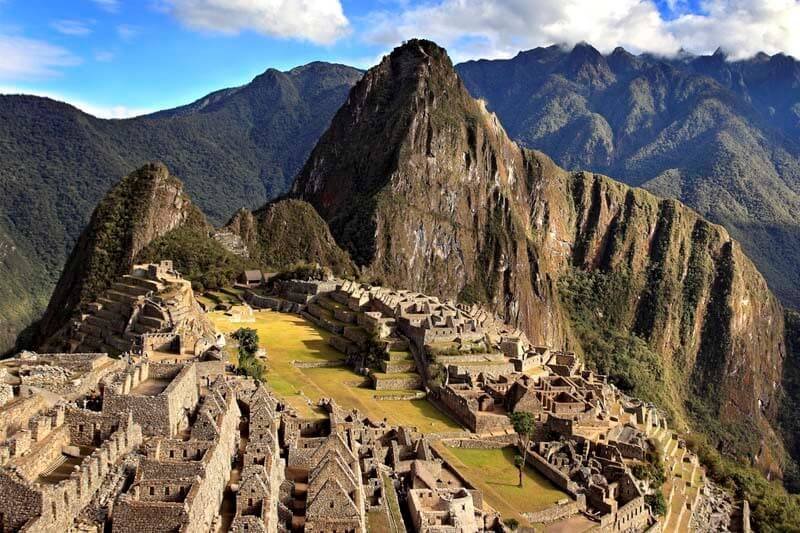
Advantages of the Dry Season:
- Stable Weather: Less chance of rain, allowing for spectacular views.
- Better Hiking Conditions: Trails like the Inca Trail are safer and more accessible.
- Photography: Clear skies and optimal natural light for photos.
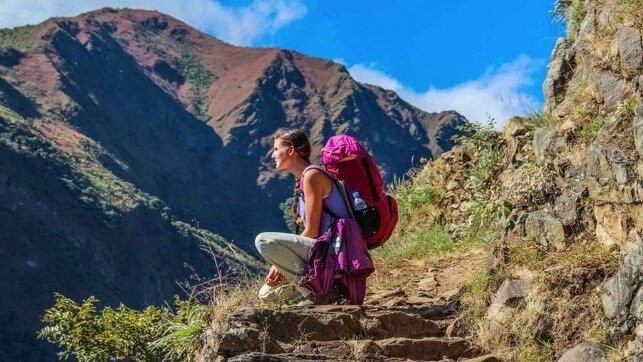
Rainy Season (November to March)
The rainy season in Machu Picchu lasts from November to March. Although the rains can be challenging, the citadel has its own charm under the mist. Additionally, the vegetation is more lush. During this time, there are fewer tourists, meaning a quieter experience and the opportunity to enjoy the site with more privacy.
Advantages of the Rainy Season:
- Fewer Crowds: Fewer tourists, allowing for a more relaxed visit.
- Discounts: It is often possible to find better prices on accommodation and tours.
- Green Landscapes: The vegetation is at its peak, providing a vibrant environment.
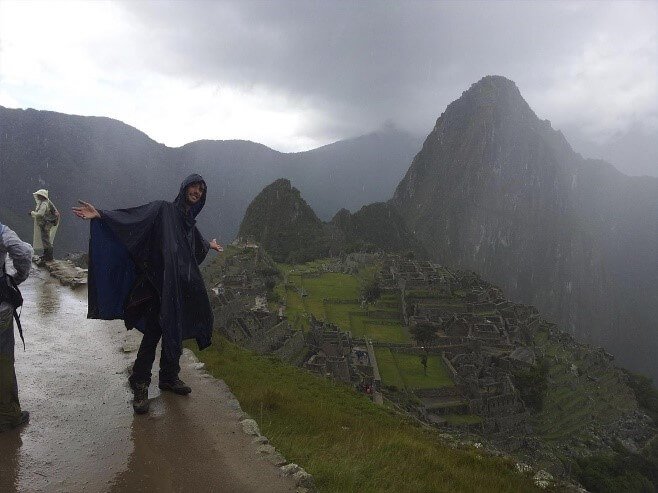
Transition Season (April and October)
April and October are transitional months between the dry and rainy seasons. During these periods, you can experience the best of both worlds. There is less rain than during the rainy season, but without the crowds of the dry season. These months are also ideal for those who want to combine their visit with other activities in Cusco and the Sacred Valley.
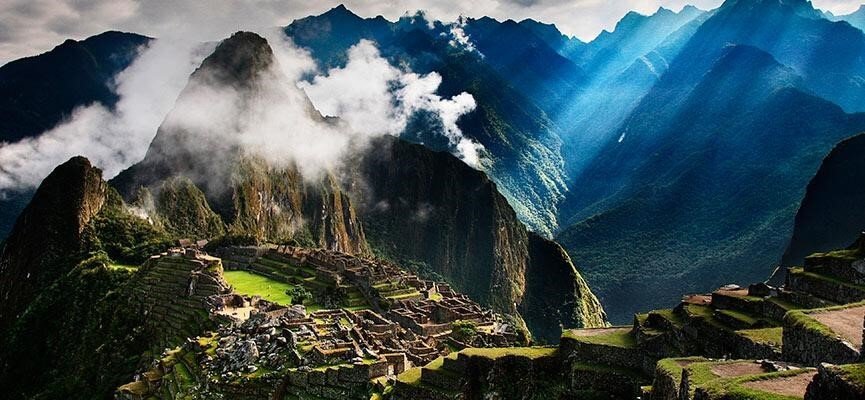
Advantages of the Transition Season:
- Mixed Weather: Possibility of enjoying good days with less rain.
- Moderate Tourism: A manageable number of tourists without the high-season crowds.
- Flexibility: Lower demand makes it easier to organize tours and activities.
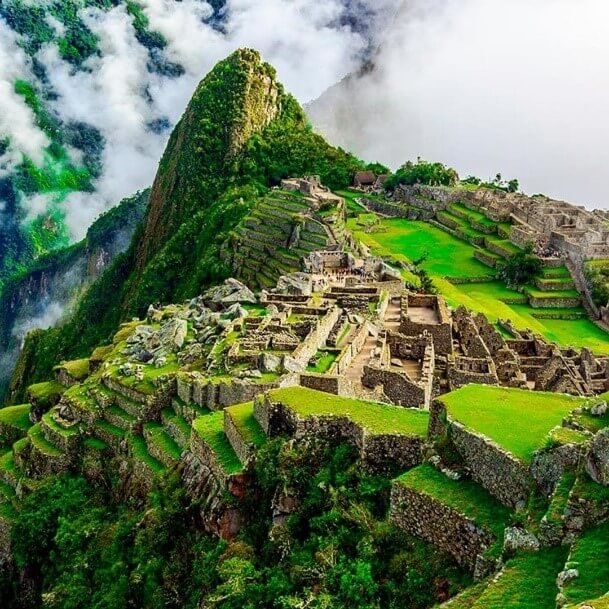
So, what is the best time to visit Machu Picchu? It depends on your personal preferences. If you prefer dry weather and don’t mind sharing the experience with more tourists, the dry season is your best option. If you seek tranquility and a greener landscape, the rainy season might be perfect for you. And if you want a balance between the two, consider visiting during the transition months.
Plan Your Visit with Lorenzo Expeditions
Regardless of the time you choose, Lorenzo Expeditions is here to help you plan your trip. With their experience and local knowledge, you can be sure you’ll have an unforgettable experience in Machu Picchu.
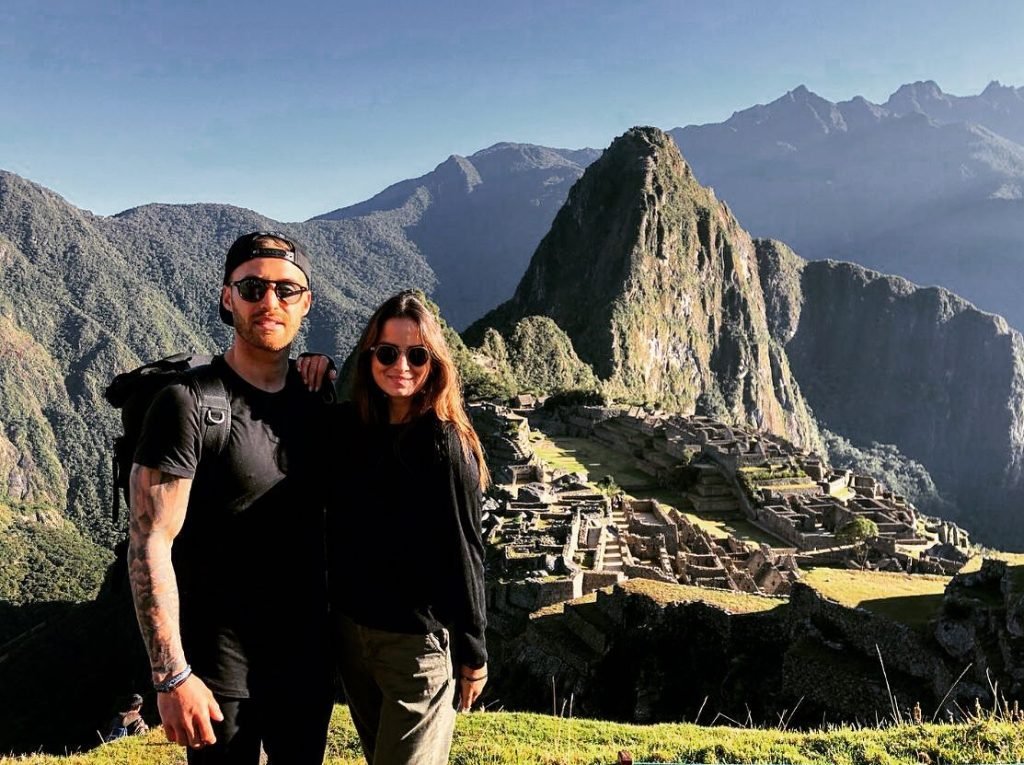
Ready to plan your visit? Click here to schedule your consultation with Lorenzo Expeditions and start organizing the trip of your dreams.
Related Posts

Best time to visit Rainbow Mountain Peru

Best company for Inca Jungle trek

Best Time to Visit Humantay Lake

Humantay Lake: How to get There
Leave a comment cancel reply.
Your email address will not be published. Required fields are marked *
Save my name, email, and website in this browser for the next time I comment.

IMAGES
COMMENTS
Learn the best time, way, and tips to visit the ancient Incan citadel of Machu Picchu in Peru. Find out how to get acclimated to the altitude, choose the right train, buy tickets, and explore nearby attractions.
16. Machu Picchu is high up, but much lower than Cusco. If you're worried about hiking around Machu Picchu due to the altitude, the good news is that it sits at a much lower elevation than Cusco. In fact it's lower than most of the Sacred Valley at just 2400m elevation.
Learn about the different options to visit Machu Picchu, one of the new seven wonders of the world, from Cusco. Compare prices, rules, routes, and tips for the Inca Trail, train, bus, and more.
Learn everything you need to know about visiting Machu Picchu, the ancient Inca city and New World Wonder. Find out how to get there, when to go, what to see, and more.
Learn about the history, attractions and tips for visiting the Inca citadel of Machu Picchu, the most famous archaeological site in Peru. Find out how to get there, when to go, what to see and do, and more from Lonely Planet experts.
Learn how to plan your trip to Machu Picchu, one of the world's most impressive ancient ruins. Find out how to buy tickets, get passport stamps, choose hikes and more.
Bus: We recommend taking the 30-minute bus ride to Machu Picchu as this is the quickest and most physically friendly way to get to the ruins. You will have more time to explore Machu Picchu, as well as do additional hikes around the site. Buses to Machu Picchu leave from 5:30AM to 3:30PM every 5-10 minutes.
A slightly longer hike, taking about an hour round-trip, is to the Sun Gate. At 2,720 m, this is the highest vantage point to view the ruins, and where trekkers from the Inca Trail first glimpse Machu Picchu. Beyond this is a 3-hour hike to the top of the actual peak, Cerro Machu Picchu (the name translates as "big mountain").
Machu Picchu, Peru. It's no wonder Machu Picchu is Peru's most-visited site. Dating to the mid-1400s, it's a marvel of mortar-free limestone architecture perched on a high plateau deep in the Amazonian jungle. Get there via train from Cusco or, if you're not faint-hearted, make the trip on foot via a multi-day hiking trail—you'll travel ...
The Lost City of Machu Picchu is one of the most iconic archeological treasures in all of South America. Tucked away in the cloud forests of the Andes, Machu Picchu is believed to have been a royal estate or sacred religious site for Inca leaders. Today, its mountain top location, finely crafted stonework, and ancient history make Machu Picchu ...
The easiest way to get from Cusco to Machu Picchu is by taking a train from the San Pedro, Wánchaq, or Poroy stations in Cusco to the Machu Picchu Pueblo Station in Aguas Calientes. It takes just under four hours. The main operators are PeruRail and Inka Rail, which offer a variety of luxury and budget options.
Learn about the history, architecture and biodiversity of Machu Picchu, the sacred Inca citadel in Peru. Find out how to get there by plane, train or trekking the Inca Trail.
There are only 4,500 tickets available per day for Machu Picchu. All tourists must be led by a tour guide in order to preserve the site. Tourist groups can have a maximum of 10 people per guide. Reentry to the site is prohibited. The guided tour duration is 2 hours in order to free up room for more groups.
What: Machu Picchu tours. When: Machu Picchu is accessible daily with entrances from 6 a.m. to noon or noon to 5:30 p.m. During the month of February, the Inca Trail is closed for maintenance and ...
Machu Picchu represents the ultimate testimony to ingenuity and spirit that was the Inca Civilization. Being part of the New Seven Wonders of the World, this place doesn't only offer great views but also time travel, ancient engineering, and spirituality all mixed into one. Whether one feels the pull of history, the challenge of the Inca ...
Machu Picchu is often busiest between 11am and 3pm when most train and bus visitors arrive, so the opportunity to see the site in the morning or at dusk could allow you to have a more meditative experience and better light for photography. Machu Picchu, the ancient capital of the Incas. It's best to visit Machu Picchu at dusk or dawn.
Learn how to plan your trip to Machu Picchu, the ancient Incan ruins in Peru. Find out the best time to visit, how to get there, what tickets to buy, and which treks to choose.
Machu Picchu is located in the high Andes mountain range, right in the middle of the Sacred Valley. The Valley at the same time borders the nearby Amazon Rainforest. If you travel about 80 kilometers east of Cusco, you will arrive at "Lost City of the Incas", built on the side of a mountain.
Choose your own route to Machu Picchu. There is no right or wrong way to get to Machu Picchu. On most of our trips, you can choose your own adventure with three incredible ways to travel through the Sacred Valley: the Inca Trail, the Quarry Trail and the train journey. That way, if hiking's not your thing, you can still retrace the steps of ...
After all, the ancient archaeological site is the most visited tourist attraction in the entire country, drawing more than a million travelers each year. The best time to visit Machu Picchu is May to June or September to October, when the weather is nice and crowds are thin, but the site is well worth a visit any time of the year.
An alternative way to reach Machu Picchu is to take the bus. Buses leave every 10 to 15 minutes from Aguas Calientes, starting at 5:30 a.m. and running until 3:30 p.m. Keep in mind that people line up to catch the first bus, so it's best to arrive at the bus stop early.
April: As the rainy season draws to a close, Machu Picchu remains quiet before the rush of tourists arrives later in the year. This makes April the best month to visit Machu Picchu, with the weather mostly dry but with the occasional light showers. May and June: As the dry season arrives, so do the visitors!
For many, the hikes leading to the ruins are the highlight of the trip. Each Machu Picchu hike offers its own challenges, rewards, and unique views of the surrounding mountains and valleys. Here are some of the popular hiking trails to Machu Picchu: Inca Trail . The Inca Trail is by far the most famous and popular hike to Machu Picchu.
Machu Picchu [a] is a 15th-century Inca citadel located in the Eastern Cordillera of southern Peru on a mountain ridge at 2,430 meters (7,970 ft). [9] Often referred to as the "Lost City of the Incas", [10] it is the most familiar icon of the Inca Empire.It is located in the Machupicchu District within Urubamba Province [11] above the Sacred Valley, which is 80 kilometers (50 mi) northwest of ...
The Classic Inca Trail to Machu Picchu is one of the world's oldest pilgrimages and is consistently ranked among the ten best hikes on the planet. Over 4 days, you will be hiking an ancient trail that was lost together with Machu Picchu. Hike with the best tour operator of Inca, stay in the best campsites, and beat the crowds to all places.
Round trip bus tickets from Aguas Calientes - Machu Picchu; 01 hotel night in Aguas Calientes; Professional team on all tours and treks; 24 hour assistance in Spanish and English; ... As one of the largest travel agencies in North America, we have a wealth of recommendations to share! Browse our articles and videos for inspiration, or dive ...
Discover natural and man-made wonders, from Ecuador to Peru, on a journey that includes a four-night cruise in the wildlife-rich Galápagos Islands, an exclusive visit to a village in the Sacred Valley and a guided exploration of Machu Picchu, the awe-inspiring "Lost City" of the Incas.
21 Life-changing Bucket List Trips Everyone Should ...
Machu Picchu, located high in the Peruvian Andes, offers unique experiences throughout the year. However, weather conditions can vary considerably. In this blog, we will help you decide when is the best time to plan your visit to Machu Picchu. We'll take into account factors such as climate, the number of tourists, and local festivities.
This 2021 aerial photo shows Machu Picchu in Peru. The popular travel destination is included in a new guide book for LGBTQ+ travelers, "Out in the World," by the couple behind The Nomadic Boys travel blog, Stefan Arestis and Sebastien Chaneac.